Transformational Change – Workshop 1 (About Transformation)

The Appleton Greene Corporate Training Program (CTP) for Transformational Change is provided by Ms. Ruta Certified Learning Provider (CLP). Program Specifications: Monthly cost USD$2,500.00; Monthly Workshops 6 hours; Monthly Support 4 hours; Program Duration 12 months; Program orders subject to ongoing availability.
If you would like to view the Client Information Hub (CIH) for this program, please Click Here
Learning Provider Profile

To be advised.
MOST Analysis
Mission Statement
Basic concepts and foundational pillars; what transformation is, what it isn’t, key phases and importance more than ever now to be proactive and support being an organization of increase – overview of the process for mastering transformational change from conceptual design (blueprinting) to bridging ( detailed design and overcoming gaps, resistance to implementation (building), raising awareness on the emotional journey (the change curve in predicting reactions in transformation from shock, to anger, acceptance and commitment) and how to help individuals through transition; understanding types of transformation (Harvard business review- and considerations for each), and a look at case examples of success and failure with a discussion and diagnostic on the lessons learned for participants.
Objectives
01. Transformation Importance: departmental SWOT analysis; strategy research & development. Time Allocated: 1 Month
02. Transformational Models: departmental SWOT analysis; strategy research & development. Time Allocated: 1 Month
03.Vision Process: departmental SWOT analysis; strategy research & development. Time Allocated: 1 Month
04.Change Readiness: departmental SWOT analysis; strategy research & development. Time Allocated: 1 Month
05. Emotional Journey: departmental SWOT analysis; strategy research & development. Time Allocated: 1 Month
06.Change Engagement: departmental SWOT analysis; strategy research & development. Time Allocated: 1 Month
07. Change Leadership: departmental SWOT analysis; strategy research & development. 1 Month
08.Transformational Barriers: departmental SWOT analysis; strategy research & development. Time Allocated: 1 Month
09. Resistance: departmental SWOT analysis; strategy research & development. Time Allocated: 1 Month
10. Transformational Strategy: departmental SWOT analysis; strategy research & development. Time Allocated: 1 Month
11.Transformational Failure: departmental SWOT analysis; strategy research & development. Time Allocated: 1 Month
12. Transformational Success: departmental SWOT analysis; strategy research & development. Time Allocated: 1 Month
Strategies
01. Transformation Importance: Each individual department head to undertake departmental SWOT analysis; strategy research & development.
02. Transformational Models: Each individual department head to undertake departmental SWOT analysis; strategy research & development.
03. Vision Process: Each individual department head to undertake departmental SWOT analysis; strategy research & development.
04. Change Readiness: Each individual department head to undertake departmental SWOT analysis; strategy research & development.
05. Emotional Journey: Each individual department head to undertake departmental SWOT analysis; strategy research & development.
06. Change Engagement: Each individual department head to undertake departmental SWOT analysis; strategy research & development.
07. Change Leadership: Each individual department head to undertake departmental SWOT analysis; strategy research & development.
08. Transformational Barriers: Each individual department head to undertake departmental SWOT analysis; strategy research & development.
09. Resistance: Each individual department head to undertake departmental SWOT analysis; strategy research & development.
10. Transformational Strategy: Each individual department head to undertake departmental SWOT analysis; strategy research & development.
11. Transformational Failure: Each individual department head to undertake departmental SWOT analysis; strategy research & development.
12. Transformational Success: Each individual department head to undertake departmental SWOT analysis; strategy research & development.
Tasks
01. Create a task on your calendar, to be completed within the next month, to analyze Transformation Importance.
02. Create a task on your calendar, to be completed within the next month, to analyze Transformational Models.
03. Create a task on your calendar, to be completed within the next month, to analyze Vision Process.
04. Create a task on your calendar, to be completed within the next month, to analyze Change Readiness.
05. Create a task on your calendar, to be completed within the next month, to analyze Emotional Journey.
06. Create a task on your calendar, to be completed within the next month, to analyze Change Engagement.
07. Create a task on your calendar, to be completed within the next month, to analyze Change Leadership.
08. Create a task on your calendar, to be completed within the next month, to analyze Transformational Barriers.
09. Create a task on your calendar, to be completed within the next month, to analyze Resistance.
10. Create a task on your calendar, to be completed within the next month, to analyze Transformational Strategy.
11. Create a task on your calendar, to be completed within the next month, to analyze Transformational Failure.
12. Create a task on your calendar, to be completed within the next month, to analyze Transformational Success.
Introduction
Making Transformational Change: An Introduction
In business, we frequently hear the phrase “transformational change,” but what does it actually mean and how can we implement it? We’ve included some responses to some of the more frequent queries below.
To begin with, not every shift is transformative. Transformational change is the broad-scale demolition of a company’s underlying structure, culture, or operations, as opposed to developmental or transitional change, which aims to improve current processes and structures. The objective is to produce something completely original that will contribute significantly to the future success of the business. According to common agreement, at least 40% of the company is brand-new or hardly recognizably different from what it once was. Everyone who works in the company or interacts with it will be able to tell the difference in the organization. The word “transformation” is indeed overused.
The actual procedure is unpredictable, with many turns and shocks. Transformational change is very difficult since it is both radical and disruptive. But occasionally a company needs to undergo a metamorphosis in order to ensure its future. The words of the ancient Greek philosopher Socrates come to mind when it comes to entirely reforming an organization: “The secret of change is to focus all of your energy not on battling the old but building the new.”
In light of this, we take a look at some of the queries about how to successfully implement transformational change that we frequently get asked below.
Why Do We Require Transformative Change?
Transformational change happens in episodes. It frequently happens in expectation or response to drastic or unexpected market shifts. It might also take place in the wake of a crisis. Transformational change can also be brought about for less sinister reasons, such as when new technologies are adopted. Similar to this, organizational reform could be required to benefit from new business models. Key leadership changes within an organization might result in transformation on a human level. A new spearhead could spark significant changes from the top down to realize a brand-new corporate vision. Despite the fact that it could be daunting, successful transformation is frequently essential to the long-term survival of businesses and even entire industries.
What Happens During A Transformational Change?
A paradigm shift is the only thing that constitutes transformational change. It requires a considerable, if not complete, rethink of the business strategy of a company. Usually, this entails changing internal systems and procedures to support a bold new course. A worldwide corporate hub may be established, new technology adopted, or activities may need to be centralized. Changes of this magnitude inevitably affect corporate culture, changing the basic foundation of the organization. With transformative change, the company’s future condition is sometimes unknowable at first. Through a process of trial and error, as new information is learned, a new landscape is carved out. Although there may be a general strategy in place, the actual change process frequently develops naturally. This means that for a while, everyone—executives, managers, and senior leaders—must function in an uncharted environment. The only route to a point where the organization emerges wholly new, or unrecognizably different from the past, is to do this, which can be intimidating.
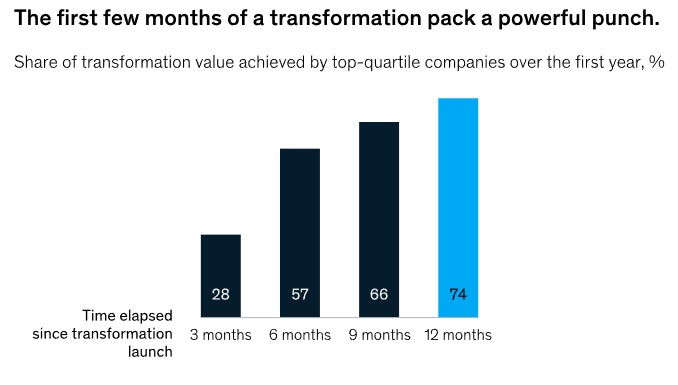
What Is A Transformational Change Leader’s Approach?
Leaders who want to bring about transformative change shouldn’t undervalue the importance of showing a passion for their objectives. But it’s also crucial to maintain realism. Company frontrunners must be aware of the amount of work necessary to implement transformational change for it to be successful. A strong leader should constantly assess their organization’s ability to make the necessary adjustments and gauge the degree to which their staff is engaged in the transition. Although there may be a necessity for certain decision-making to be centralized at the top, barring lower-level employees from communication and even some decision-making on the transformation process can be very harmful because it immediately impacts everyone. Try to make sure this is taken into account whenever feasible because we all need to feel in control of our own fate. Creating a feeling of urgency to get everyone on board with the initial idea, reducing resistance by providing reassurance frequently, and being open about accomplishments and mistakes along the road are some elements to engaging people in transformative change. The overarching goal is to foster a strong sense of confidence in the change program and those in charge of it.
If unsure, there are several helpful change management models you may use as a guide, but remember that, as with all effective tools, it’s how you use them that makes the difference. With revolutionary change, this is unquestionably true.
Why Is Transformative Change Challenging?
Individual humans have a built-in resistance to change. Because the amygdala in our brains perceives severe, disruptive change as a threat and signals us to run or fight, we have trouble adjusting to it. Concerns regarding job security may arise in the workplace due to transformation. The more the change, the greater our level of uncertainty and worry. As a leader, you must be committed to integrating and using your new strategy and procedures if you want to successfully implement transformational change. Making the appropriate strategic decisions at the appropriate moment is essential to ensuring that disruption results in new, constructive behaviors and values. Engage every employee you can, pay attention to what they have to say, and do your best to address their issues. Once a new mindset has been cultivated, you will have achieved half of your goals since attitudes will lay the foundation for sustained organizational success. It takes competence to manage such behavioral adjustments. You will be on the verge of success once your personnel is in line with your talents and environment.
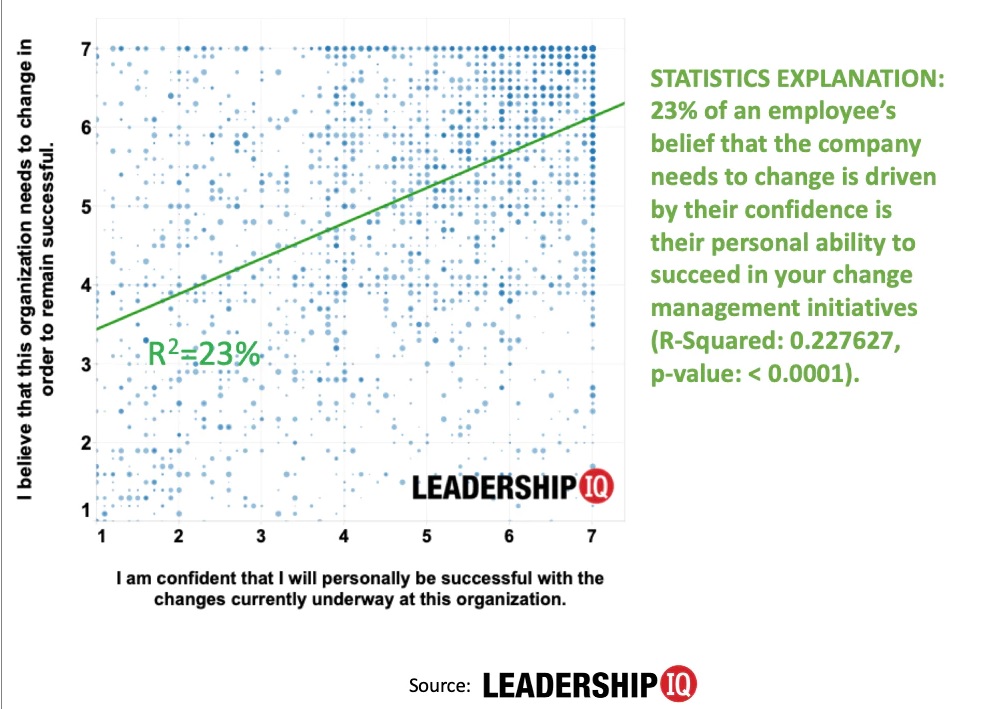
Which Four Phases Of Transformative Change Are There?
The idea that there are four stages to prepare for during times of significant change and transition is supported by bodies of scholarly research. These phases apply to significant changes in one’s personal life, but they can also be useful in comprehending how transformative change is accepted in a professional situation. The initial phase is denial (when individuals withdraw and focus on the past). Resistance is the second (the most difficult stage when feelings of anger and anxiety are expressed). Exploration is the third (when employees begin accepting the process and optimism and morale gradually increases). Commitment, the fourth step, is when you’ll finally notice cooperation, sharper focus, and a higher degree of trust. Your transformative shift can proceed as smoothly as possible if you are ready for each stage, remove obstacles, and respond to each phase early rather than late.
How Do You Handle A Stubborn Team?
As a leader, you must be conscious of the fact that everyone adapts to change at a different rate while considering the four shifts of transformational change. Each adjustment phase necessitates a significant investment of each person’s time and energy. The change may need your teams to relearn their existing role, and the psychological resistance it causes may be catalyzed. Resistance frequently manifests as a shift in performance. You or your leadership team might observe some people abruptly halting their output. They may perform daily duties with less care and attention than usual, making more blunders than usual. In order to support your employees while you alter your organization, it can be important to try to understand the fundamentals of behavioral science. The propensity for resistance can be influenced by a variety of variables, including personality, demography, and hierarchical position. Before things get going, you can ensure that the right assistance is in place to enable the people who are the most resistant to change adjust more easily and avoid any performance problems by anticipatorily identifying these people. Learn more about coping with opposing teams by reading.
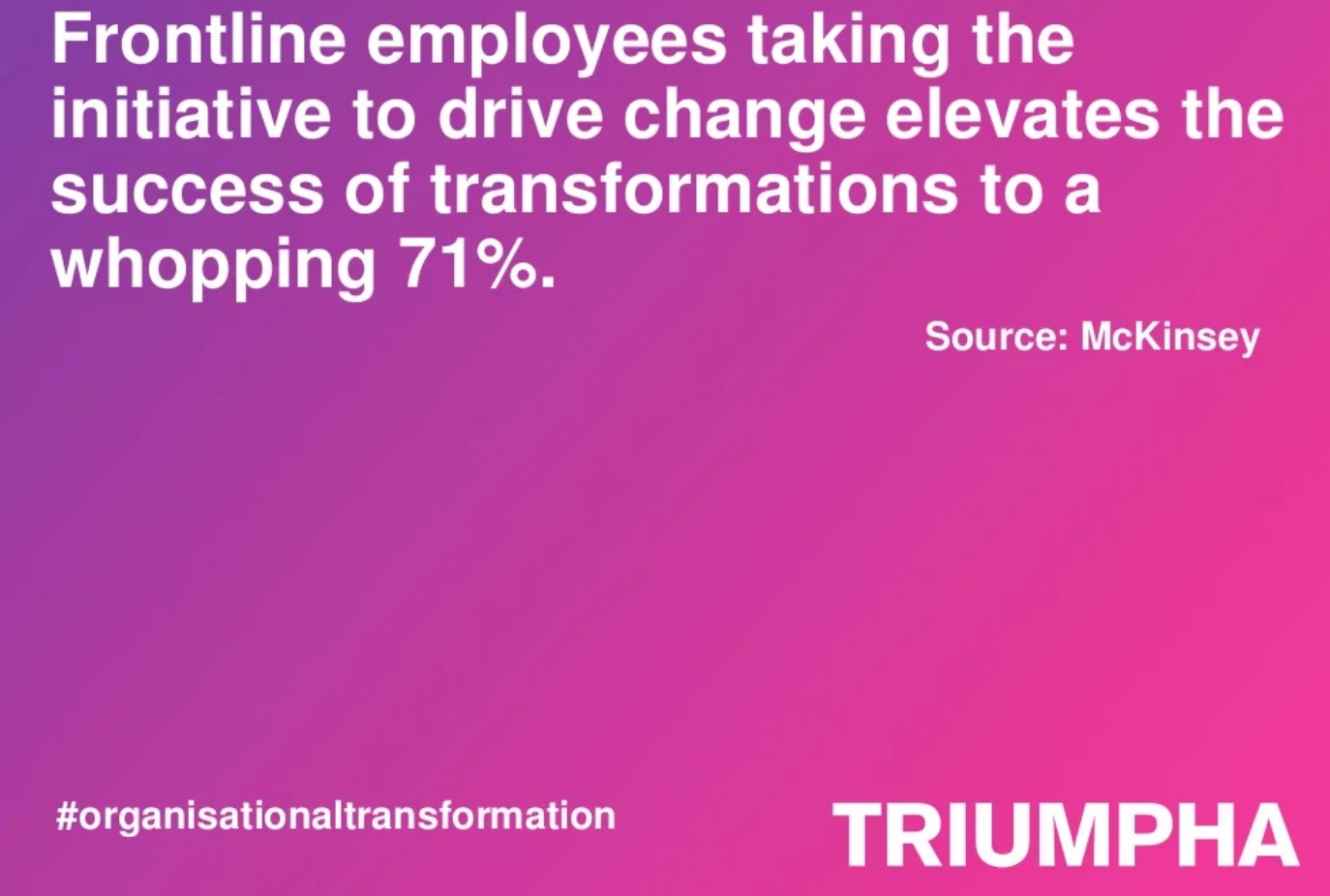
How Is Transformational Change Implemented?
It is useless to claim that “we are doing our best,” as Winston Churchill famously observed. You must be successful in taking the essential action. In transformative change situations, time is frequently of the importance. The rapidity of new advancements can be extremely important if a crisis or unforeseen market adjustments cause a major shift. Pay attention to the things that require your immediate attention and act quickly and broadly on them. You must respond quickly if your surroundings have changed dramatically or if technology has evolved greatly. Traditional behaviors and skills will be firmly relegated to the past thanks to strong leadership and quick decision-making, creating the foundation for a brand-new tomorrow. Additionally, incentives can assist foster dedication. Bonuses, incentive programs, financial arrangements, and performance assessments can help guide cherished staff in the correct direction.
What Causes Successful Transformational Change?
It takes a lot of work to implement radical new structures and procedures. Developing a new culture is quite difficult. But it is possible. A dramatic shift in perspective must be accepted by leaders and employees for transformational change to succeed. Securing a fresh future requires involving everyone on board since only then can your company run efficiently. For the sake of the organization as a whole, transformational change requires everyone to temporarily set aside personal goals. Learn from transformational change tales to inspire people to accept your vision and innovative methods of operation. Utilize knowledge from other successful organizations (and those that have emerged utter failures).
The most prevalent message is typically that organizational change is a difficult process that takes a long time. The most compelling narratives typically emphasize that real revolutionary change is nonlinear. Instead, it’s a process that involves several stages, and setbacks are expected along the way. The goal is to swiftly remove obstacles while methodically planning for and generating rapid victories. Make sure no steps are omitted; while fast-tracking may provide the impression of speed, it is unlikely to produce a satisfactory outcome. Every step of the journey requires strong leadership, and the finest ones never declare victory too soon.
It’s important to know how ready you are for change, ideally before you start and along the road. The success of the change will be greatly influenced by how those involved feel about and view it. Start with a high-quality dialogue and, ideally, a well-thought-out change readiness assessment so you can monitor how those talks are going.
Something To Ponder
For transformational change to be truly successful, each and every one of the participants must embark on a personal transformational journey, let go of the past, and imagine a new future for both themselves and the company. Creating the conditions for people to be able to achieve it, as well as directing, motivating, and ensuring them along the way, is the goal of change leadership.
You now have all the information you require to bring about dramatic change. Due to the fact that change involves individuals, the subject is both fascinating and constantly unexpected, and we continue to learn a lot about it. Although we can’t always control when change occurs, we can at least prepare for it.
Executive Summary
Chapter 1: Transformation Importance
A transformation is a profound change in one’s perspective, thoughts, and actions. It refers to a considerable shift in an individual’s perception of the world and relationship to internal representations, a shift that prevents a reversion to earlier mental models and causes significant changes in behavior on the outside. On the other hand, change typically refers to a gradual change in how one thinks, feels, and behaves.
Transformational change is the process of changing the fundamental components of an organization’s culture, such as the rules, ideals, and presumptions that guide its operations. (Transactional change, on the other hand, refers to the alteration and redesign of the systems and processes that govern interactions within the organization.) People’s perceptions of their positions, obligations, and interpersonal relationships inside the business are impacted by this type of transformation. And it is precisely this alteration in personal views that causes adjustments in organizational behavior.
Transformational change occurs through the process of transformative learning. Transformative learning was described in the following fashion by Jack Mezirow, who was long regarded as the field’s first prominent proponent:
In order to make problematic frames of reference—sets of rigid assumptions and expectations (habits of mind, meaning perspectives, mindsets)—more inclusive, discriminating, open, introspective, and emotionally able to change, transformative learning entails changing these frames of reference. Such frames of reference are preferable to others because they are more likely to produce beliefs and opinions that will turn out to be more accurate or valid and serve as a framework for decision-making.
According to Brown and Posner, “the process of construing and appropriating a new or revised interpretation of meaning of one’s experience as a guide to action.” is what transformative learning entails. According to them, this method of teaching and learning is focused on “a dramatic and fundamental shift in the way we view ourselves and the world in which we live”.
G. Henderson noted the following contrast between the theories of transformative learning and transformative change:
Transformative learning theory contains adult learning theory at its foundation, which explains why it emphasizes the adult learner’s cognitive processes. On the other hand, transformational change theory has its roots in social sciences, which research the impact of external societal factors on individuals.

Chapter 2: Transformational Models
The past year has demonstrated the crucial capability that businesses must have for change. Numerous firms were compelled by the COVID-19 problem to modify their corporate strategies, adopt fresh methods of operation, and develop a more digital culture attitude. Organizations should concentrate on creating a resilient approach to transformative change management that outlasts the pandemic and enables continued transformation as we approach the end of the tunnel. Therefore, in order to ensure that they have the agility to reinvent themselves more regularly in this disruptive era, businesses need to adopt a more sophisticated approach to change management.
The Flaws in Older Change Management Models
Since the beginning of change management 25 years ago, companies have had to contend with the fact that change is a multifaceted challenge. It is now clear that for enterprises to succeed in this environment, the relentless assault and acceleration of technical innovation call for a fresh viewpoint. Even today, most change models (like Kotter and ADKAR) assume some level of return to stasis and call for their implementation in unending waves of programmed change. There must be an easier method.
A Contemporary Framework for Organizational Fitness and Transformational Change Management
What should we do? How can we create the organizational resilience needed to actively engage in a growth mindset rather than simply “handle change”? The forces of remote work, climate change, environmental sustainability, stakeholder capitalism, and social justice movements are also factors we need to be ready for since we know they will have an impact on us for years to come. However, others will unavoidably exist. How can we manage the numerous uncontrollable forces that the modern firm will encounter?
No matter how digital an organization becomes, it is crucial to understand that it is still fundamentally a human endeavor, which is why it is necessary to take a human-centered approach to transformation.
How can we create the organizational resilience necessary to actively engage in a growth mindset rather than just “handle change”?
As we have considered the shortcomings of outmoded theories and techniques for change management, we have started to realize that a new discipline—transformational change management—is emerging in our area of work. Where traditional change management ends, transformational change management starts. It accepts as basic the idea that there are numerous milestones to reach rather than a single one. As a result, the process of transformative change is seen as a continuous journey that frequently has a higher altitude, strategic destination. As a result, the capacity to adapt to change has emerged as a crucial cultural quality for organizational development.

Chapter 3: Vision Process
The Spectrum Of Organizational Change
There are various sorts of organizational transformation, despite the fact that it is frequently presented as a single idea. There might be five to twelve different types of organizational change, depending on the particular change approach.
One of the best ways to approach organizational change is to see it as a spectrum that gauges the degree of change a company is undergoing. Adaptive change is at one end of the spectrum, and transformational change is at the other.
Adjustable Change
Organizations and managers implement adaptive changes as minor, gradual tweaks to address daily, weekly, and monthly business difficulties. These adjustments don’t substantially alter the corporation as a whole, unlike transformational changes, which often include fine-tuning current procedures, products, and business cultures.
Iterating on an existing product to address customer complaints or better meet customer needs are some examples of adaptive changes. These include:
• adding a new payment option for customers who complete an online order,
• implementing a new intake form for clients or vendors, adding a new page to an existing website
• upgrading software or equipment from one version to another without noticing significant changes in functionality
• hiring a new employee to fill a position that has opened up as a result of someone else leaving the company without retiring existing products or otherwise changing the existing brand structure
Managers must lead and direct the change process in order to manage adaptive changes efficiently.
They must first consider the larger picture and comprehend why minor adjustments are essential for the organization’s long-term performance. Then, in order to secure the buy-in required for success, they must persuade their staff and important stakeholders that what may initially appear to be a minor adjustment would benefit the company as a whole. To guarantee that the adaptive change was successful, lasting, and valuable, managers must be systematic in how they plan, carry out, and evaluate these phases. If it wasn’t, they must make the necessary adjustments.
Transformational Change
On the other end of the spectrum, transformational change refers to changes that often have a considerably larger scope than incremental, adaptive modifications. Transformational change frequently refers to a dramatic evolution of any element of the business itself, such as its supply chain, strategy, culture, organization, or processes.
Transformational change frequently occurs suddenly and dramatically, in contrast to adaptive change, which occurs gradually over time. Transformational change is frequently attempted to address a significant issue or difficulty the firm is facing, though this is not always the case.
Examples of transformational change include: transforming an existing brick-and-mortar company into an e-commerce or omnichannel company; rethinking the client or vendor onboarding process; redesigning and starting over with a company’s website; retiring an existing product to focus resources on the creation of a new product; and switching from one major software to another to take advantage of new capabilities.
Transformational change is frequently required as a result of a significant external force, like the entry of a new competitor or acquisition. Managers must be systematic and analytical for adaptive changes, but persuasive and visionary for transformative ones. The manager’s main task while implementing such a significant shift is to inspire staff to embrace the new direction, align them with the new vision, and drive them toward success.
The Space Between
It’s doubtful that the vast bulk of change will fall under the transformative or adaptive categories. Thinking of organizational change as a spectrum has the major advantage of allowing you to consider anything that falls between transformational and adaptive change.
As a firm expands, it may undergo various changes that are both transformational and predictable and incremental. One such shift that every startup must make in order to develop into a mature business is from informal to formal management. The company’s strategy might not alter, but managing the shift well will take a lot of work.
Then, managers need to strike a balance between methodicalness and vision. Employees could be afraid of such a change in strategy or standard operating procedures even though the transition isn’t as radical as a transformative change. Changes must be done in a measurable and flexible manner after inspiring personnel to support the new course.

Chapter 4: Change Readiness
A fundamental transition from change management to change leadership is being marked by all of this. It necessitates some degree of decentralization, giving employees more control.
However, we don’t yet need to toss the manual.
The characteristics of a dynamic, change-ready culture are fluidity and immediateness. But order must be maintained and advancement must be ensured, so a framework is required.
To help us navigate our work and increase our chances of success, we use the following 5 essential components (presented as questions):
• Motivation – Does everyone engaged truly see why, in their own eyes, they must be a part of the change and feel emotionally invested in realizing the vision? Do you actually feel that everyone is on the same team, to put it another way? We refer to it fueling the transformation.
• Obstacles – Do we know everything that would make people hesitate or fight the change? Exist any aspects in the organization that will make the transformation more challenging? Do we have a plan in place for removing the obstacles or “friction” that will stand in its way? We refer to it allowing for the modification.
• Travel – Does everyone understand the route and feel like they can complete it? Are there any early successes or obvious indicators of advancement to keep everyone inspired when times are tough? Can everyone observe the progress as it is made and does everyone know what to do? This is known as executing the change.
• Making it stick – Do we have a plan for maintaining the improvements after initial adoption and forming them into enduring habits? Are we setting a good example at the top, rewarding positive behaviors and actively discouraging negative ones? We refer to it embedding the adjustment.
• Thinking back and making adjustments – Do we really comprehend how we’re doing as we go? How does everyone feel about it, for instance? What do we discover? What can we do better? And is there anything else that needs to be considered in the larger context that might have an impact on the necessity of change or the manner in which it is implemented? We refer to that as evaluating.

Chapter 5: Emotional Journey
How To Make Change Less Painful
For many of us, the last few years have been an emotional roller coaster as we’ve gone through one of the biggest global upheavals most of us have ever seen in our lifetimes. Looking back on the year, there have undoubtedly been some incredible improvements (like the tremendous work on the vaccine), but I’m sure there have also been those that may not have felt so good.
Any significant shift entails an emotional journey that may be thrilling, painful, or even both. It can be challenging to maintain perspective during periods of fast change, but understanding that there is a natural cycle and that everyone experiences it at various times may be beneficial in some tiny way.
Grieving And Change
Elisabeth Kübler-Ross, a psychiatrist, spent a lot of time in the 1960s interacting intimately with the dying and bereaved. She observed that humans frequently go through a range of emotions while grieving, and that these feelings frequently have a similar pattern. These discoveries were later refined into the “grief curve” in her book “On Death and Dying,” which outlined five essential phases of the emotional journey we frequently go through in those circumstances. It’s also widely acknowledged that loss and change exhibit a lot of the same characteristics, particularly when the change was imposed on us.
For changes like the ones we’ve witnessed this year, it might be helpful to understand that these feelings are entirely normal. If we can comprehend them, we might be able to get a little more perspective, which might, in turn, help to smooth the process a little.
A Five-Stage Process
Communication is the first step in preparing an organization for change. Having a plan that addresses communications to all stakeholders is crucial, even if there are limitations on when specific people or departments can be notified for operational reasons.
The Kubler-Ross Change Curve has shown us that change is not always immediately accepted. People require time to move through the stages of the change curve, so we need to give them that.
Any change we are going through can be categorized into one of the stages of the Kübler-Ross grief curve, but this is especially true when the change has been imposed upon us. We don’t all proceed through the stages in precisely the same order, thus this model, like all others, is only an estimate. We may go through some stages extremely rapidly, perhaps even without being aware of them, or we may linger there for a while. Along the curve, we may also do back-and-forth motions.

Chapter 6: Change Engagement
Any transformational change program’s success is unquestionably dependent on the commitment and buy-in of the individuals who will be involved in the change and accountable for “living” it going forward. Our years of experience collaborating with organizations on change management initiatives have shown us that there are two key actions you can take to increase your chances of success. These are the two steps:
1. Taking the time to identify the truly compelling justifications for everyone’s participation in the change and publicly communicating them to foster trust This process is known as building a credible case.
2. Giving everyone the essential skills they need to engage in and navigate the change process, ensuring the change is implemented successfully.
To ensure you receive the best level of acceptance, buy-in, and engagement, spend time on these two steps before the change process even begins or very early on in the process.
Any transformation involving your people, processes, or technology will be simpler to achieve if attention is given to these people-focused actions since your team will be eager to join in.
Creating A Convincing Argument
When people think there is a good cause for the change, they accept it, adjust to it, and interact with it. A crucial first step is developing an argument that people may buy into and regard as credible. You’ll be on the right track if you can show how the change will directly lead to the advantages that each person and team will experience as a result of embracing the new modes of operation.
It could be necessary to modify the credible case for various teams, departments, or organizational levels. It should address any underlying concerns that can prevent employees from embracing change, such as “What does it mean to me, my role, and the business?”, “Is it worth it?,” and “What will the advantages be?” It should be created specifically with the target employee audience in mind.
Engaging all organizational levels in advance of any transformational change and knowing the realities of people’s jobs and issues can provide essential knowledge to aid in the creation of the believable case. According to our experience, the business generally accepts numerous requirements for transformational change, though for various reasons. Senior stakeholders could prioritize financial performance, customer acquisition and retention goals, or customer service measures that distinguish the company from rivals as major motivations for changing the customer experience. Members of the front-line customer care staff may find the same change program advantageous because it will equip them with new abilities to address client inquiries and feedback in a more assertive manner. A respectfully crafted rationale focused on these outcomes, delivered appropriately, will enable people in their own area to feel they can believe in the case and that it has value for them as well as the business. Both reasons are valid and significant and would form the basis of the believable case at each level.

Chapter 7: Change Leadership
Transformational Leadership: What Is It?
Employees are encouraged, inspired, and motivated by the transformational leadership approach to innovate and bring about the change required to determine the company’s future success. To do this, executives need to lead by example, demonstrating sincerity, a strong sense of company culture, employee ownership, and independence at work. Business change agents, transformational leaders may spot emerging and changing technological trends and then assist their firm in embracing those changes.
Without micromanaging, transformational leaders inspire and motivate their team members; instead, they put their trained staff members in charge of making decisions related to their professions. It is a management approach that is intended to provide staff members greater freedom to be innovative, consider the future, and come up with fresh answers to persistent problems. Through training and mentoring, staff members on the leadership track will also be prepared to become transformative leaders themselves.
Theory Of Transformational Leadership
James V. Downton introduced the idea of transformative leadership in 1973, and James Burns developed it in 1978. Bernard M. Bass, a researcher, further developed the idea in 1985 by adding techniques to gauge the effectiveness of transformational leadership. With the hope that followers would be inspired, this leadership paradigm pushes leaders to show powerful, true leadership.
Although Bass’ theory on transformational leadership was developed in the 1970s, it is still a useful leadership strategy employed today. This is because real leadership never changes; only the circumstances in which it is applied do. Every industry may benefit from it, but the fast-paced IT sector is particularly in need of it because innovation and agility there can make or break a business.
Traits Of Transformational Leadership
According to David E. Ulicne, senior director of executive education at Carnegie Mellon University’s Heinz College of Information Systems and Public Policy, organizations seek out transformational leaders that exhibit a “executive presence.”
“The ability to express their vision and get the support of key stakeholders would be the most crucial quality for the success of the CIO.” You’ll need to “develop your narrative talents” by giving presentations at conferences and symposiums, as well as by filming your speeches and soliciting “constructive feedback” from your PR or media staff.
The following is how transformational leaders differentiate themselves from other types of leaders, according to Bass’ model:
• Encouragement of followers’ motivation and positive development Encouragement of others to uphold moral standards within the organization and to do the same
• Encouragement of an ethical workplace with obvious norms, values, and goals
• Holding an emphasis on authenticity, cooperation, and open communication while encouraging employees to shift from a mindset of self-interest to one where they are working for the common good.
• Offering coaching and mentoring while empowering staff to accept responsibility for decisions and tasks.

Chapter 8: Transformational Barriers
Businesses constantly undergo a number of organizational changes to stay ahead of the competition and innovate with the aim of enhancing productivity and boosting revenue in order to keep up with a rapidly changing global environment. Only one in three change management programs are successful, despite a rise in change volumes and complexity.
Why are these endeavors for change failing? People-related aspects of change management are frequently neglected by organizations.
Making change human is crucial. Organizations frequently misjudge internal power relationships, external factors, and employee resistance to change. They merely take a top-to-bottom strategy to change management, forgetting that imposing change often results in pushback.
Leaders should perform a baseline assessment to identify the barriers to change and address them for a successful change program in order to lessen this resistance.
What are the most typical obstacles to project change?
• Lack of Governance; Clarity;
• Ineffective Change Communication;
• Strategic Weakness;
• Change Resistant Culture;
• Lack of Organizational Buy-In;
• Change Fatigue;
Removing Constraints For Change Management
You should adhere to the fundamental change management principles to prevent your project from stalling or falling apart. These depend on: • motivating staff through change; • informing staff and stakeholders about the change; • realizing the necessity and impact of change; • including staff at all levels in the process; and • maintaining the change and ingraining it as the new norm.
A company environment that is adaptable to change may be fostered by a number of variables. As an illustration, a potent leadership group, a continuous improvement culture, and a motivated workforce. But it’s likely that several strategies will be required to get past the various obstacles.
Remember that implementing change can take a lot of time, and resistance to change projects is frequent. It’s critical to realistically assess the scope of the change and determine whether gradual, small changes are preferable to abrupt, full-scale organizational changes.

chapter 9: Resistance
Motives for Change Resistance
Change is a vital and necessary component of organizational existence. It is all-encompassing, therefore the question of how crucial it is to develop an organization’s coping and adapting processes for being relevant and successful in the modern environment arises.
Together with the idea of change management, the phrase “resistance to change” is explored. Organizational or personal factors may play a role in resistance to change. Organizational resistance, according to Agócs (1997), includes any organizational behavioral tendencies that obstruct or undercut change.
A slight amount of resistance to change is regarded as advantageous because it contributes significantly to behavioral predictability and stability. It is said to have a positive impact on decision-making, critically evaluate the choices that are accessible, and encourage productive brainstorming on the validity of various ideas and tactical alternatives. On the other hand, resistance to change causes unneeded turmoil and problems with adaptability, which impedes the development of the work.
Different behaviors can be used to show resistance to change. Resistance to change can take many different forms, including overt, hidden, implicit, immediate, and postponed. Individual resistance to change can be broken down into the groups listed below:
Resistance: Irrational vs. Rational
Rational or irrational resistance to change can be just described as a perceptual process, according to de Jager (2001). The change literature does not make much note of irrational resistance to change. As a result, the illogical resistance lacks a precise description. Rational resistance to change is supported by logical explanation, justification, or a reward that can bring about the change, but irrational opposition can only be felt or typically shown in a variety of behavioral forms.
Resistance: Justified vs. Unjustified
Justified and Unjustified Resistance to Change are two types of rational resistance to change. Unjustified rational change is typically psychological in nature and may involve hidden commitments to opposing ideologies (Kegan & Lahey, 2002), show up as personal anxieties or insecurities (Powell & Posner, 1978; Yukl, 2006), or simply be a belief that the change may go against one’s own values or culture (Lawson & Price, 2003; Recardo, 1995; Schein & NetLibrary, 2004; Yukl, 2006). The following sorts of unjustified rational resistance are possible, with fear or menace as the main motivators:
• a threat to one’s personal ideals, ethics, or philosophy;
• a threat of a potential change in the status quo; fear of the unknown;
• fear of personal failure;
• fear of being branded as incompetent;
• fear of losing control of the situation
Resistance That Is Covert vs. Overt
Both overt and covert behaviors can be used to demonstrate resistance to change (de Jager, 2001). Atkinson (2005) asserts that it is relatively simpler to identify overt resistance and that the necessary measures can be applied to lessen its impact.
Although overt resistance can take many different forms, it typically manifests as either outspoken opposition or intense agitation. However, it can be quite challenging to identify concealed resistance to change. Recardo (1995) asserts that covert resistance to change can take the following forms:
• Reduction in output Information withholding
• Prolonging the issue by requesting needless details or information for more studies or investigations
• Needlessly appointing committees or other task groups

Chapter 10: Transformational Strategy
A Transformation strategy: what is it?
The response strategy a company will employ to deal with change is known as a change management strategy. It is a technique designed to take advantage of the change while minimizing any bad consequences the events that are changing the world may have.
Okay, so in principle it makes sense, but what is it in practice?
Simply said, it’s a “better safe than sorry” strategy that businesses can employ when change occurs.
Why Change Management Strategies Are Necessary
You can better anticipate how changes may impact your organization if you have a change management strategy.
No matter what, change is coming, so you might as well be prepared.
If you believe that your company won’t be easily impacted by change, you might wish to research organizations that, when faced with change, did not adapt. There are a lot of them!
Even if you believe your organization to be large and impenetrable, change can quickly cripple it if you don’t have a plan for it. Do you recall Blockbuster? Probably the best illustration of poor change management techniques.
Important Components of a Change Management Strategy
As previously said, there are many other approaches to change management strategies, thus this is not a NEW one. The following are some important factors to think about while you construct your own strategy:
• Planning
• Transparency
• Communication
• Involvement
• Build a Road Map

Chapter 11: Transformational Failure
Businesses without a defined plan, strong processes, and a core staff that is adaptable may encounter obstacles in their transformation, even with the most experienced CEOs at the helm.
Business change is nothing new. Since the conception of trade, businesses have had to learn how to develop and adjust to both internal and external variables. In fact, the majority of the largest corporations in the world today did not even exist twenty years ago. And those who were at the top 20 years ago have either gone by the wayside or have been absorbed into a completely new organization. Why do business executives still occasionally make mistakes in the face of so many historical examples of company transformation success and failure?
It may be argued that changes can get more complex the larger the organization. Larger organizations typically have dozens of executives with decades of business experience in a variety of industries and access to numerous resources, but the leaders of these organizations frequently receive criticism for spectacular failures to turn around failing companies or transform a particular area of the business.
The main cause of failure is frequently that the strategy and big picture weren’t crystal clear from the beginning.
Another factor contributing to failed transformation programs is inertia. Apathy in the larger business community, a lack of desire to change, and core employees who lack the will to do so or did not agree with the vision put forth may ultimately lead to issues in the future.
Despite the fact that the majority of corporate transformations center on new systems, procedures, and technology, executives frequently overlook their employees. However, those modifications will be implemented and experienced by the local personnel. Goals for transformation can also be derailed by a failure to obtain worker buy-in or by delayed communication.
Chapter 12: Transformational Success
Are Your Projects For Transformational Change A Success?
If you’ve ever heard, seen, or quoted the following statistic, nod your head: “transformational change efforts fail in 70% of cases.”
Let’s face it: the failure rate of 70% is alarming. It strengthens the case for employing transformational change specialists with experience. It advises implementers to become knowledgeable about change management procedures and include them into their tactical assignments.
Sadly, it’s a fictitious number. Michael hammer made some assumptions regarding the success rate of re-engineering initiatives back in the 1990s, and ever since then, authors and speakers have pointed out that 70% of change programs fail. A number of transformational change experts have thoroughly debunked it by researching the change archives. (see this and this.) But it continues.
• few organizations are disciplined or skilled at identifying measures of success at the outset of their projects; • the data to measure success is frequently difficult to collect; • the evidence of success can rarely be attributed solely to the change effort; • leaders move the finish line or unexpected circumstances cause it to move; • the initial sponsor leaves and her replacement does not revisit the measures.
How can someone claim that 70% of change programs fail with such surety when there is so much evidence to the contrary?
Simplify Measurement, But Without Being Simplistic
Here is a recommendation: why not apply some discipline to your change efforts and assess your own success rate instead of using a created and useless statistic? It makes sense conceptually. You specify what you anticipate happening, you monitor what really occurs, and you assess whether your goals were met or not.
Ah, you remark, “the world is challenging! Goals, leaders, and organizations all evolve. The environment of competition changes. The state of the economy deviates from expectations. Additionally, the risk and uncertainty we encounter increase with project size, making measuring all the more difficult.
It’s true that assessing significant, intricate, multi-year projects can be challenging. But what choices do you have? Throw up your arms and completely evade measurement? Set objectives but never assess your progress? Or use a straightforward but adaptable framework to help you learn as you go, change course, and accomplish your objectives? I recommend the final selection.
There’s no reason why your measurement procedure should be difficult. Start by segmenting your project into stages, such as:
1. Diagnosis and plan of action
2. Resource management
3. Application
4. Realizing the state of the future
Ask a series of questions at each stage to see whether you’re ready to advance. The inquiries are fundamental and necessary for any sizeable endeavor, whether or not it involves transformation. These questions can and should be tailored for your company based on the results you hope to achieve. The main goal at this point, regardless of the questions selected, is to identify and agree on what questions to answer.
Curriculum
Transformational Change – Workshop 1 – About Transformation
- Transformation Importance
- Transformational Models
- Vision Process
- Change Readiness
- Emotional Journey
- Change Engagement
- Change Leadership
- Transformational Barriers
- Resistance
- Transformational Strategy
- Transformational Failure
- Transformational Success
Distance Learning
Introduction
Welcome to Appleton Greene and thank you for enrolling on the Transformational Change corporate training program. You will be learning through our unique facilitation via distance-learning method, which will enable you to practically implement everything that you learn academically. The methods and materials used in your program have been designed and developed to ensure that you derive the maximum benefits and enjoyment possible. We hope that you find the program challenging and fun to do. However, if you have never been a distance-learner before, you may be experiencing some trepidation at the task before you. So we will get you started by giving you some basic information and guidance on how you can make the best use of the modules, how you should manage the materials and what you should be doing as you work through them. This guide is designed to point you in the right direction and help you to become an effective distance-learner. Take a few hours or so to study this guide and your guide to tutorial support for students, while making notes, before you start to study in earnest.
Study environment
You will need to locate a quiet and private place to study, preferably a room where you can easily be isolated from external disturbances or distractions. Make sure the room is well-lit and incorporates a relaxed, pleasant feel. If you can spoil yourself within your study environment, you will have much more of a chance to ensure that you are always in the right frame of mind when you do devote time to study. For example, a nice fire, the ability to play soft soothing background music, soft but effective lighting, perhaps a nice view if possible and a good size desk with a comfortable chair. Make sure that your family know when you are studying and understand your study rules. Your study environment is very important. The ideal situation, if at all possible, is to have a separate study, which can be devoted to you. If this is not possible then you will need to pay a lot more attention to developing and managing your study schedule, because it will affect other people as well as yourself. The better your study environment, the more productive you will be.
Study tools & rules
Try and make sure that your study tools are sufficient and in good working order. You will need to have access to a computer, scanner and printer, with access to the internet. You will need a very comfortable chair, which supports your lower back, and you will need a good filing system. It can be very frustrating if you are spending valuable study time trying to fix study tools that are unreliable, or unsuitable for the task. Make sure that your study tools are up to date. You will also need to consider some study rules. Some of these rules will apply to you and will be intended to help you to be more disciplined about when and how you study. This distance-learning guide will help you and after you have read it you can put some thought into what your study rules should be. You will also need to negotiate some study rules for your family, friends or anyone who lives with you. They too will need to be disciplined in order to ensure that they can support you while you study. It is important to ensure that your family and friends are an integral part of your study team. Having their support and encouragement can prove to be a crucial contribution to your successful completion of the program. Involve them in as much as you can.
Successful distance-learning
Distance-learners are freed from the necessity of attending regular classes or workshops, since they can study in their own way, at their own pace and for their own purposes. But unlike traditional internal training courses, it is the student’s responsibility, with a distance-learning program, to ensure that they manage their own study contribution. This requires strong self-discipline and self-motivation skills and there must be a clear will to succeed. Those students who are used to managing themselves, are good at managing others and who enjoy working in isolation, are more likely to be good distance-learners. It is also important to be aware of the main reasons why you are studying and of the main objectives that you are hoping to achieve as a result. You will need to remind yourself of these objectives at times when you need to motivate yourself. Never lose sight of your long-term goals and your short-term objectives. There is nobody available here to pamper you, or to look after you, or to spoon-feed you with information, so you will need to find ways to encourage and appreciate yourself while you are studying. Make sure that you chart your study progress, so that you can be sure of your achievements and re-evaluate your goals and objectives regularly.
Self-assessment
Appleton Greene training programs are in all cases post-graduate programs. Consequently, you should already have obtained a business-related degree and be an experienced learner. You should therefore already be aware of your study strengths and weaknesses. For example, which time of the day are you at your most productive? Are you a lark or an owl? What study methods do you respond to the most? Are you a consistent learner? How do you discipline yourself? How do you ensure that you enjoy yourself while studying? It is important to understand yourself as a learner and so some self-assessment early on will be necessary if you are to apply yourself correctly. Perform a SWOT analysis on yourself as a student. List your internal strengths and weaknesses as a student and your external opportunities and threats. This will help you later on when you are creating a study plan. You can then incorporate features within your study plan that can ensure that you are playing to your strengths, while compensating for your weaknesses. You can also ensure that you make the most of your opportunities, while avoiding the potential threats to your success.
Accepting responsibility as a student
Training programs invariably require a significant investment, both in terms of what they cost and in the time that you need to contribute to study and the responsibility for successful completion of training programs rests entirely with the student. This is never more apparent than when a student is learning via distance-learning. Accepting responsibility as a student is an important step towards ensuring that you can successfully complete your training program. It is easy to instantly blame other people or factors when things go wrong. But the fact of the matter is that if a failure is your failure, then you have the power to do something about it, it is entirely in your own hands. If it is always someone else’s failure, then you are powerless to do anything about it. All students study in entirely different ways, this is because we are all individuals and what is right for one student, is not necessarily right for another. In order to succeed, you will have to accept personal responsibility for finding a way to plan, implement and manage a personal study plan that works for you. If you do not succeed, you only have yourself to blame.
Planning
By far the most critical contribution to stress, is the feeling of not being in control. In the absence of planning we tend to be reactive and can stumble from pillar to post in the hope that things will turn out fine in the end. Invariably they don’t! In order to be in control, we need to have firm ideas about how and when we want to do things. We also need to consider as many possible eventualities as we can, so that we are prepared for them when they happen. Prescriptive Change, is far easier to manage and control, than Emergent Change. The same is true with distance-learning. It is much easier and much more enjoyable, if you feel that you are in control and that things are going to plan. Even when things do go wrong, you are prepared for them and can act accordingly without any unnecessary stress. It is important therefore that you do take time to plan your studies properly.
Management
Once you have developed a clear study plan, it is of equal importance to ensure that you manage the implementation of it. Most of us usually enjoy planning, but it is usually during implementation when things go wrong. Targets are not met and we do not understand why. Sometimes we do not even know if targets are being met. It is not enough for us to conclude that the study plan just failed. If it is failing, you will need to understand what you can do about it. Similarly if your study plan is succeeding, it is still important to understand why, so that you can improve upon your success. You therefore need to have guidelines for self-assessment so that you can be consistent with performance improvement throughout the program. If you manage things correctly, then your performance should constantly improve throughout the program.
Study objectives & tasks
The first place to start is developing your program objectives. These should feature your reasons for undertaking the training program in order of priority. Keep them succinct and to the point in order to avoid confusion. Do not just write the first things that come into your head because they are likely to be too similar to each other. Make a list of possible departmental headings, such as: Customer Service; E-business; Finance; Globalization; Human Resources; Technology; Legal; Management; Marketing and Production. Then brainstorm for ideas by listing as many things that you want to achieve under each heading and later re-arrange these things in order of priority. Finally, select the top item from each department heading and choose these as your program objectives. Try and restrict yourself to five because it will enable you to focus clearly. It is likely that the other things that you listed will be achieved if each of the top objectives are achieved. If this does not prove to be the case, then simply work through the process again.
Study forecast
As a guide, the Appleton Greene Transformational Change corporate training program should take 12-18 months to complete, depending upon your availability and current commitments. The reason why there is such a variance in time estimates is because every student is an individual, with differing productivity levels and different commitments. These differentiations are then exaggerated by the fact that this is a distance-learning program, which incorporates the practical integration of academic theory as an as a part of the training program. Consequently all of the project studies are real, which means that important decisions and compromises need to be made. You will want to get things right and will need to be patient with your expectations in order to ensure that they are. We would always recommend that you are prudent with your own task and time forecasts, but you still need to develop them and have a clear indication of what are realistic expectations in your case. With reference to your time planning: consider the time that you can realistically dedicate towards study with the program every week; calculate how long it should take you to complete the program, using the guidelines featured here; then break the program down into logical modules and allocate a suitable proportion of time to each of them, these will be your milestones; you can create a time plan by using a spreadsheet on your computer, or a personal organizer such as MS Outlook, you could also use a financial forecasting software; break your time forecasts down into manageable chunks of time, the more specific you can be, the more productive and accurate your time management will be; finally, use formulas where possible to do your time calculations for you, because this will help later on when your forecasts need to change in line with actual performance. With reference to your task planning: refer to your list of tasks that need to be undertaken in order to achieve your program objectives; with reference to your time plan, calculate when each task should be implemented; remember that you are not estimating when your objectives will be achieved, but when you will need to focus upon implementing the corresponding tasks; you also need to ensure that each task is implemented in conjunction with the associated training modules which are relevant; then break each single task down into a list of specific to do’s, say approximately ten to do’s for each task and enter these into your study plan; once again you could use MS Outlook to incorporate both your time and task planning and this could constitute your study plan; you could also use a project management software like MS Project. You should now have a clear and realistic forecast detailing when you can expect to be able to do something about undertaking the tasks to achieve your program objectives.
Performance management
It is one thing to develop your study forecast, it is quite another to monitor your progress. Ultimately it is less important whether you achieve your original study forecast and more important that you update it so that it constantly remains realistic in line with your performance. As you begin to work through the program, you will begin to have more of an idea about your own personal performance and productivity levels as a distance-learner. Once you have completed your first study module, you should re-evaluate your study forecast for both time and tasks, so that they reflect your actual performance level achieved. In order to achieve this you must first time yourself while training by using an alarm clock. Set the alarm for hourly intervals and make a note of how far you have come within that time. You can then make a note of your actual performance on your study plan and then compare your performance against your forecast. Then consider the reasons that have contributed towards your performance level, whether they are positive or negative and make a considered adjustment to your future forecasts as a result. Given time, you should start achieving your forecasts regularly.
With reference to time management: time yourself while you are studying and make a note of the actual time taken in your study plan; consider your successes with time-efficiency and the reasons for the success in each case and take this into consideration when reviewing future time planning; consider your failures with time-efficiency and the reasons for the failures in each case and take this into consideration when reviewing future time planning; re-evaluate your study forecast in relation to time planning for the remainder of your training program to ensure that you continue to be realistic about your time expectations. You need to be consistent with your time management, otherwise you will never complete your studies. This will either be because you are not contributing enough time to your studies, or you will become less efficient with the time that you do allocate to your studies. Remember, if you are not in control of your studies, they can just become yet another cause of stress for you.
With reference to your task management: time yourself while you are studying and make a note of the actual tasks that you have undertaken in your study plan; consider your successes with task-efficiency and the reasons for the success in each case; take this into consideration when reviewing future task planning; consider your failures with task-efficiency and the reasons for the failures in each case and take this into consideration when reviewing future task planning; re-evaluate your study forecast in relation to task planning for the remainder of your training program to ensure that you continue to be realistic about your task expectations. You need to be consistent with your task management, otherwise you will never know whether you are achieving your program objectives or not.
Keeping in touch
You will have access to qualified and experienced professors and tutors who are responsible for providing tutorial support for your particular training program. So don’t be shy about letting them know how you are getting on. We keep electronic records of all tutorial support emails so that professors and tutors can review previous correspondence before considering an individual response. It also means that there is a record of all communications between you and your professors and tutors and this helps to avoid any unnecessary duplication, misunderstanding, or misinterpretation. If you have a problem relating to the program, share it with them via email. It is likely that they have come across the same problem before and are usually able to make helpful suggestions and steer you in the right direction. To learn more about when and how to use tutorial support, please refer to the Tutorial Support section of this student information guide. This will help you to ensure that you are making the most of tutorial support that is available to you and will ultimately contribute towards your success and enjoyment with your training program.
Work colleagues and family
You should certainly discuss your program study progress with your colleagues, friends and your family. Appleton Greene training programs are very practical. They require you to seek information from other people, to plan, develop and implement processes with other people and to achieve feedback from other people in relation to viability and productivity. You will therefore have plenty of opportunities to test your ideas and enlist the views of others. People tend to be sympathetic towards distance-learners, so don’t bottle it all up in yourself. Get out there and share it! It is also likely that your family and colleagues are going to benefit from your labors with the program, so they are likely to be much more interested in being involved than you might think. Be bold about delegating work to those who might benefit themselves. This is a great way to achieve understanding and commitment from people who you may later rely upon for process implementation. Share your experiences with your friends and family.
Making it relevant
The key to successful learning is to make it relevant to your own individual circumstances. At all times you should be trying to make bridges between the content of the program and your own situation. Whether you achieve this through quiet reflection or through interactive discussion with your colleagues, client partners or your family, remember that it is the most important and rewarding aspect of translating your studies into real self-improvement. You should be clear about how you want the program to benefit you. This involves setting clear study objectives in relation to the content of the course in terms of understanding, concepts, completing research or reviewing activities and relating the content of the modules to your own situation. Your objectives may understandably change as you work through the program, in which case you should enter the revised objectives on your study plan so that you have a permanent reminder of what you are trying to achieve, when and why.
Distance-learning check-list
Prepare your study environment, your study tools and rules.
Undertake detailed self-assessment in terms of your ability as a learner.
Create a format for your study plan.
Consider your study objectives and tasks.
Create a study forecast.
Assess your study performance.
Re-evaluate your study forecast.
Be consistent when managing your study plan.
Use your Appleton Greene Certified Learning Provider (CLP) for tutorial support.
Make sure you keep in touch with those around you.

Tutorial Support
Programs
Appleton Greene uses standard and bespoke corporate training programs as vessels to transfer business process improvement knowledge into the heart of our clients’ organizations. Each individual program focuses upon the implementation of a specific business process, which enables clients to easily quantify their return on investment. There are hundreds of established Appleton Greene corporate training products now available to clients within customer services, e-business, finance, globalization, human resources, information technology, legal, management, marketing and production. It does not matter whether a client’s employees are located within one office, or an unlimited number of international offices, we can still bring them together to learn and implement specific business processes collectively. Our approach to global localization enables us to provide clients with a truly international service with that all important personal touch. Appleton Greene corporate training programs can be provided virtually or locally and they are all unique in that they individually focus upon a specific business function. They are implemented over a sustainable period of time and professional support is consistently provided by qualified learning providers and specialist consultants.
Support available
You will have a designated Certified Learning Provider (CLP) and an Accredited Consultant and we encourage you to communicate with them as much as possible. In all cases tutorial support is provided online because we can then keep a record of all communications to ensure that tutorial support remains consistent. You would also be forwarding your work to the tutorial support unit for evaluation and assessment. You will receive individual feedback on all of the work that you undertake on a one-to-one basis, together with specific recommendations for anything that may need to be changed in order to achieve a pass with merit or a pass with distinction and you then have as many opportunities as you may need to re-submit project studies until they meet with the required standard. Consequently the only reason that you should really fail (CLP) is if you do not do the work. It makes no difference to us whether a student takes 12 months or 18 months to complete the program, what matters is that in all cases the same quality standard will have been achieved.
Support Process
Please forward all of your future emails to the designated (CLP) Tutorial Support Unit email address that has been provided and please do not duplicate or copy your emails to other AGC email accounts as this will just cause unnecessary administration. Please note that emails are always answered as quickly as possible but you will need to allow a period of up to 20 business days for responses to general tutorial support emails during busy periods, because emails are answered strictly within the order in which they are received. You will also need to allow a period of up to 30 business days for the evaluation and assessment of project studies. This does not include weekends or public holidays. Please therefore kindly allow for this within your time planning. All communications are managed online via email because it enables tutorial service support managers to review other communications which have been received before responding and it ensures that there is a copy of all communications retained on file for future reference. All communications will be stored within your personal (CLP) study file here at Appleton Greene throughout your designated study period. If you need any assistance or clarification at any time, please do not hesitate to contact us by forwarding an email and remember that we are here to help. If you have any questions, please list and number your questions succinctly and you can then be sure of receiving specific answers to each and every query.
Time Management
It takes approximately 1 Year to complete the Transformational Change corporate training program, incorporating 12 x 6-hour monthly workshops. Each student will also need to contribute approximately 4 hours per week over 1 Year of their personal time. Students can study from home or work at their own pace and are responsible for managing their own study plan. There are no formal examinations and students are evaluated and assessed based upon their project study submissions, together with the quality of their internal analysis and supporting documents. They can contribute more time towards study when they have the time to do so and can contribute less time when they are busy. All students tend to be in full time employment while studying and the Transformational Change program is purposely designed to accommodate this, so there is plenty of flexibility in terms of time management. It makes no difference to us at Appleton Greene, whether individuals take 12-18 months to complete this program. What matters is that in all cases the same standard of quality will have been achieved with the standard and bespoke programs that have been developed.
Distance Learning Guide
The distance learning guide should be your first port of call when starting your training program. It will help you when you are planning how and when to study, how to create the right environment and how to establish the right frame of mind. If you can lay the foundations properly during the planning stage, then it will contribute to your enjoyment and productivity while training later. The guide helps to change your lifestyle in order to accommodate time for study and to cultivate good study habits. It helps you to chart your progress so that you can measure your performance and achieve your goals. It explains the tools that you will need for study and how to make them work. It also explains how to translate academic theory into practical reality. Spend some time now working through your distance learning guide and make sure that you have firm foundations in place so that you can make the most of your distance learning program. There is no requirement for you to attend training workshops or classes at Appleton Greene offices. The entire program is undertaken online, program course manuals and project studies are administered via the Appleton Greene web site and via email, so you are able to study at your own pace and in the comfort of your own home or office as long as you have a computer and access to the internet.
How To Study
The how to study guide provides students with a clear understanding of the Appleton Greene facilitation via distance learning training methods and enables students to obtain a clear overview of the training program content. It enables students to understand the step-by-step training methods used by Appleton Greene and how course manuals are integrated with project studies. It explains the research and development that is required and the need to provide evidence and references to support your statements. It also enables students to understand precisely what will be required of them in order to achieve a pass with merit and a pass with distinction for individual project studies and provides useful guidance on how to be innovative and creative when developing your Unique Program Proposition (UPP).
Tutorial Support
Tutorial support for the Appleton Greene Transformational Change corporate training program is provided online either through the Appleton Greene Client Support Portal (CSP), or via email. All tutorial support requests are facilitated by a designated Program Administration Manager (PAM). They are responsible for deciding which professor or tutor is the most appropriate option relating to the support required and then the tutorial support request is forwarded onto them. Once the professor or tutor has completed the tutorial support request and answered any questions that have been asked, this communication is then returned to the student via email by the designated Program Administration Manager (PAM). This enables all tutorial support, between students, professors and tutors, to be facilitated by the designated Program Administration Manager (PAM) efficiently and securely through the email account. You will therefore need to allow a period of up to 20 business days for responses to general support queries and up to 30 business days for the evaluation and assessment of project studies, because all tutorial support requests are answered strictly within the order in which they are received. This does not include weekends or public holidays. Consequently you need to put some thought into the management of your tutorial support procedure in order to ensure that your study plan is feasible and to obtain the maximum possible benefit from tutorial support during your period of study. Please retain copies of your tutorial support emails for future reference. Please ensure that ALL of your tutorial support emails are set out using the format as suggested within your guide to tutorial support. Your tutorial support emails need to be referenced clearly to the specific part of the course manual or project study which you are working on at any given time. You also need to list and number any questions that you would like to ask, up to a maximum of five questions within each tutorial support email. Remember the more specific you can be with your questions the more specific your answers will be too and this will help you to avoid any unnecessary misunderstanding, misinterpretation, or duplication. The guide to tutorial support is intended to help you to understand how and when to use support in order to ensure that you get the most out of your training program. Appleton Greene training programs are designed to enable you to do things for yourself. They provide you with a structure or a framework and we use tutorial support to facilitate students while they practically implement what they learn. In other words, we are enabling students to do things for themselves. The benefits of distance learning via facilitation are considerable and are much more sustainable in the long-term than traditional short-term knowledge sharing programs. Consequently you should learn how and when to use tutorial support so that you can maximize the benefits from your learning experience with Appleton Greene. This guide describes the purpose of each training function and how to use them and how to use tutorial support in relation to each aspect of the training program. It also provides useful tips and guidance with regard to best practice.
Tutorial Support Tips
Students are often unsure about how and when to use tutorial support with Appleton Greene. This Tip List will help you to understand more about how to achieve the most from using tutorial support. Refer to it regularly to ensure that you are continuing to use the service properly. Tutorial support is critical to the success of your training experience, but it is important to understand when and how to use it in order to maximize the benefit that you receive. It is no coincidence that those students who succeed are those that learn how to be positive, proactive and productive when using tutorial support.
Be positive and friendly with your tutorial support emails
Remember that if you forward an email to the tutorial support unit, you are dealing with real people. “Do unto others as you would expect others to do unto you”. If you are positive, complimentary and generally friendly in your emails, you will generate a similar response in return. This will be more enjoyable, productive and rewarding for you in the long-term.
Think about the impression that you want to create
Every time that you communicate, you create an impression, which can be either positive or negative, so put some thought into the impression that you want to create. Remember that copies of all tutorial support emails are stored electronically and tutors will always refer to prior correspondence before responding to any current emails. Over a period of time, a general opinion will be arrived at in relation to your character, attitude and ability. Try to manage your own frustrations, mood swings and temperament professionally, without involving the tutorial support team. Demonstrating frustration or a lack of patience is a weakness and will be interpreted as such. The good thing about communicating in writing, is that you will have the time to consider your content carefully, you can review it and proof-read it before sending your email to Appleton Greene and this should help you to communicate more professionally, consistently and to avoid any unnecessary knee-jerk reactions to individual situations as and when they may arise. Please also remember that the CLP Tutorial Support Unit will not just be responsible for evaluating and assessing the quality of your work, they will also be responsible for providing recommendations to other learning providers and to client contacts within the Appleton Greene global client network, so do be in control of your own emotions and try to create a good impression.
Remember that quality is preferred to quantity
Please remember that when you send an email to the tutorial support team, you are not using Twitter or Text Messaging. Try not to forward an email every time that you have a thought. This will not prove to be productive either for you or for the tutorial support team. Take time to prepare your communications properly, as if you were writing a professional letter to a business colleague and make a list of queries that you are likely to have and then incorporate them within one email, say once every month, so that the tutorial support team can understand more about context, application and your methodology for study. Get yourself into a consistent routine with your tutorial support requests and use the tutorial support template provided with ALL of your emails. The (CLP) Tutorial Support Unit will not spoon-feed you with information. They need to be able to evaluate and assess your tutorial support requests carefully and professionally.
Be specific about your questions in order to receive specific answers
Try not to write essays by thinking as you are writing tutorial support emails. The tutorial support unit can be unclear about what in fact you are asking, or what you are looking to achieve. Be specific about asking questions that you want answers to. Number your questions. You will then receive specific answers to each and every question. This is the main purpose of tutorial support via email.
Keep a record of your tutorial support emails
It is important that you keep a record of all tutorial support emails that are forwarded to you. You can then refer to them when necessary and it avoids any unnecessary duplication, misunderstanding, or misinterpretation.
Individual training workshops or telephone support
Please be advised that Appleton Greene does not provide separate or individual tutorial support meetings, workshops, or provide telephone support for individual students. Appleton Greene is an equal opportunities learning and service provider and we are therefore understandably bound to treat all students equally. We cannot therefore broker special financial or study arrangements with individual students regardless of the circumstances. All tutorial support is provided online and this enables Appleton Greene to keep a record of all communications between students, professors and tutors on file for future reference, in accordance with our quality management procedure and your terms and conditions of enrolment. All tutorial support is provided online via email because it enables us to have time to consider support content carefully, it ensures that you receive a considered and detailed response to your queries. You can number questions that you would like to ask, which relate to things that you do not understand or where clarification may be required. You can then be sure of receiving specific answers to each individual query. You will also then have a record of these communications and of all tutorial support, which has been provided to you. This makes tutorial support administration more productive by avoiding any unnecessary duplication, misunderstanding, or misinterpretation.
Tutorial Support Email Format
You should use this tutorial support format if you need to request clarification or assistance while studying with your training program. Please note that ALL of your tutorial support request emails should use the same format. You should therefore set up a standard email template, which you can then use as and when you need to. Emails that are forwarded to Appleton Greene, which do not use the following format, may be rejected and returned to you by the (CLP) Program Administration Manager. A detailed response will then be forwarded to you via email usually within 20 business days of receipt for general support queries and 30 business days for the evaluation and assessment of project studies. This does not include weekends or public holidays. Your tutorial support request, together with the corresponding TSU reply, will then be saved and stored within your electronic TSU file at Appleton Greene for future reference.
Subject line of your email
Please insert: Appleton Greene (CLP) Tutorial Support Request: (Your Full Name) (Date), within the subject line of your email.
Main body of your email
Please insert:
1. Appleton Greene Certified Learning Provider (CLP) Tutorial Support Request
2. Your Full Name
3. Date of TS request
4. Preferred email address
5. Backup email address
6. Course manual page name or number (reference)
7. Project study page name or number (reference)
Subject of enquiry
Please insert a maximum of 50 words (please be succinct)
Briefly outline the subject matter of your inquiry, or what your questions relate to.
Question 1
Maximum of 50 words (please be succinct)
Maximum of 50 words (please be succinct)
Question 3
Maximum of 50 words (please be succinct)
Question 4
Maximum of 50 words (please be succinct)
Question 5
Maximum of 50 words (please be succinct)
Please note that a maximum of 5 questions is permitted with each individual tutorial support request email.
Procedure
* List the questions that you want to ask first, then re-arrange them in order of priority. Make sure that you reference them, where necessary, to the course manuals or project studies.
* Make sure that you are specific about your questions and number them. Try to plan the content within your emails to make sure that it is relevant.
* Make sure that your tutorial support emails are set out correctly, using the Tutorial Support Email Format provided here.
* Save a copy of your email and incorporate the date sent after the subject title. Keep your tutorial support emails within the same file and in date order for easy reference.
* Allow up to 20 business days for a response to general tutorial support emails and up to 30 business days for the evaluation and assessment of project studies, because detailed individual responses will be made in all cases and tutorial support emails are answered strictly within the order in which they are received.
* Emails can and do get lost. So if you have not received a reply within the appropriate time, forward another copy or a reminder to the tutorial support unit to be sure that it has been received but do not forward reminders unless the appropriate time has elapsed.
* When you receive a reply, save it immediately featuring the date of receipt after the subject heading for easy reference. In most cases the tutorial support unit replies to your questions individually, so you will have a record of the questions that you asked as well as the answers offered. With project studies however, separate emails are usually forwarded by the tutorial support unit, so do keep a record of your own original emails as well.
* Remember to be positive and friendly in your emails. You are dealing with real people who will respond to the same things that you respond to.
* Try not to repeat questions that have already been asked in previous emails. If this happens the tutorial support unit will probably just refer you to the appropriate answers that have already been provided within previous emails.
* If you lose your tutorial support email records you can write to Appleton Greene to receive a copy of your tutorial support file, but a separate administration charge may be levied for this service.

How To Study
Your Certified Learning Provider (CLP) and Accredited Consultant can help you to plan a task list for getting started so that you can be clear about your direction and your priorities in relation to your training program. It is also a good way to introduce yourself to the tutorial support team.
Planning your study environment
Your study conditions are of great importance and will have a direct effect on how much you enjoy your training program. Consider how much space you will have, whether it is comfortable and private and whether you are likely to be disturbed. The study tools and facilities at your disposal are also important to the success of your distance-learning experience. Your tutorial support unit can help with useful tips and guidance, regardless of your starting position. It is important to get this right before you start working on your training program.
Planning your program objectives
It is important that you have a clear list of study objectives, in order of priority, before you start working on your training program. Your tutorial support unit can offer assistance here to ensure that your study objectives have been afforded due consideration and priority.
Planning how and when to study
Distance-learners are freed from the necessity of attending regular classes, since they can study in their own way, at their own pace and for their own purposes. This approach is designed to let you study efficiently away from the traditional classroom environment. It is important however, that you plan how and when to study, so that you are making the most of your natural attributes, strengths and opportunities. Your tutorial support unit can offer assistance and useful tips to ensure that you are playing to your strengths.
Planning your study tasks
You should have a clear understanding of the study tasks that you should be undertaking and the priority associated with each task. These tasks should also be integrated with your program objectives. The distance learning guide and the guide to tutorial support for students should help you here, but if you need any clarification or assistance, please contact your tutorial support unit.
Planning your time
You will need to allocate specific times during your calendar when you intend to study if you are to have a realistic chance of completing your program on time. You are responsible for planning and managing your own study time, so it is important that you are successful with this. Your tutorial support unit can help you with this if your time plan is not working.
Keeping in touch
Consistency is the key here. If you communicate too frequently in short bursts, or too infrequently with no pattern, then your management ability with your studies will be questioned, both by you and by your tutorial support unit. It is obvious when a student is in control and when one is not and this will depend how able you are at sticking with your study plan. Inconsistency invariably leads to in-completion.
Charting your progress
Your tutorial support team can help you to chart your own study progress. Refer to your distance learning guide for further details.
Making it work
To succeed, all that you will need to do is apply yourself to undertaking your training program and interpreting it correctly. Success or failure lies in your hands and your hands alone, so be sure that you have a strategy for making it work. Your Certified Learning Provider (CLP) and Accredited Consultant can guide you through the process of program planning, development and implementation.
Reading methods
Interpretation is often unique to the individual but it can be improved and even quantified by implementing consistent interpretation methods. Interpretation can be affected by outside interference such as family members, TV, or the Internet, or simply by other thoughts which are demanding priority in our minds. One thing that can improve our productivity is using recognized reading methods. This helps us to focus and to be more structured when reading information for reasons of importance, rather than relaxation.
Speed reading
When reading through course manuals for the first time, subconsciously set your reading speed to be just fast enough that you cannot dwell on individual words or tables. With practice, you should be able to read an A4 sheet of paper in one minute. You will not achieve much in the way of a detailed understanding, but your brain will retain a useful overview. This overview will be important later on and will enable you to keep individual issues in perspective with a more generic picture because speed reading appeals to the memory part of the brain. Do not worry about what you do or do not remember at this stage.
Content reading
Once you have speed read everything, you can then start work in earnest. You now need to read a particular section of your course manual thoroughly, by making detailed notes while you read. This process is called Content Reading and it will help to consolidate your understanding and interpretation of the information that has been provided.
Making structured notes on the course manuals
When you are content reading, you should be making detailed notes, which are both structured and informative. Make these notes in a MS Word document on your computer, because you can then amend and update these as and when you deem it to be necessary. List your notes under three headings: 1. Interpretation – 2. Questions – 3. Tasks. The purpose of the 1st section is to clarify your interpretation by writing it down. The purpose of the 2nd section is to list any questions that the issue raises for you. The purpose of the 3rd section is to list any tasks that you should undertake as a result. Anyone who has graduated with a business-related degree should already be familiar with this process.
Organizing structured notes separately
You should then transfer your notes to a separate study notebook, preferably one that enables easy referencing, such as a MS Word Document, a MS Excel Spreadsheet, a MS Access Database, or a personal organizer on your cell phone. Transferring your notes allows you to have the opportunity of cross-checking and verifying them, which assists considerably with understanding and interpretation. You will also find that the better you are at doing this, the more chance you will have of ensuring that you achieve your study objectives.
Question your understanding
Do challenge your understanding. Explain things to yourself in your own words by writing things down.
Clarifying your understanding
If you are at all unsure, forward an email to your tutorial support unit and they will help to clarify your understanding.
Question your interpretation
Do challenge your interpretation. Qualify your interpretation by writing it down.
Clarifying your interpretation
If you are at all unsure, forward an email to your tutorial support unit and they will help to clarify your interpretation.
Qualification Requirements
The student will need to successfully complete the project study and all of the exercises relating to the Transformational Change corporate training program, achieving a pass with merit or distinction in each case, in order to qualify as an Accredited Transformational Change Specialist (APTS). All monthly workshops need to be tried and tested within your company. These project studies can be completed in your own time and at your own pace and in the comfort of your own home or office. There are no formal examinations, assessment is based upon the successful completion of the project studies. They are called project studies because, unlike case studies, these projects are not theoretical, they incorporate real program processes that need to be properly researched and developed. The project studies assist us in measuring your understanding and interpretation of the training program and enable us to assess qualification merits. All of the project studies are based entirely upon the content within the training program and they enable you to integrate what you have learnt into your corporate training practice.
Transformational Change – Grading Contribution
Project Study – Grading Contribution
Customer Service – 10%
E-business – 05%
Finance – 10%
Globalization – 10%
Human Resources – 10%
Information Technology – 10%
Legal – 05%
Management – 10%
Marketing – 10%
Production – 10%
Education – 05%
Logistics – 05%
TOTAL GRADING – 100%
Qualification grades
A mark of 90% = Pass with Distinction.
A mark of 75% = Pass with Merit.
A mark of less than 75% = Fail.
If you fail to achieve a mark of 75% with a project study, you will receive detailed feedback from the Certified Learning Provider (CLP) and/or Accredited Consultant, together with a list of tasks which you will need to complete, in order to ensure that your project study meets with the minimum quality standard that is required by Appleton Greene. You can then re-submit your project study for further evaluation and assessment. Indeed you can re-submit as many drafts of your project studies as you need to, until such a time as they eventually meet with the required standard by Appleton Greene, so you need not worry about this, it is all part of the learning process.
When marking project studies, Appleton Greene is looking for sufficient evidence of the following:
Pass with merit
A satisfactory level of program understanding
A satisfactory level of program interpretation
A satisfactory level of project study content presentation
A satisfactory level of Unique Program Proposition (UPP) quality
A satisfactory level of the practical integration of academic theory
Pass with distinction
An exceptional level of program understanding
An exceptional level of program interpretation
An exceptional level of project study content presentation
An exceptional level of Unique Program Proposition (UPP) quality
An exceptional level of the practical integration of academic theory
Preliminary Analysis
Online Article
By Seijts & Gandz,
Business Horizons,
March – April, 2018.
”Transformational change and leader character
Abstract
Leader character is foundational to good leadership. We define character as an amalgam of virtues, values, and personality traits that influence how leaders behave in various contexts. Our research identified 11 dimensions of leader character and 60-plus character elements that are illustrative of those dimensions. We integrate two frameworks: John Kotter’s eight-step model of leading change and our framework of leader character dimensions and associated elements. Specifically, the objective of this article is to illustrate which dimensions of leader character come into play at various points in the organizational change process and how their presence or absence affects the outcomes of the change process. Beyond that, we draw inferences about how organizations might develop character among all leaders but especially those younger, less experienced leaders who will become tomorrow’s leaders of change projects.
Transformational change
As educators, researchers, and consultants, we have worked with many organizations—some successful, some not—engaged in transformational change. We have been brought in at various junctures: the very earliest stages of change, after things started to go wrong and, occasionally, at the salvage stage when it was clear the desired change was not going to happen.
Throughout, our ideas about leadership have evolved and we have begun to place a strong emphasis on leader character in our research, student programming, and outreach activities. Our interest in leader character emerged from the 2008–2009 financial crisis and a qualitative study we conducted that focused on why some organizations in the financial sector failed or had near-death experiences while others prospered, avoiding risks that they did not understand or could not manage (Gandz, Crossan, Seijts, & Stephenson, 2010). In the course of this study, leader character was a recurring theme in our conversations with leaders in the public, private, and not-for-profit sectors. Based on both qualitative and quantitative research since that time, we have defined leader character as an amalgam of virtues, values, and personality traits that strongly influence how leaders behave in various contexts (e.g., Crossan et al., 2017; Crossan, Seijts, & Gandz, 2016).
Most recently, we have been thinking and writing about the connection between success in leading deep and comprehensive change and the character of those who succeed in change leadership roles. In this article, we integrate two frameworks. The first framework is John Kotter’s (1996) eight-step model of leading comprehensive change that, in one form or another, is the starting place for most executives, directors, entrepreneurs, consultants, or others charged with leading change or helping others to do so. The second framework (see Figure 1) is based on our own research on leader character and is designed to give executives an accessible language as well as a set of relevant behaviors associated with character in the context of business organizations (Crossan et al., 2017, Crossan et al., 2016). ”
If you would like to know more, Click Here

Online Article
By Yan et al,
Frontier Psychology,
May 25, 2022.
“The Effect of Transformational Change on Performance: An Employee’s Stress Appraisals Perspective
This study aims to determine the specific impact of employees’ perceptions of transformational change on in-role performance and how stress assessment can mediate the relationship between transformational change and in-role performance. According to the cognitive appraisal theory, the same individual has different appraisals of the same stressors, including challenge, and hindrance appraisal. As an important stressor, transformational change also affects individuals differently depending on their assessments. This study integrates employees’ challenge or hindrance appraisal of transformational change into a conceptual model to distinguish between the roles of the two appraisals. It examines it as a mediating mechanism between transformational change and in-role performance. Additionally, 313 employees who recently experienced transformational change were used as samples to test the hypothesis. The results show that transformational change negatively affects employees’ in-role performance; hindrance appraisal negatively mediates the relationship between transformational change and in-role performance, and challenge appraisal positively mediates the relationship between transformational change and in-role performance. The originality and value of this research extend the application of stress appraisals in organizational change management. Research shows that, in the context of major change, employees’ in-role performance is reduced by the impact of transformational change. However, when employees positively appraise organizational change, the negative effects of change are weakened.
Introduction
The COVID-19 outbreak has generated unprecedented disruptions in global economies, posing a huge threat to human health and property (Chakraborty and Maity, 2020). Additionally, there are significant changes in the way organizations operate, manage, and work (Hartmann and Lussier, 2020). This sudden change is undoubtedly a threat and an opportunity (Kovoor-Misra, 2009). Therefore, most organizations change their reaction to the situation to improve their sustainable competitiveness through continuous changes to enable the organization to develop (Brown and Eisenhardt, 1997; May and Stahl, 2017). It follows that organizational change is necessary for a more stable and prosperous organization during the post-pandemic era (Ågerfalk et al., 2020). In particular, as one of the most representative types of organizational change, transformational change represents a radical change that affects the entire organization, including fundamental changes in organizational culture, practices, and underlying assumptions (Brandt et al., 2019). Such changes affect organizational development and have significant and often underestimated psychological and behavioral implications for individual employees (Lee et al., 2013).
Most of the research covered in previous change reviews focused on how organizations prepare for, implement, and respond to change at the organizational level (Oreg et al., 2011) while ignoring the crucial area of employee responses to change at the individual level (Choi, 2011). Additionally, focusing only on objective measures of change exposure may underestimate the effects of change (Rafferty and Jimmieson, 2017). Because employees’ subjective change experiences may not be consistent with the objective change they face (Loretto et al., 2010). As the main driver of change, how employees react to organizational change is the core of the entire event and the primary determinant of the extent to which any change can succeed (Oreg et al., 2018). Based on this view, recent studies have begun to focus on the significance of individual responses to transformational change in organizational change, especially in subjective perceptions (Rafferty and Jimmieson, 2017). For example, employees’ subjective perception of transformational change leads to their resistance to change and declines their psychological well-being (Rafferty and Jimmieson, 2017). In contrast, employee commitment to organizational change prompts employees to comply with the behavioral requirements for change (Meyer et al., 2007).
Moreover, employees may respond differently to the ongoing changes in their organizations due to individual differences. Some employees feel a growing sense of frustration, alienation, and grief he impact of change and resist it (Smollan, 2012) or are ambivalent and do not change their behaviors (Piderit, 2000). While others regard change as an opportunity to learn and grow and respond enthusiastically to organizational change (Caldwell et al., 2004; Vakola, 2014). These different responses are caused by people’s different perceptions and appraisals of organizational change (Oreg et al., 2011; Çalışkan and Özkoç, 2020). This view agrees with Lazarus and Folkman (1984) that the same environmental stimulus may cause different responses from different individuals depending on how they evaluate and respond to it. ”
If you would like to know more, Click Here

Online Article
By Judith Ann Chapman,
Leadership & Organization Development Journal,
February 1, 2002.
“A framework for transformational change in organisations
Abstract
This article presents a framework for planned change processes that are transformational in nature. The framework provides a clear alternative to traditional approaches in organisation development (OD) which are generally suited to situations where smaller scale or incremental adjustments are required. It is structured around three core issues in organisational change management: the nature of organisations and what constitutes an improvement to them, appropriate strategies for levering change, and change agent roles. In the framework, special emphasis is placed on attitudes, beliefs and values as the key change levers in an organisational transformation. The usefulness and power of the framework are illustrated by a case analysis of a successful intervention involving over 50 consultants and a large number of organisations. The article concludes with a discussion of processes supportive of successful transformational change.
Introduction
When organisation development (OD) emerged in the 1960s it was primarily concerned with individual and group level interventions to support gradual or incremental organisational change (Lewin, 1951; Bennis, 1969). Later, as the momentum and scope of change increased, the field broadened to encompass large‐scale interventions including strategic change. The OD literature reflected this trend by distinguishing among the different levels of change. Golembiewski and his colleagues (Golembiewski, 1979; Golembiewski et al., 1976) developed a rigorous system for making conceptual distinctions among three categories of change which were termed alpha, beta and gamma change. They argued that such distinctions were necessary as a basis for judging which OD interventions were most appropriate for the circumstances, and for assessing their impact and success. Both alpha and beta change infer an alteration to behavior within system boundaries that are already well established. With alpha change, the participants simply extend what they are currently doing, whereas with beta change, the standards by which behavior is assessed are also altered. Gamma change involves a transition from one state to another, or a quantum shift in the way that work and its purpose is understood.
Earlier, Watzlawick et al. (1974) distinguished two levels of change as first‐order and second‐order change. Their approach encompassed the critical distinction between qualitative changes to the system itself (analogous to gamma change) and adjustments within it (alpha and beta change). In further efforts towards clarifying this distinction, Bartunek and Moch (1987) described first‐order change as gradual modifications that make sense within an established framework, while second‐order change requires alteration to the framework. For Levy (1986), the former proceeds by incremental adjustments that do not change the system’s core, while the latter involves differences in the basic governing rules. Ford and Backoff (1988) saw second order change as a movement to a different plane of understanding, or a shift in deep structures. For reason of its part in redefining reality for participants in a system, second‐order change is now commonly described as “transformational”.
Transformational change within organisations requires a basic shift in attitudes, beliefs and cultural values, reframing (Bartunek, 1988), or as Golembiewski (1979, p. 413) put it, “a redefinition of the relevant psychological space”. In his view, resources, time and effort expended on an intervention need not be large to induce such change. It can occur seemingly easily or even mercurially if the system has already reached a certain developmental point. ”
If you would like to know more, Click Here

Online Article
By Velasco & Sansone,
Vertical Leadership,
2019.
“Resistance to Diversity and Inclusion Change Initiatives: Strategies for Transformational Leaders
Abstract
Rapidly shifting U.S. demographics are causing organizations to encounter increased demand to build culturally competent, inclusive workforces. Review of current literature and the authors’ primary research suggests broad attitudinal and ideological shifts concerning the role of resistance in diversity and inclusion initiatives especially as it concerns responsibilities of transformational leaders. An alternative orientation around resistance is presented along with efective strategies for transformational leaders to anticipate, address and redirect fearbased behaviors in order to succeed in diversity and inclusion change initiatives.
Race and gender disparities raise sensitive issues, consequently diversity and inclusion change initiatives often trigger unique reactions, behaviors and emotions, for and against (Gonzalez, 2010). Paradoxically, individual, group, and organizational resistance rather than being an obstacle may serve a critical role assuring change success.
The United States’ workplace is undergoing rapid demographic change. According to the Bureau of Labor Statistics, over the next four years members of the Asian labor force is projected to more than double and Hispanics will account for about 80% of the total growth of the U.S. labor force. Growth of Black Americans to 2050 is projected to be 6.4 million. The White labor force is declining in comparison to those of other racial and ethnic groups (Bureau of Labor Statistics, 2015).
Companies with greater workforce diversity and inclusion have higher profts and increased innovation compared to those with a homogeneous workforce (Herring, 2009; Forbes, 2011; McKinsey, 2015). Regardless, organizations continue experiencing difculties building inclusive cultures. Garr (2014) surveyed 250 North American companies and found that 71% aspire to have an inclusive culture where employees feel involved, respected and valued. However, only 11% reported having one in place.
While resistance in change management has been the focus of many studies (Coetsee, 1999; Hultman, 2003; Ford & Ford, 2008; Ford & Ford, 2009; Maurer, 1996; Piderit, 2000; Simoes and Esposito, 2014; Muo, 2014) little research has been done about the unique challenges and kinds of resistance encountered by transformational leaders in diversity and inclusion change initiatives. Our review of current literature and our own qualitative investigation reveals ways in which transformational leaders deploy resistance as a catalyst for change. Organization resistance is an employee’s dispositional inclination to contest new developments (Oreg, 2003). “Resistance can be contrasted with readiness, which is a state of mind refecting willingness or receptiveness to change” (Hultman, 2003; p. 1).”
If you would like to know more, Click Here
Course Manuals 1-12
Course Manual 1: Transformation Importance
Why Businesses Go Through Transformational Change
Organizations do not undertake transformational change lightly since it is disruptive. Change is typically sparked by internal or external factors, necessitating a fundamental reorientation of an organization in order to maintain profitability and market relevance.
Transformational change catalysts appear in an organization when it:
• Adopts cutting-edge new technologies that demand radical adjustments to team structures and processes.
• Brings about significant tactical adjustments (e.g., from a change in leadership or because of a merger or acquisition)
• Brings about profound cultural transformations (e.g., following a major internal problem, such as systemic harassment)
• Makes a fresh core offering to counteract market influences from outside the company (e.g., from new or increased competition or unexpected changes in buyer behavior)
Positive transformational change is typical. To ensure its success, it must be carefully controlled as it can instill dread, doubt, and insecurity in your personnel.
Why Change Now?
Change is a journey, not a destination, in the digital era. How can your company be optimized to adapt to the times?
One of the largest corporate issues of our day is digital transformation. There is a strong need to advance and innovate. Nobody wants their business to become the next Kodak, Nokia, or Blockbuster. The stakes are high, though, with up to 70% of change management initiatives doomed to failure.
How do certain companies stay on the cutting edge while others fall behind?
Here’s the secret: people are people. It’s not just about using cutting-edge technology or a clever plan. The most crucial factor is human behavior. Whether hearts and minds are involved, whether they are working for the change or against it, determines whether change projects succeed or fail.
So, we may conclude from experience that people play a major role in whether change is effective or not. And we are aware that the pace and rhythm of change must speed up due to digital transformation. So how can we effectively foster a vibrant culture where individuals are motivated by opportunities rather than fixated on issues?
A excellent place to start is by gaining an understanding of human nature and resistance to change.
A Feeling Of Urgency
For many businesses, the traditional patterns of product and service creation have been drastically altered by the digital age. Change and innovation can no longer be managed as well planned, ring-fenced projects. There is no time for contemplation or waiting. Waiting to see what your rivals will do increases your chance of falling behind. Or even worse, discovering that a fresh start-up has thrown you all for a loop with a radical new strategy. Isn’t it a little scary?
Nobody wants their business to become the next Kodak, Nokia, or Blockbuster
It’s important to acknowledge the fear component. Because in order to encourage creativity, you must inspire and enable individuals to consider fresh perspectives and make choices—in other words, to step outside of their comfort zones. This calls for faith. People need to feel secure enough to take a certain level of risk, knowing that no one’s neck will be on the line if things don’t work out as planned.
We know that personal development and growth come from that point, where we try something new that has no guarantee of success and that in some way pushes the edge, despite the fact that it’s normal to put off difficult chores and remain with what we know. The best organizations stand out from the rest by promoting that mentality.
Evidence also suggests that an organization’s chances of success increase with the timing of any given change. Therefore, it’s crucial to instill a sense of urgency, beginning with corporate executives and decision makers and then spreading throughout the entire organization.

Case Study: Nokia
Nokia’s internal collapse is described by Yves Doz, Emeritus Professor of Strategic Management at INSEAD.
Management Of Change: Why Radical Change Has Become The Norm In Business
If this year has taught us anything, it is that change will happen whether or not we want it to and that it frequently occurs suddenly. So perhaps being prepared is the best course of action.
It’s truer than ever that “change is a constant,” and the changes we’re witnessing in the workplace are increasingly revolutionary. Many of us have had to make significant adjustments just this year due to the shift to remote working, acclimating to new tools, discovering new sharing strategies, and balancing family and work responsibilities. In the meantime, globalization, new technology, and opportunism have made it possible for new challengers and business models to develop alongside Covid-19 at an ever-increasing rate.
Even though this year has been especially harsh, it doesn’t take much reflection to see how much has changed over the past 20 years. Consider:
• Apple in the phone and music industries (challenging both record companies and phone makers)
• Amazon
• Netflix
• Airbnb
• Uber
• Tesla
Whole industries and the businesses operating inside them are being compelled to redefine themselves, re-establish their relevance (if they can), and create new value chains in order to survive. Think back to how the music, retail, and photography industries appeared just 20 years ago compared to how they do now. Kodak was unstoppable, there was little online presence, Amazon wasn’t really a household name, most music was sold on CDs, and for the most of us, smartphones weren’t even a thought. Everything has changed in just 20 years; some businesses have adapted, while others have not.
True transformation calls for a different sort of strategy that digs much deeper; there must be a readiness to return to fundamentals and cast doubt on everything. A company’s ability to respond rapidly to external pressures and possibilities, for instance, might be undermined by the legacy of prior success, which can so easily result in the creation of a culture of resistance and inertia. Even the typical organizational structure, which is still in use in many firms today (and has remained virtually constant since the end of the 19th century), might limit an organization’s capacity for innovation and swift decision-making. Decisions aren’t made swiftly enough or boldly enough because the decision-making process becomes burdensome.
The first step in dealing with this form of inertia is realizing and accepting that it exists. We have discovered some signals that are typical, such as:
• Big spending accounts and luxurious offices give the appearance of being too big to fail.
• Negative executives and employees who prioritize personal gain and power over the success of the company
• The belief that only those at the top of an organization can come up with meaningful ideas
• An avoidance of criticism or a generalized fear of being fired for taking a risk, which undermines innovation, as well as compensation and incentive structures that feed egos and attract power-hungry personality types
All of this results in resistance to change, which is frequently subtle, passive, and challenging to identify. The world will change nonetheless, as we’ve witnessed this year, and that much is certain. The only issues are when, how, and possibly how quickly.
The idea that people are inherently resistive to change is a widespread one. We dispute it by emphasizing the daily adjustments that we all voluntarily make, no matter how tiny. And this year has shown beyond a shadow of a doubt that when the circumstances are ideal, we’ll all make huge changes, even if it means sacrificing something important.
Therefore, it is our responsibility to assist organizations in fostering change so that our most innate human traits, inventiveness and adaptability, can start to show. Then is when we accomplish the seemingly unachievable. Every organization, circumstance, and individual are unique, and that is exactly how it should be.
Where To Start
If you haven’t begun your transformation journey or are concerned that it has stagnated, ask yourself if everyone is genuinely interested in and supportive of what needs to be done.
A change readiness assessment is a wonderful place to start because you can use real data to discover what everyone is currently thinking but may not be speaking aloud. Through their eyes, you’ll be able to witness how the transformation seems. You’ll be aware of where to concentrate right away in order to effectively expedite your change, reap greater results, lessen stress for both you and people around you, and even have more fun!

Exercise 1.1: Forward or Backward Game
Before you start, prepare a list of change-related words like “alteration”, “conversion”, “transition” etc. Probably, you can write 5-10 words.
Next, divide the workers into teams. T ell each team to stand horizontally shoulder to shoulder.
Next, try reading each word louder one at a time to observe what occurs.
You moved most either forward or backward, where? Why?
Were you ever unsure about where to go when moving? Please elaborate.
Having enough confidence will enable you to do more. Moving forward is confidence. Do you concur? Why, if so?

Course Manual 2: Transformational Models
Types of Change
Whether the modifications you’re considering are little or significant, there are numerous factors to take into account. Identifying the kinds of changes you are making to your firm is the first step in managing your staff through change. This stage will assist you in making decisions on how to organize your change process and effectively support your team. There are three main categories of change.
Developmental Change
You create developmental modifications to enhance current business practices. They shouldn’t be too stressed out by development change as long as you keep your personnel well-informed of changes and provide them with the training they need to implement process improvements.
Improvements to current billing and reporting systems, updates to payroll operations, and a concentrate on marketing and advertising processes are a few examples of developmental change.
The initial step towards additional business improvements that can help you meet customer requests may be a developmental change. If you handle these baby stages successfully, your team will see that you are approaching change in a thoughtful, deliberate way. When implementing developmental changes, it’s critical that you:
• communicate your justification to staff;
• train staff to adopt new procedures and technologies; and
• demonstrate to staff your dedication to minimizing the effects of change on your firm.
Transitional Change
Transitional changes are those you implement to switch out old procedures for new ones. Transitional change might make your staff feel more uncomfortable and is harder to implement.
Corporate restructuring, mergers, and acquisitions are a few examples of transitional change, as are developing new goods or services and introducing new technologies.
Staff members may experience anxiety throughout the “transitional” period of tearing down outdated procedures and systems and putting in place fresh ones. When implementing transitional changes, you must:
• Clearly convey the effects and advantages you anticipate will arise from your adjustments.
• Remind employees that their jobs are secure;
• take into account their opinions and contributions when making changes;
• and routinely inform them of the efforts you are taking to support them through the change and train them in new processes.
Transformational Change
A shift in work culture is frequently the outcome of transformational developments, which radically redefine your business strategy and operations. These adjustments could be a reaction to drastic or unanticipated market shifts. Staff members may experience anxiety, doubt, and insecurity as a result of transformational change, which must be carefully managed.

Examples of transformational change include: implementing significant strategic and cultural changes; adopting drastically different technologies; significantly altering operations to accommodate new supply and demand; and reforming product and service offerings to accommodate unexpected competition and sharp revenue declines.
When organizations realize they need to remodel their operations, transformational transformations frequently involve both transitory and developmental change. When implementing transformational changes, it’s critical to:
• develop and communicate a clearly defined strategy that explains the approaches you are taking to change and the goals you are setting;
• consistently reiterate your justification for the changes;
• plan and cautiously implement new business systems and approaches; and
• involve your staff in all phases of change discussions and planning and communicate frequently throughout the process.
Transformational Change Models
A thorough analysis of the literature would show that academics and practitioners have both used a variety of viewpoints and perspectives to describe transformational models.
Practitioner Models
The Practitioner Models concentrate on an organization’s senior management (Kanter, 1983 and Kotter, 1995). These models base their recommendations or practical solutions for the management on opinions as well as illustrative anecdotes. The practitioner models frequently offer a suggestive model or a thorough plan of action for successfully bringing about change in an organization.
Kotter (1996), Carroll, and Hatakenaka (2001) claim that in order to adequately describe these models, only two factors—success or failure—are taken into account. The Practitioner Models, on the other hand, have drawn criticism for their overly simplified methodology and for focusing primarily on the implementation process while ignoring a number of other important aspects and their influence, such as political, organizational, and environmental issues.
These models have further drawn criticism for the following reasons, according to Miller, Greenwood, and Hinings (1997): They ignore the roles played by both the internal and external environments in the successful change implementation process; They don’t have to be successfully replicated in other organizations with a similar history and areas of operation.
The adoption and implementation of practitioner models can occasionally prove to be highly risky for businesses.

Case Study: Kotter’s Change Model Adapted for PepsiCo
In order to develop a plan for creating a corporate culture that is inclusive of all people worldwide and unifying, PepsiCo modified John Kotter’s 8-Step Change Model. The ultimate objective is to support corporate growth objectives, particularly those related to market expansion, innovation, teamwork, and talent development.
The four-phase roadmap, which includes local ownership and relevance, awareness, capability, and sustainment, was created by condensing the eight stages into to four. This plan has served as the journey’s blueprint since 2004.
The change process took into account groups and locations at various stages, as well as various cultures, local and regional leadership styles, and modes of communication, as opposed to following a conventional, uniform, linear path.
Lessons Discovered
Lessons learnt were shared by a task force of 25 business executives from across PepsiCo’s geographies and business units as well as external consultants.
• It takes time and patience to manage change.
• Addressing emotions as part of inclusion can first be uncomfortable.
• As awareness increases, expectations also increase.
• Without commitment from leaders and examples of inclusive behaviour, nothing will change.
• Determining the local relevance of inclusion requires involving and enabling local groups and operations.
• The targeted change is “holographic,” meaning that on a very personal level, the person must fully embody the transformation that the entire company is aiming for.
• Managing global cultural change requires taking into account an organization’s unique cultural and management biases, such as an emphasis on American culture. The capacity to appropriately “decode,” acknowledge, and effectively address the cultural prejudice and context connected with diversity and inclusion is a crucial success factor.
• Tools, skills, and actions need to continue to be the focus, but it can be difficult to track how effectively and truthfully individuals are using them. To keep inclusion a vibrant and engaging organizational emphasis, leaders and unofficial influencers must make a personal commitment. The goal of fostering an inclusive culture must be maintained and advanced through the creation of regional D&I Councils.
• The first step in any global initiative should be to invest in and develop internal capacity. It is crucial to choose leaders from the many lines of business when choosing a practitioner pool or team, rather than from support functions.
The importance of an unofficial worldwide knowledge network that enables the business to benefit from the exchange of knowledge, lessons learned, and best practices
Theoretical Models
Theoretical models are created based on a thorough analysis of the key areas of transformational change in the study literature. Theoretical models are said to be more inclusive and general in character than Practitioner models, according to their proponents.
Theoretical models make an effort to describe the properties of change as well as the numerous types of change. Both Porras and Robertson (1992) and Burke and Litwin (1992) offered two distinct models of organizational change that place a strong emphasis on empirical study and practice. Burke and Litwin’s transformational model of change places a strong emphasis on the behaviors of leaders and how they shape others’ actions within the business by serving as role models. In addition, the model shows how many aspects of an organization, including its strategy and mission, the external environment, overall organizational performance and its workforce, leadership, and organizational culture, interact with one another.
In a similar vein, Porras and Robertson’s paradigm placed more emphasis on organizational work contexts. Physical surroundings, social variables, organizational structures, and technology are said to be the four main factors that play a critical part in the entire process of organizational change. The results of change can be seen in adjustments to both individual and organizational behavior.
It would be more accurate to say, in a nutshell, that both theoretical and practical models of change analyze the internal and external environments that affect an organizational performance, highlight the outcomes or impacts of change on key aspects, illustrate the expectations of change, the strategic issues involved in the entire process of change management, and also the relevance of the process of communication across all levels in the entire change.
Common Stages in Theoretical and Practicing Organizational Change Models:

1. Clearly State Your Objectives: This stage entails a precise definition of the organization’s current condition and its desired future direction. It includes a description of the change objectives, ambitious future goals it intends to achieve, and visualization of a wider picture through comprehensive analysis.
2. Respect and Collaboration: The organization’s head envisions the organization’s future and establishes the long- and short-term objectives in line with the realization of the overarching vision. The organizational leader needs collaborative participation and involvement from the key stakeholders or from the cross-functional teams to successfully achieve transformational change across the organization. It is challenging to achieve the goals of organizational change without cooperation and respect for one another (Duck, 1993; Kotter, 1995).
3. Creating and carrying out a Plan for Implementing the Change: The Organizational Change Implementation Plan must thoroughly address every component of the change. The organization’s stakeholders should all have access to the implementation plan. According to Kotter (1995), the implementation plan should primarily incorporate short-term successes through initiatives in order to inspire the workforce and involve them in the entire process of change.
4. Communication Plays a Major Role in the Whole Change Process: Communication is a key component to the success of any change process, and it can take the form of verbal and written communication as well as observed behaviors. Aside from this, changes in any organization can be reinforced through one-on-one conversations, newsletters, presentations, and pep talks if they are successfully communicated through these media. Communication is a key driver of change, say Richardson and Richardson (1994) and Kitchen and Daly (2002), and for it to be successful, it needs to be consistent across all leaders, frequent, and effective.
5. Reinforcement and Institutionalization of the Change: A effective change management strategy fundamentally calls for the institutionalization of the intended change through modifications to organizational structures and policies. In addition to this, the new behaviors can be consistently articulated as supporting the accomplishment of the organizational objective.

Exercise 1.2: Untangle
Place everyone in a circle shoulder to shoulder. Tell them to put their right hands in the hands of people on the opposite side of the circle.
Then tell them to put their left hand in the left hand of someone else (who cannot be standing next to them).
Once everyone has clasped hands, test the group’s ability to separate itself without severing the link. They have to start over from the beginning if they break the chain.

Course Manual 3: Vision Process
A Vision Is The Foundation Of An Effective Transformative Shift
When a firm needs to change in order to compete, stay relevant, and/or accomplish successful implementation of its strategy, transformational change is necessary. The big stuff is transformational change, which refers to a significant change in a company’s culture, strategy, or operational structure.
A framework for the areas that leadership must concentrate on is provided by the transformational change levers that McKinsey identified. The idea of developing a distinct future vision is one of these levers.
Vision has huge value in guiding transformational change. There are a few key lessons about vision for organizations as they go through transformative change and work with leaders responsible with carrying out this business-critical activity.
In addition to being able to envision the future, leaders must also be able to communicate that future and how it relates to their businesses. The vision serves as a vital link that binds people to the transformation. When the world is anything but consistent, the vision gives them the steady concentration they need. It turns into the guiding principle for continuing communications and stakeholder alignment initiatives.
The enterprise’s entire strategy and objectives must be provided for, connected to, and aligned with by leaders in order for transformational change to be successful. We stressed the significance of having “a memorable golden thread” connecting an organization’s mission and activities. This “golden thread” has as one of its essential components a strong, precise, and succinct vision.
To be sure to reach the numerous audiences who collectively make up a company, leaders must frequently and in a variety of methods express the vision. A leader must ensure that they meet individuals where they are with the vision of where the organization wants to go because everyone learns in a different way.

What Takes Place If Stakeholders Aren’t Involved in the Visioning Process?
When parties with stakes are not involved in imagining a better future:
• Important persons may go unnoticed or unheeded and end up working against the change.
• The vision is perhaps lacking in credibility or momentum.
• The vision statement loses power and momentum since there is no way for stakeholders to respond to it positively, improve it, or change it into something they can support.
• The culture, which hinders your outcomes, is less likely to be addressed by the vision.
• The vision might not be meaningful and relevant to people.
Why Decision-Making Leaders Don’t Include Stakeholders
Why are stakeholders typically excluded from this process, given the consequences of doing so? Because they do not recognize the value of involving the entire organization, leaders frequently ignore involving stakeholders in the visioning process.
• They assume they already have the appropriate vision;
• They think engagement requires too much time or effort. and have no desire to hear further ideas.
• There is skepticism and opposition to coming up with a vision that is too “soft.”
• Neither the required time nor resources are available.
Using a Co-Creative Visioning Process to Unify Action
A co-creative visioning process with high levels of engagement is crucial for a successful transition. A co-creative approach reveals a transformational leader’s dedication to employee involvement and their comprehension that getting people on board by soliciting their finest ideas has long-term advantages for success. It is frequently exactly what is required to organize collective action during organizational change. What happens during a co-creative visioning process?
There are numerous methods to include your workforce in generating ideas for your vision or helping to define it. Take into account who has the drive to create a brighter future for the company. These are the finest persons to include, either individually or as part of a meeting with a cooperative group. Determine the vision’s parameters first, including its boundaries. These set the parameters for the content that people produce. Make it clear how much of an impact people’s suggestions will have on the final product. Give everyone some time to think about all the best options they can think of to match the requirements. Encourage them to utilize the strongest language possible, which will compel listeners to take action. Gather and refine opinions in collaboration with the key individuals who will endorse and own the vision. Create the vision statement and then share it with a spirit of thanks and joy for everyone who participated.

Case Study: Yum! Brands Inc.
Yum! Brands Inc., The largest restaurant firm in the world, is a conglomerate that acquired KFC, Pizza Hut, Long John Silvers, Taco Bell, and A&W. Yum! Brands established a new corporate policy stipulating that every employee, right down to the front line, must have the authority to make any decision that does not cost more than $15. That might seem like a small sum, but not to Pizza Hut. They went crazy. Large pizzas cost $15, they claimed, and their minimum-wage employees would be giving them away left and right. Losses would result. The workers would misuse it. Everything would go to ruin.
Yum! Brands thought differently. They said that when given responsibility, employees would take it on. They agreed, saying that one person in every hundred would misuse it, and that each site should utilize a progressive disciplinary methodology to penalize that one employee while giving everyone else the benefit of the doubt. Because one idiot can’t follow the rules, it makes no sense to begin or forbid policy.
Therefore, Pizza Hut pushed through with the new rule even though it was opposed. Guess what took place? Profits skyrocketed. Staff morale increased. Customers began returning more frequently and bringing friends. Now that workers might say “I’m so sorry we made a mistake with your order. Let me give you a $10 discount, or I’ll throw in a free Coke and salad with your order to make up for the inconvenience of the longer wait.” The staff didn’t have to wait around hoping to see a management nearby who could actually make a judgment while sporting the deer-in-headlights expression.
Sharing A Transformational Vision Statement
When you are in charge of a transformation project, you have a vision in your head, constantly discuss it, and have even written down your vision statement. But are you effectively sharing a vision that will advance your company? The creation of a vision statement and effective communication of the vision are essential for government officials guiding a worthwhile transformation. For people across the organization, the leadership’s vision statement should be distinct, specific, compelling, and interconnected.
Having Good Leadership Communication
You might want to avoid using official terminology while presenting your vision. Even if terms like “world class,” “seamless,” and “agile” may be accurate, their overuse and ambiguity make people tune them out. Additionally, because different members of the leadership team may interpret the same phrase differently, it is important to go beyond labels. Stories help us understand complicated concepts better than buzzwords do. A clear, well-understood vision cannot be communicated solely through vision statements. People must comprehend how the new organization will operate in contrast to the previous one: “Today, when A occurs, we do B; tomorrow, we will do Y.” Leaders are using video more frequently to explain their future vision.
Concretely Expressing A Vision
Employees can grasp how their workplace will change when visions are effectively shared. What will I be required to do? is a leading question that needs to be clarified and addressed. “Who am I going to work with?” and, more importantly for them, “How is my life going to change?” To convince them to support a new course of action, organization members need to feel at least somewhat at ease with these inquiries. The communication must be targeted to the various stakeholder groups, including the leadership team, in order to make the vision tangible. In order for stakeholders to effectively commit to the success of the transformation, leaders must assist them in comprehending its scope and direction.
Convincingly Expressing One’s Vision
People may have the extra attention and determination needed if the future has emotional appeal. Because the rewards of exerting more work and energy are unclear, people oppose change. Government organizations may benefit from this since, in many cases, the world will be a better place if an organization is successful in undergoing transformation. The tale can include benefits to the individual, but it may be more important to express the benefits to society and the agency’s clients.
Share The Mission To Engage The Past And Present
By using the past as a guide, we may comprehend the new world. The status quo is favored, and people long for the past. Leaders frequently pay little attention to the organization’s procedures, employees, and culture that won’t change since they are so focused on the transformation. It makes a big difference when a leader makes it plain that “although much is changing, certain essential beliefs, policies, activities, etc. will remain the same.” It not only provides certain guidelines for progress but also shows respect for the past and the accomplishments of the organization’s members.
Vision Communication
A strong vision will be integrated, compelling, concrete, and obvious. This is a significant objective with a high bar. Particularly in government, leaders should take the time to develop their vision. Business discussions of transformation initiatives often refer to the “burning platform,” where the market or investors have produced a life-or-death crisis. Governmental organizations hardly ever provide leaders with a powerful platform. As a result, government executives that place a high priority on communication are better able to create a compelling vision and develop a motivated workforce.
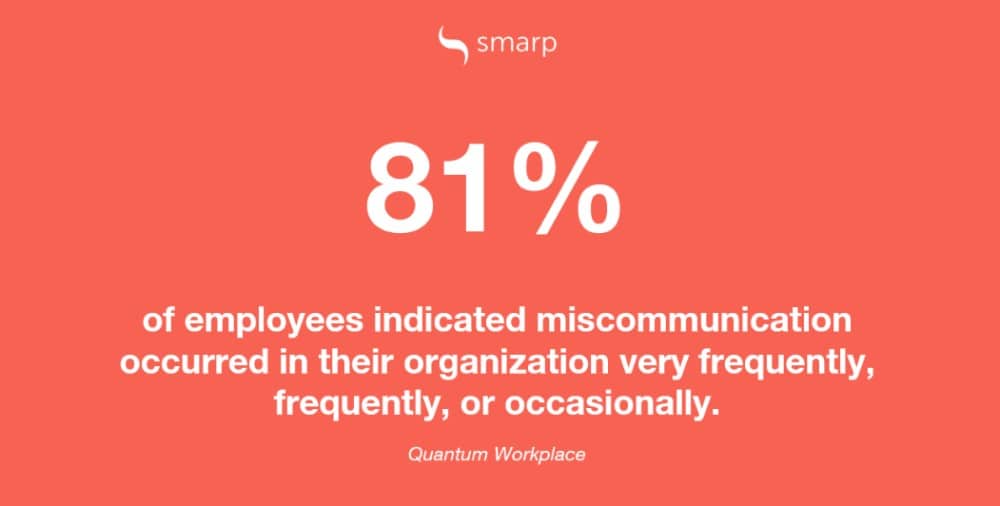
What if the Visioning Process Can’t Involve a Large Number of People?
There are instances where a business vision developed solely by the senior executive team or leader generated enough vigor and inspiration to spark an organizational-wide transformation. In these cases, either the leaders were admired and charismatic rather than feared, or the organization was in crisis and everyone knew it. In other words, they thought the new course set by the leaders was necessary, accurate, and compelling. In these circumstances, the leaders may create the vision on their own before coming up with an effective rollout plan.

Exercise 1.3 : Back-to-Back Drawing
Not often do people interpret our communications the way we expect them to. What could you say to lessen the possibility of misunderstanding in actual conversation?
What aspects of your drawing may have been different if you and your partner had been able to communicate?

Course Manual 4: Change Readiness
What does Change Readiness mean?
An organization’s level of preparation for change can be measured. Any level, any scale, and any purpose of change are all possible. Examining an organization’s readiness for the change they want to undertake is the goal of change readiness assessment. This enables the implementation of more suitable procedures to successfully carry out the intended transformation. For instance, the assessment may be useful in identifying particular unfavorable attitudes or beliefs about the change that are held by large numbers of employees and are motivating them to withdraw from or fight it. The information collected can then be utilized to develop strategies for reducing the effect and raising engagement, which will facilitate change for all parties.
This course manual aims to educate readers about the influence change readiness assessments can have on organizational change outcomes and goal achievement. The discussion will focus on employee health in particular and how it can affect both the success of organizational change and how well it is implemented. A multitude of things, such as communication, adequate training, and social support, promote employee wellbeing. How is employee wellbeing related to successful results following organizational change? These are the two main topics this paper will address. And how might assessing change readiness help to enhance results by enhancing wellbeing?
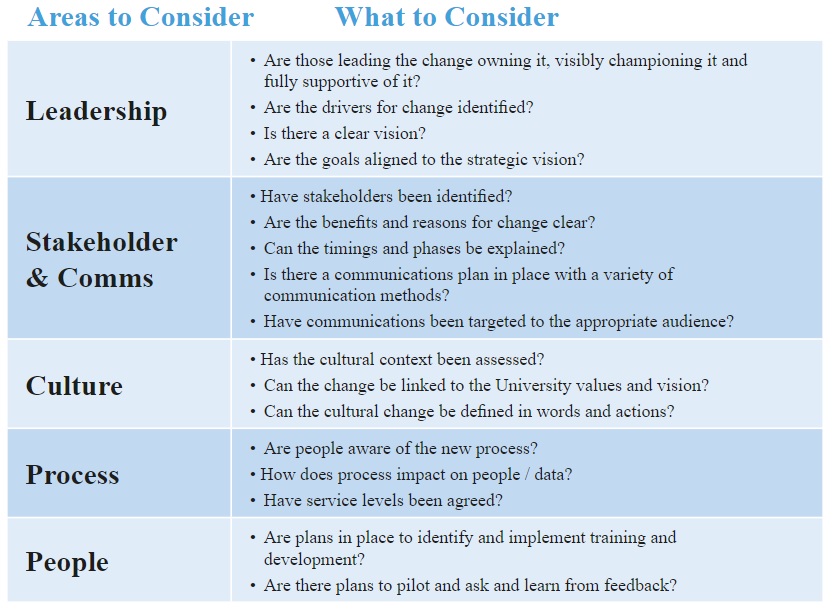
7 Ways to Determine an Organization’s Readiness for Change
One of the worst mistakes leaders may make when starting a significant change initiative is failing to evaluate the organization’s readiness. They run the risk of forcing change on a company that is incapable or unwilling to accept it. Executives frequently ignore an organization’s ability to make the change because they are so focused on what they have determined to be the best answer. This causes individuals to drastically underestimate the time, money, and effort needed to succeed. Ironically, the leadership’s proactive involvement in assisting, empowering, and training individuals to effect change is critical to the success of the effort. To do that, they must first evaluate their current situation and identify any holes that need to be filled.
Let’s use climbing Mount Everest as a common metaphor for a challenging task to help you visualize this. Would you send someone to climb Mount Everest without considering their physical and mental capabilities to handle the journey? Would you send them knowing that they lack the necessary climbing skills? Would you send them without getting the necessary oxygen, mountaineering gear, a guide, or Sherpas to help them first? Similar to this, failing to prepare your business for change puts its staff, clients, leadership, and shareholders at danger.
However, executives frequently ask their teams to undertake significant change initiatives without giving them the instruction, resources, or tools they need to succeed. Even the most dedicated workers can get overwhelmed by the demands of the journey, leaving them helpless, disillusioned, skeptical, and disengaged. As if things couldn’t get any worse, some leaders want them to repeat the process repeatedly.
How Can I Tell If My Organization Is Change Ready?
The likelihood of success is increased and risk is reduced when change leaders construct their plans after first assessing their organization’s readiness for the change. At a minimum, these seven crucial components should be evaluated and the data collected in a good readiness assessment:
1. The ability of the leadership to drive change: People must first believe that the leaders are qualified and able to drive change. Employees will determine right away whether the leadership is credible, knowledgeable, and capable of leading the transformation. Even if the change is the right one, people are less likely to embrace it and put out the extra work necessary to make it successful if they feel that the leadership is missing.
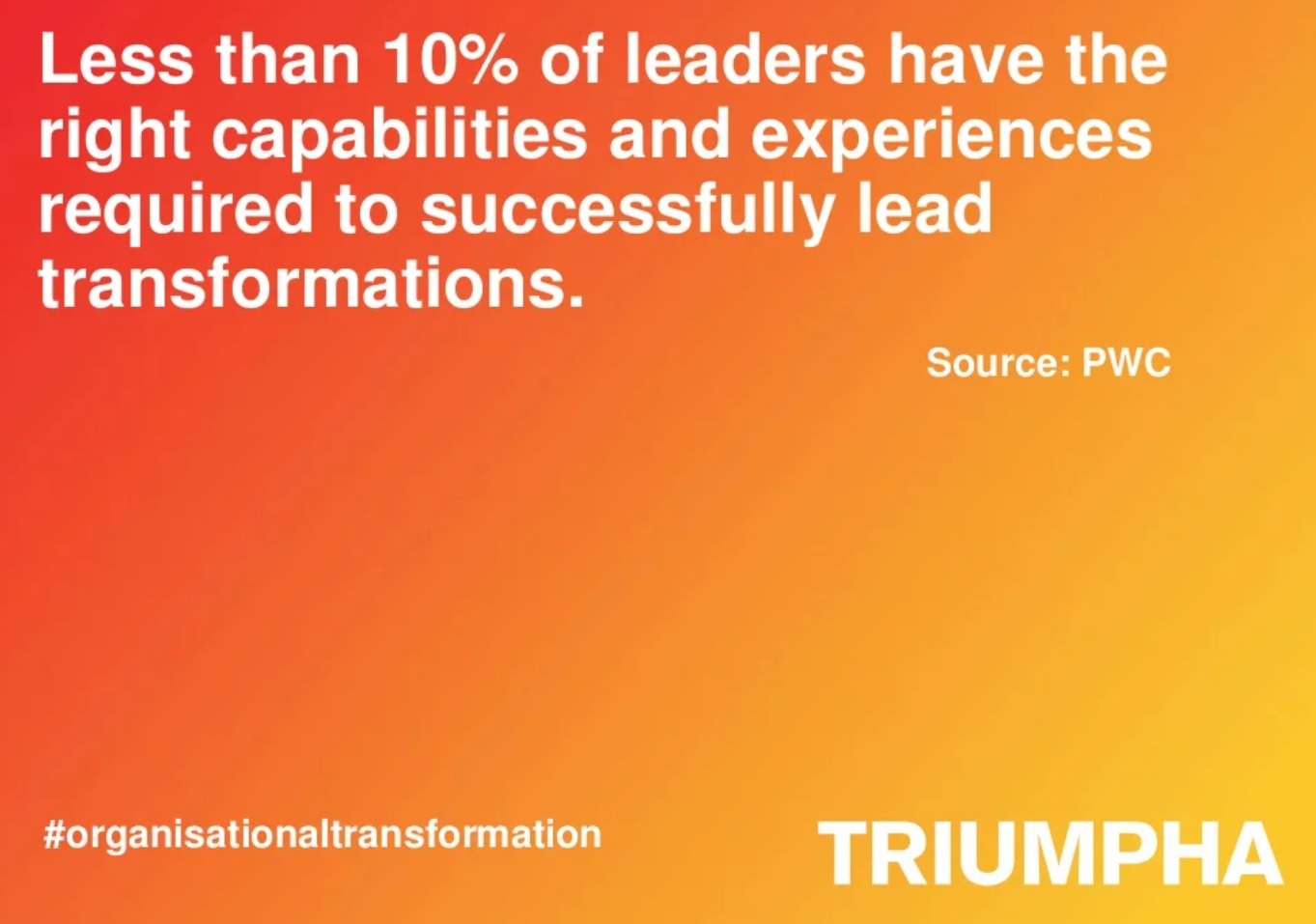
2. The adaptability of middle management: In every change, people managers play a crucial role as the main channel for information, feedback, and overcoming opposition. Management can also be a major obstacle if they do not comprehend the change or are unwilling to support it. The degree of success is strongly influenced by the amount of encouragement, zeal, and effort individuals managers devote to fostering change. To make sure the organization is ready, it is essential to evaluate their situation.
3. The organization’s experience with change: This focuses on both the extent to which prior initiatives have benefited the organization and met their objectives as well as how this has happened. It may be a sign that an organization is not prepared to accept new change if past change attempts were failed, took a long time to provide benefits, or were launched with little concern for the individual change process (see ADKAR).
4. The urgency of the change: This section of the assessment aims to determine whether or not the organization’s employees are aware of the need for change and believe that the time is right for it to happen. People may determine it does not fit into their priorities and either fight the change or choose not to adopt it if they are unaware of the need or do not believe it to be urgent.
5. Capacity for change: Workers will evaluate their own capacity for change. They won’t likely accept it if the foundational elements in points 1-3 are not established, if they are overburdened with everyday tasks or feel they lack the time, money, or expertise to create change. Similar to this, if they are already stressed out by changes that are already underway, they may become change tired and be unable to handle the emotional and mental strain of another change.
6. The Impact of the Change: Analyzing and being ready for the organization requires understanding the impact of the change on the group and even the individual level. We frequently discover that organizations have chosen to just focus on the future state rather than taking the time to identify the distinctions between the present and future states.
Without knowing what the change is and how it will affect people’s everyday tasks, individuals are left to make their own assessments. Without the right information, this might cause people to make snap judgments, misinterpret the details, give in to rumors, or simply decide not to handle the change at all.
7. The reason for the change: One of the realities of the present workforce is that they need to believe that the change is not only in the organization’s best interests, but also in their own. They need to understand whether the change will enable them to fulfill their role in the organization. According to research, people will go to tremendous lengths to adopt change if they believe it will serve a cause they can get behind.
They are unlikely to prioritize the change if it does not support their individual needs and aspirations. While this is sometimes referred to as their WIIFM (what’s in it for me), it can also relate to a bigger goal they feel their employment with the company is helping to achieve. It is doubtful that the organization is prepared for the change if the cause behind it is not obvious, compelling, or articulated on an individual level.

Case Study: Change Transparency
For your story to be successful, it must begin with the company’s primary goal before presenting a compelling and motivating future vision. How are the adjustments you make today assisting you in realizing your future vision is the question you want to respond to.
For instance, in 2017, FMC Corporation was getting ready to purchase a major chunk of DuPont’s Crop Protection business, making FMC the fifth-largest crop protection company in the world. They created a unified internal communications campaign called the “Nature of Next” as part of their change story to explain the rationale and goals behind the purchase.
The marketing campaign described how FMC will gain a wider product range, a larger global footprint, and full-discovery R&D capabilities — all of which help them realize their goals of assisting clients in providing sustainable food for a growing population. Even though the integration process was still in progress, the ad raised awareness and excitement of the purchase among the staff and was utilized to convey the potential of the new FMC.
Events of change are frequently unpredictably unstable, distressing, and risky. But having a distinct meaning or objective for the change can help you make your argument. Employees will also get a better knowledge of the business strategy if you can explain this case in detail.
Organizational preparation is not, of course, a binary issue. Since readiness is a continuum, leaders will need to constantly assess the situation to see if additional preparation is necessary. Unfortunately, the trend is to never bring up these subjects at all.
There are several causes for this. Many often, leaders are unaware of the requirement because they have not received adequate training in the human aspects of change. For some, if the change is the right one, they think that the staff will readily accept it and embrace it wholeheartedly. Others might believe that bringing up these issues will lead to resistance or, at the very least, prompt difficult queries regarding the shift.
Evidence-Based Review on the Relationship Between Change Readiness and Employee Wellbeing
One of the most recent studies by UWE Psychological Sciences in Bristol examines the relationship between employee wellbeing and change readiness. Given recent events, workplace wellbeing has become a hot topic (and rightfully so), making this research particularly pertinent at this moment.
A Global Trend That Is Going The Wrong Way?
It’s crucial to recognize that organizations around the world are increasingly implementing change incorrectly. Mosadeghrad and Ansarian (2014) reviewed over 56 research to determine what obstacles stand in the way of successful change implementation. The most often cited obstacle to successful change implementation was human resource issues. This included inadequate education and training, a lack of employee involvement, resistance to change on the part of the workforce, a lack of success-based rewards, and job-loss anxiety. This study shows that there are several possible obstacles that could prevent successful change implementation when employee wellness is not prioritized. In organizations where workers are more content, the converse is true. Employees with higher levels of wellbeing are more likely to have the tools necessary to support their organization’s successful transition, according to research by Battistellu et al. (2014). Simply said, businesses with happy employees who are asked about their welfare tend to have better results after change.
According to studies, organizational change frequently has negative effects. A study conducted in 2013 by Bryson, Barth, and Dale-Olsen examined the effects of organizational transformation on 13,500 employees from more than 1000 organizations. They discovered a link between higher job-related anxiety and lower job satisfaction and organizational transformation. Smollan (2015) confirmed this, finding that organizational change was accompanied with an increase in psychological demands, a higher workload, uncertainty, and a loss of social support from supervisors and colleagues—especially during the early stages of organizational change. In agreement with this, Di Fonzo and Bordia (1998) discovered that the uncertainty around the experience and the results is one of the most challenging aspects of the process of organizational change. The wellbeing and job security of employees were found to be strongly correlated with this uncertainty. Numerous other studies have discovered a connection between organisational change and a feeling of uncertainty, which can result in a diminished sense of control and, in turn, psychological discomfort, an intention to leave their organization, and job unhappiness (Bordia et al., 2004; Paulsen et al. 2005; Rafferty & Griffin, 2006). These studies demonstrate that when employees are not ready for the shift, organizational transformation can be harmful to them. According to research by Pollard (2001), the anticipation stage of organizational change is when uncertainty is most prevalent and is associated with a rise in cardiovascular diseases and psychological health issues. Additionally, according to Pollard, management typically simply provides a few general details regarding the change to employees. Organizations aren’t spending enough time supporting their employees during the transformation process, which can have a huge negative impact on employees.

Exercise 1.4: The Magic Wand
Group the participants initially into teams.
Then, ask them to imagine that they own a magic wand that has the power to alter any situation in this world.
Now tell them to describe the changes they would want to see. Give them some time to talk after that.
Finally, using their magic wands, each team should describe what they would like to change.
How did your group arrive at the solution? Did everyone accept this solution, and if so, why?
Did anyone mention wanting to use the magic wand to change themselves? Please elaborate.

Course Manual 5: Emotional Journey
People frequently emotionally identify with the current situation when compelled to change inside an organization.
Change has the potential to elicit an emotional response. Employees and leaders may experience personal loss, worry about what will be expected of them, and uncertainty about their capacity to meet any new demands even before a change is launched.
A desire to maintain the status quo and a lack of trust that the change would be successful and address pressing issues are typical responses to change. These responses are a reflection of the emotional stages that staff members experience when going through change.
It is the responsibility of leaders to prepare those who will be impacted by change once these emotions start to emerge.
The emotional journey of Transformational change
You can choose what action to take in response by being aware of the various phases that people may go through.

Here is our view of the emotional stages people go through during changes and steps you may take to help them move toward acceptance and adoption, building on the outstanding work of Dr. Kubler-Ross.
Phase 1: immobilization
Symptoms
• Difficulty concentrating on their duties and employment
• Demonstrate a lack of understanding of the shift and sentiments of shock and confusion about what to do next
Suggestions for Action
Share the most important information about the change and its motivations; repeat it several times; know the best ways to reach your audience; use a variety of techniques and language; and encourage people to participate and contribute.
Phase 2: denial
Symptoms
People in denial have beliefs such as “They won’t do it,” “They will start but not finish,” or “We won’t really have to do it anyway.” They ignore discussions about the change.
Suggestions for Action
Give examples of what is currently not working well; break change down into smaller parts and concentrate on what to expect initially; and assist people in understanding why each step is required and how they can support the change.
Phase 3: Anger
Symptoms
• Inability to see anything positive about the situation
• Time is spent quietly or publicly expressing their negative thoughts
Suggestions for Action
Don’t take it personally; acknowledge and diffuse the anger; empathize with the anger; provide an opportunity for open communication about their issues and establish ground rules; and consider one-on-one sessions.
Phase 4: Depression
Symptoms
Realizes that their function and duties are changing; appears indifferent in the change; loses excitement for their work; thinks the organization won’t act on their proposals.
Suggestions for Action
Encourage employees to communicate their challenges and worries to their management; let them know about the resources that will be available to assist them; and assist them in realizing their value and place in the future.
Phase 5: Negotiation
Symptoms
• Make an effort to get an agreement on what is required of them, the extent of the change, the remedy, or the timeline.
Suggestions for Action
• Only discuss the components of the ideal state that are actually negotiable
• Make it clear which aspects of the ideal condition, if any, are negotiable.
• Whenever possible, be willing to negotiate. Recognize the repercussions of making concessions to a specific group or individual as opposed to the general public.
Phase 6: Exploration
Symptoms
• Questioning the future state and their place in it • Improving participation and information exchange
• A more upbeat outlook
Suggestions for Action
• Recognize their accomplishments
• Stress the need of their cooperation
• Motivate them to keep moving forward
• Highlight the benefits of the shift
• Create opportunities for them to get involved in addressing or comprehending the less favorable aspects of the change
• Make support and education initiatives known.
Phase 7: Acceptance
Symptoms
• Participate in assisting others in comprehending and accepting the change
• Provide support and feedback
• Take advantage of learning and communication opportunities
• Display competence and helpful behaviors
Suggestions for Action
Recognize their accomplishment and commitment to the success of the change; comprehend what motivated them to embrace it and share it with others; enlist their assistance in assisting others in doing the same; and communicate the progress being made toward success metrics.
Why It’s Important To Give The Emotional Aspect Of Transformation Priority
Maintaining clear and regular communication with your staff at a time of organizational transition is crucial. You need to be attentive to the variety of emotions exhibited by those affected in order to properly comprehend and prepare them.
Working in organizations frequently requires us to leave our emotions outside the door as we approach the office. Despite what may be happening around us, it may not be “done” to show our feelings at work. Organizational change, however, can cause a range of emotional reactions among people.
Leaders and managers frequently see emotional responses to change as a burden they must bear and, in some cases, even ignore.
However, this is a mistaken strategy because emotions play a crucial role in any change process because they not only convey a person’s feelings about the change, but they also influence their behavior, which can have an impact on how successful the change is.
Individuals and teams can react to change in very different ways.
Change can energize and inspire some people, who see it as an opportunity for invention, development, and creativity.
These people will engage in the change’s execution and adjust to the changes it brings, and they may sense hope, eagerness, and faith about what the change will produce in the future.
Others, on the other hand, can completely reject the reality of the shift, believing that nothing can affect the way they operate unless it is put into practice and becomes business as usual. These people are commonly compared to ostriches who have their heads in the sand.
Acute Anxieties
Others experience severe anxiety when something changes because they believe it could be harmful to them.
These people are more likely to be resistant to change, engage in active or passive opposition, and express negative feelings such as anger or fear in response to the change.
Some people are excited by fear while others are terrified.
People will feel both happy and negative emotions at the same time, in addition to just one or the other.
When a departmental restructure is announced, for instance, some people may experience a range of emotions, including dread about the possibility of job losses and desire for the department’s performance to improve as a result of the restructure.
Depending on the nature of change and the personalities involved, reactions to change will differ. Some people will resist the change “to the death,” persistently disputing its necessity, while others will readily accept it and be prepared to make adjustments.
The majority of folks fall someplace in between.
When an organization is changing, emotions can spread.
Through verbal and nonverbal interactions, they can permeate an entire department, team, or organization and influence others’ moods.
People will respond to and infer meaning from other people’s emotions, particularly those of managers and leaders. Therefore, managers and leaders must be mindful of both their own emotions as well as those of their employees.
It matters what emotions leaders and managers exhibit, as well as how these emotions are evaluated, communicated, and transferred within an organization during a change process. This is because the emotions they exhibit can spread to their teams and other employees much like a virus, and this contagion can have an impact on the emotions and behaviors of employees.
Others experience severe anxiety when something changes because they believe it could be harmful to them.

Case Study
Gary Hamel and C.K. Prahalad’s tale of four monkeys sitting in a cage with a bunch of bananas dangling from the roof and being reached by a set of steps serves as an effective illustration of the power of mindsets. The blast of cold water prevents the monkeys from climbing the steps to reach the bananas. Eventually, the monkeys give up. The water hose is then disconnected by researchers, who then swap out one of the original monkeys for a new one. It starts up the steps after spotting the bananas. What transpires? Being sociable animals, the other monkeys pull it down before it is doused with water. This keeps happening, and eventually the new monkey stops bothering to go after the bananas as well.
The remaining original monkeys will be gradually removed by the researchers over the coming weeks, and they will be replaced by new monkeys that have never seen the water jet. Even though there is nothing left to impede the monkeys from getting to the bananas, the others constantly drag the new monkeys down.
No monkey attempts to ascend the steps, even though by the end of the trial, none of them have ever seen a jet of water. You don’t grab the bananas around here, they have all learned.
What engrained employee attitudes or unspoken rules are impeding your company’s efforts to improve? Asking “why” repeatedly will help you identify these mindsets and deal with them in ways that will improve employee engagement and corporate performance.
Undoubtedly, change brings up a wide range of emotions.
Emotions then create their own unexpected concoction that can shape, direct, or prevent change.
Trying to control emotions can be difficult because they affect the entire individual and make each person unique. Since different emotions call for varied reactions, emotions cannot be controlled “en masse.”
Additionally, the same feeling might have extremely diverse outcomes in various contexts. For instance, rage can motivate someone to take uncalled-for actions or it might render them helpless through fury.
Some people are excited by fear while others are terrified. While intense and unmanaged fear and uncertainty feelings can paralyze any attempt at change.
This can be made worse by organizational cultures that disregard emotions and their significance rather than acknowledging them.
Therefore, leaders and managers should acknowledge emotions that may arise in response to change rather than disregarding them. They should also take the time to understand what is motivating these feelings.
Trying to control emotions can be difficult because they affect the entire individual and make each person unique.
Several useful recommendations to assist managers and leaders in comprehending and navigating emotions during transformation
Respect other people’s viewpoints
It’s critical to understand how employees view change from their perspective. Recognize the circumstances that lead to happy sentiments, and promote a work environment that fosters and sustains positive emotions that have an impact on how people feel, think, and behave.
Also be cognisant of negative emotions, understand what prompts them, and analyze how they might be treated.
Recognise and appreciate powerful emotional reaction
Since emotion usually shows itself in verbal and nonverbal cues, this is usually quite simple. However, there are times when rage may be suppressed, despair may be concealed, or seeming cheerfulness may mask sorrow.
A just and equitable transition process
Make sure the procedure utilized to help people adjust to the change is reasonable, open, not unduly complex, and regularly followed.
Give pertinent instruction
It can be beneficial to provide instruction and coaching on how to effectively interpret the nuances of social cues and signals given by others in order to ascertain the emotions being displayed and comprehend the viewpoints of other people.

Exercise 1.5: Alternate Seats
Another quick and simple game is being played here. The participants are invited to switch seats so they can experience the feelings and emotions that are frequently connected to change. The facilitator should ask students to switch seats once everyone is settled in and feeling comfortable.
• How did you feel when you were asked to switch seats?
• Did you see moving seats as a chance to meet new people or as an unwelcome or unpleasant change?
• What are some factors that cause resistance to change in people?
• What can you do to ease employees’ acceptance of the changes in your organization?
Why is it challenging to keep adjustments that have been made?
What kind of assistance is required to keep the modifications in place?

Course Manual 6: Change Engagement
Involving Employees In Change
Your workforce will react to the change process more favorably the more they comprehend and accept the necessity for business change.
Your employees could dedicate themselves to their work for your company. Be mindful that their jobs may play a big role in their ability to maintain their financial security, sense of self, and sense of purpose, as well as their professional advancement. Role changes could have a significant professional and psychological impact.
Your team might need to deal with their feelings of loss. Their involvement and comprehension will be encouraged, which will enable them to approach change activities with positivity and purpose. Take into account these suggestions to involve your staff in the transition process.
How to Involve People in Transformational Change in 9 Steps
The organizational behavior for transformation Kotter + 1 procedure
The commercial world is evolving more quickly than ever. The IT industry usurps itself practically every day. In order to keep ahead of the competition, businesses must now compete more fiercely than before. The need for change is both required and unavoidable due to the interaction of technology, rules and regulations, shifting customer behavior, and competitive forces. People, however, resent change. They feel fear.
You’ll discover how organizational behavior may include people in radical change in this manual.
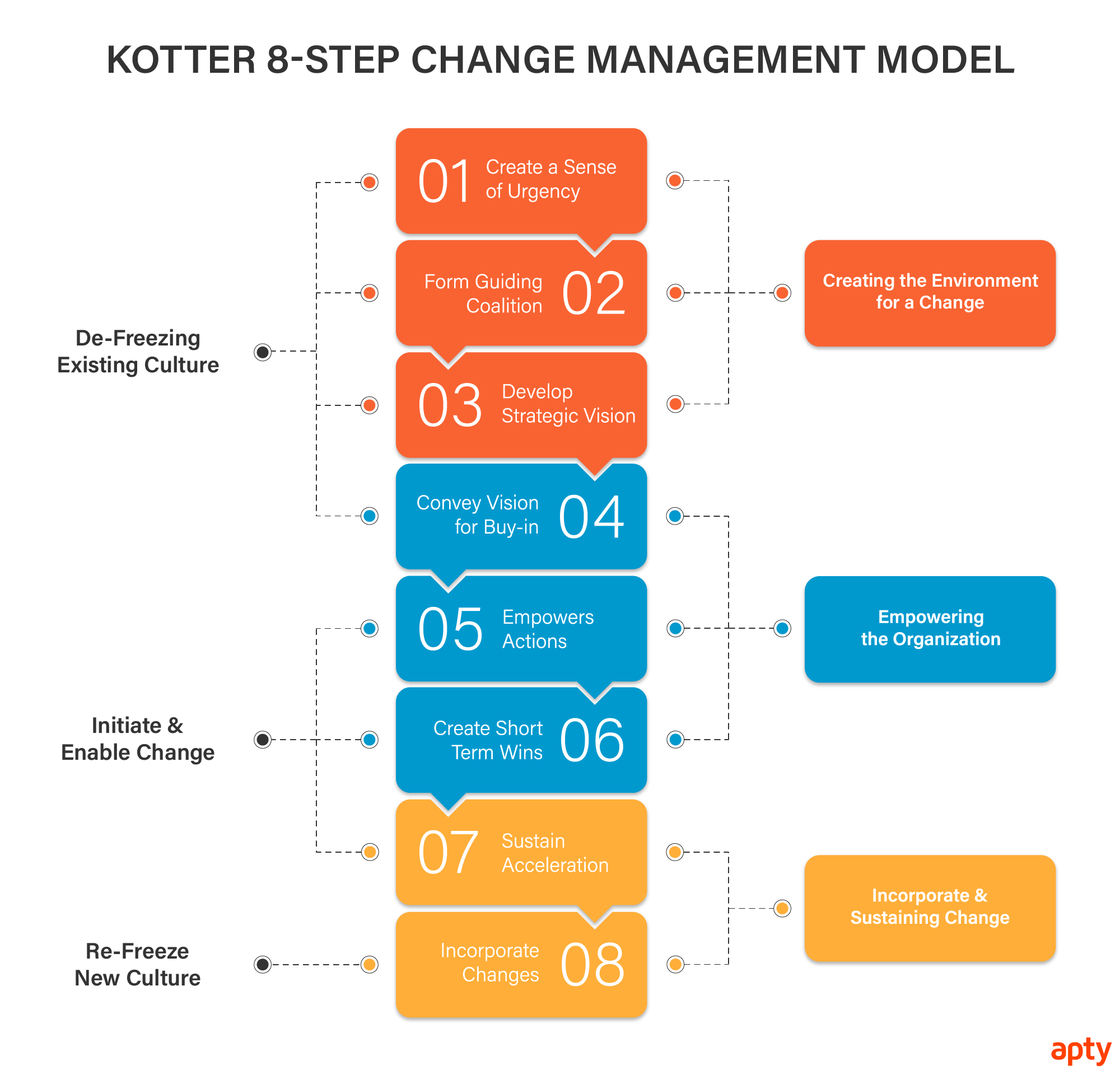
Organizational conduct and change leadership
Although there are other methods for managing change, the majority of them are based on the eight-step model created by Dr. John Kotter and detailed in his book “Leading Change.” However, only adhering to this paradigm won’t be sufficient to bring about successful and long-lasting transformation. Your company will need to adopt and modify the organizational practices necessary to involve workers in the change-management process at all stages.
Step 1: Make it urgent
To motivate everyone in the organization to seek change, you must instill a feeling of urgency. Talking about your competitors or discussing your disappointing sales figures won’t help.
Identification of hazards and opportunities is a necessary organizational behavior.
• Promote candid and open dialogue. In team meetings and on the company intranet, get the conversation going.
• Encourage participation from all parties involved, like as customers and suppliers, by involving your employees.
Step 2: Create a strong coalition
Take the initiative and include your top executives in persuading staff members that change is necessary. In order to create momentum for change, identify change sponsors across your business from all angles.
• Ignore conventional hierarchies and pinpoint the natural leaders inside your organization at every level.
• Create a team of influencers with members from different departments and a range of expertise.
• Recognize that your team will have weaknesses, and work to eliminate or cover them.
Step 3: Develop the change’s vision
All stakeholders must be able to clearly see the future in order to comprehend the need for change and the goals of the change project.
Organizational behaviors required:
• Ensure that each member of your change coalition is aware of these values and objectives, and develop a description of your shared future vision.
• Ensure that everyone in the change coalition is able to enthusiastically discuss the change project and future vision.
Step 4: Share your future vision with others.
Organizations all too frequently inform their employees that things will change without ever explaining why, how, or what will change will bring. It will be necessary to express the benefits and justifications for change frequently and loudly. The message will face stiff opposition from “business as usual” communications, therefore change must be given top priority if it is to succeed.
Organizational behaviors required:
• Ensure that your staff members are skilled at handling problems.
• Center all communications—from training and performance reviews to operational procedures—on the change.
Step 5: Get rid of change-averseness
Change faces numerous challenges. Employee opposition is the main issue, and it has the power to derail reform. Employees may interpret “change” as code for “downsizing,” particularly in the age of international markets and automation. It’s crucial for a leader to calm your team’s anxieties while assuring them that this isn’t what you mean. If this is what you mean by change, you should deal with it immediately because it’s likely to lead to more demoralization. Your team must be organized to work to its full capacity. Change leaders must be used, and roles and tasks must be assigned in accordance with each person’s skill set. There are still additional tasks you must complete.
Organizational behavior required:
• Feel strongly about the possibilities for all and the change.
• Ensure that your leaders manage change in a compelling manner rather than an authoritative one.
• Encourage staff members to share their thoughts, and recognize their contributions to bringing about change.
• Be ready to adjust your organization’s structure and compensation plans to align with the long-term goals.
• Act swiftly to persuade change-resisters to leave if it becomes evident that their attitudes won’t change. • Encourage change-resisters to recognize the advantages of the change.
Step 6: Produce quick wins
Aiming for one overarching objective can be intimidating and disheartening. You never seem to really advance. Similar like making goals to stop smoking, get in shape, or produce a book. Set more modest, more immediate goals as you go toward the future vision (e.g. cut out that first cigarette, lose two pounds in the first week, write a chapter a week, etc.). Make the goals challenging but attainable so that they have a good probability of being met.

Organizational conduct is required:
• Allow all employees to set milestones; make it both a personal and a team goal.
• Encourage staff to explore the advantages of reaching each milestone and let them identify any potential obstacles.
Step 7: Compile victories and expand the change
Celebrate each milestone as it is reached, but never let your guard down. Another step toward realizing the goal has been accomplished. You must now expand on this by analyzing what worked well and learning from mistakes that were made.
The following organizational practices are required:
• Be open with all stakeholders and encourage them to express their opinions.
• Recognize and acknowledge those modest victories to continue the loop.
• Agree on the subsequent objectives.
• Be adaptable in your approach and spot change agents as they emerge during the transformational process.
Step 8: Implement the company culture improvements
You must make sure that new procedures, systems, and ways of thinking and working become ingrained in your business culture once you achieve the future goal you have set for yourself. Make sure the advantages of the move are obvious throughout your organization and that your leaders continue to support it.
Organizational behaviors required:
• Talk about the change at team meetings, one-on-one conversations, board meetings, customer presentations, and any other situation that presents itself.
• Center the hiring process around the new ideals.
• Publicly recognize significant participants, change sponsors, and staff influencers.
What should you do next now that your change project has been completed successfully?
Step 9: Repeat the process.
Change is the only constant in business. Technology, rules and regulations, shifting customer preferences, and competitive pressures all work together to make change both necessary and inevitable, as I mentioned in the opening paragraph. The corporate world is a dynamic environment. Just because a significant transformational change has been effectively implemented does not indicate that additional change is not essential.
• Be open to suggestions from the floor because your employees and sales representatives will be crucial to sustaining change.
• Create a route for employee empowerment by being open with communication, offering room for improvement, sharing solutions, providing assistance, and showing appreciation.
• Promote intercultural understanding.
• Ensure that managers and leaders value input and behavioral justifications.

Case Study: Scale by Activating The Network
Cases of firms going through transitions reveals that initiatives actually succeed by expanding through informal networks, which are non-linear. Managers frequently plan initiatives to be linear, hierarchical, and based on persuasion. By enabling advocates to share their enthusiasm with others, who can then recruit more people, they are able to grow slowly at first and then swiftly.
The creation of tools that help folks who are enthusiastic about change is one highly effective tactic that successful skill-based transformations employ. For instance, Chamkasem set up a “API Center of Excellence” team at Experian to assist in the planning, development, and implementation of cloud-based solutions. The PxG initiative of Procter & Gamble holds weekly calls with each of its six nodes in innovation hubs all over the world.
However, the creation of tools that allow peer-to-peer reinforcement through shared learning and shared experiences enabled by technology that enables the movement to scale is frequently more crucial than direct empowerment from the center. For instance, Philip Morris International’s FastForward initiative has established a variety of resources to support its extensive network of enablers and aims to promote lean enterprise and design thinking ideas throughout the company.
Vincent Ducret, who is in charge of the project, said that if it had remained centralized, “We could never have scaled FastForward.” On order to assist the local markets share best practices, motivate one another, and support the program’s growth and integration into the DNA of the workforce, we developed solutions like as an online portal and groups in services like Microsoft Teams and SAP Jam.

Exercise 1.6: Balloon Frenzy
Have a bunch of inflated balloons in a variety of colors at first. Next, divide the group into small teams.
Now, depending on the size, distribute an equal amount of balloons to each group. Make certain that the balloons for each team are a distinct color.
Each team should hit to keep their balloons up, but they also need to hold them. Balloons that land on the ground must also be removed.
Check to see which team managed to keep the most balloons in the air.
Make sure to clear the field of any dropped balloons. In that case, you can designate a non-participating member.
What about this activity struck you as both intriguing and difficult?
Did you experience any failure dread when performing this exercise? Why, if so?
“You’ll work better as a team member if you’re more adaptable.” Do you concur? Why, if so?

Course Manual 7: Change Leadership
Change management: Transactional vs. Transformational Leadership
In addition to inspiring or motivating individuals to achieve excellence at work by attaining the pre-defined goals, leaders play a critical role in guiding organizational change. Effective leadership establishes a favorable culture, atmosphere, and values for permitting a particular expected code of conduct or behavior out of employees. It also provides direction and vision to the people from top to bottom.
Leaders develop and implement appropriate strategies for promoting ongoing process improvement, inspiring people to provide above-average performance, and facilitating change across diverse functionality.
Depending on the corporate context, external variables, and long-term goals, leaders can play both transactional and transformative roles.
Transactional Leadership
Transactional leaders operate in line with specified modes of operation and are more concerned with maintaining continuity in day-to-day operations, making sure that everything runs smoothly by putting systems and processes in place, and concentrating on achieving goals.
Such leaders can impose punitive measures, create a systematic framework, specify a course of action, develop and carry out policies, and encourage exceptional performance through systems of rewards and incentives.
A transactional leader is more concerned with ensuring that the tasks assigned are performed on schedule by reaching the quality criteria than with futuristic vision or tactics for gaining market leadership.
Transformational Leadership
It would be more accurate to argue that the true champions of change are the transformational leaders. They are the leaders who inspire or persuade teams to excel in their corporate performance.
Instead than focusing on completing routine organizational tasks and obligations, transformational leaders prioritize the creation of cohesive teams and support a collaborative environment for reaching the next best level of performance.
More emphasis is being placed on team building, employee empowerment, goal alignment between individuals and organizations, and culture development to inspire people to embrace the better change.
The following are the main duties carried out by transformational leaders:
• Developing a Vision: Transformation Leaders are in charge of developing a vision and seeing to it that it is shared and communicated at all levels in order to encourage and inspire employees to pursue excellence at work.
• Developing a Vision: Transformation Leaders are in charge of developing a vision and seeing to it that it is shared and communicated at all levels in order to encourage and inspire employees to pursue excellence at work.
• Setting an example or modeling behavior: Transformational leaders motivate their teams by modeling or exemplifying desired behaviors.
• Setting Standards: Well-defined standards and norms direct personnel in adhering to a desired pattern of behavior and working cooperatively to achieve shared objectives.
• Building an environment and culture that promotes mutuality, interdependence, and flexibility is one of transformational leaders’ main responsibilities. An encouraging workplace culture can inspire employees to provide superior performance and go above and beyond expectations by hitting new professional milestones.
• External Communication and Liaising: Transformational Leaders communicate with the outside world and serve as the primary point of contact for important stakeholders in order to obtain resource support, technology aid, and information on the finest operational procedures of top-tier firms. In essence, this job entails fostering relationships with stakeholders or business partners.
• One of the most crucial responsibilities performed by leaders who adopt a transformational leadership style is team building or synergy, which involves fostering an environment that is positive and conducive to working together to complete tasks.
• The major task of transformational leaders is to identify the greatest talent within the talent pool and to nurture that talent by providing proper training and development support.
Model of transformational leadership
The transformational leadership paradigm and style are characterized by four key factors. Bass created the following criteria in 1985 to help define transformational leadership and provide guidance on how to succeed as this kind of leader:
• Idealized influence: Setting an example for others is the most crucial thing a transformative leader can do. As a role model for behavior in all facets of the workplace, employees will look to you. If you set a high bar for performance and lead with sincerity, your team will notice and be motivated to meet it. It’s not about coercing staff into putting in extra effort; rather, it’s about setting an exemplary example and having a positive impact on others via a dedication to trust, transparency, and respect.
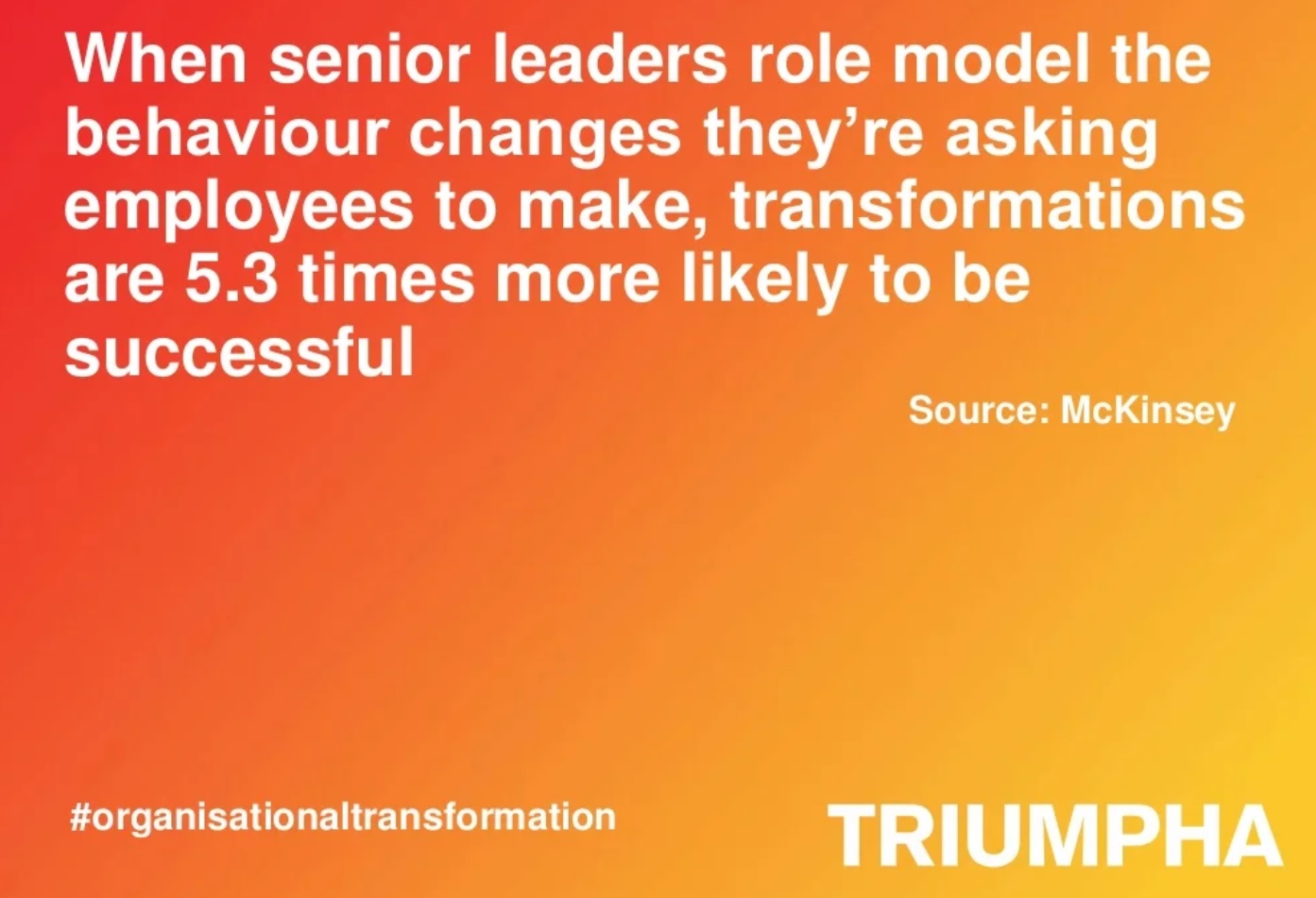
• Intellectual stimulation: To promote change, it’s necessary to push the status quo by promoting innovation, creativity, critical thinking, and problem-solving while also challenging ingrained business views. Employees should feel free to explore novel opportunities and ideas that may help the organization become more innovative under the direction of transformative leaders. You want to create an atmosphere that encourages development and gets everyone fired up about digital transformation and other significant organizational efforts.
• Inspirational motivation: As a transformational leader, you must inspire your staff to identify with and support the organization’s mission. Giving employees a strong sense of purpose, as opposed to trying to drive them through fear, can help you ensure that they are as devoted to these goals as you are as a leader.
• Individual consideration: Workers must feel independent and invested in the long-term objectives of the company. Understanding that each employee is a unique individual within the organization with particular requirements, mentorship preferences, and distinctive contributions to the firm is crucial for transformative leaders. These leaders will modify their mentoring and coaching techniques according to the needs of the individual, assisting them in achieving both internal and external organizational goals.
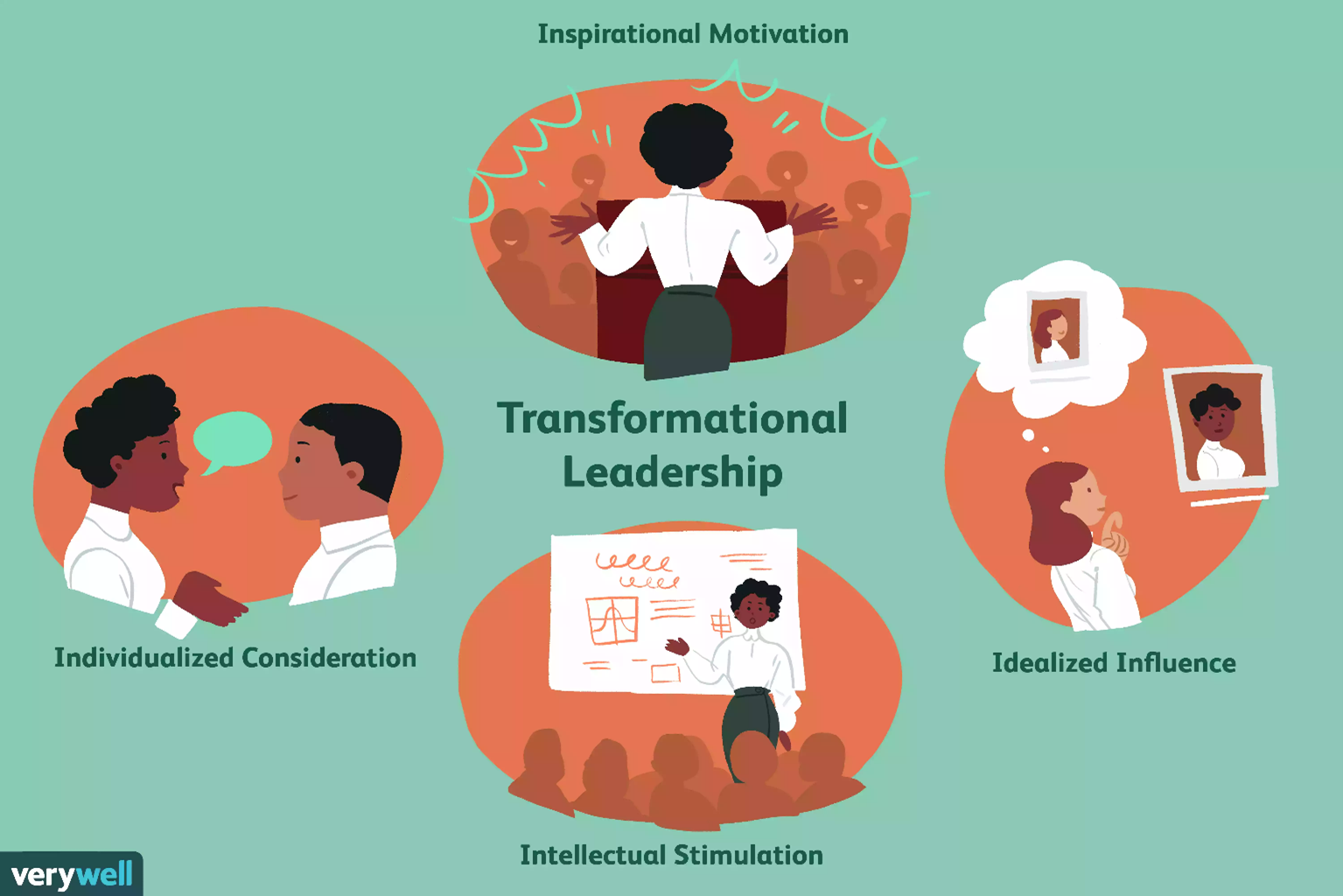
Transformational Leadership: advantages and disadvantages in the Workplace
Advantages:
• By fostering an engaging and challenging work environment, transformational leadership style promotes innovation and creativity in the workplace. Individuals have plenty of possibilities to develop and hit new performance milestones under this kind of leadership.
• Several followers may develop into new leaders.
• Visionaries, transformational leaders have a remarkable ability to communicate their vision to their people. Such leaders can deal with problems considerably more effectively because they are better at seeing the big picture.
• As a result of their leaders’ influence or inspiration, the team members strive to realize a shared vision or objective, fostering excellence at work.
• The relationship between the leader and the follower that is fostered by transformational leadership promotes mentorship and enhances organizational readiness for any kind of change process.
• Transformational leadership brings about changes to the established procedures, raises the bar for followers, and inspires them to go above and beyond the predetermined framework or expectations.
• Transformational leadership unquestionably ensures that teams work well and are more productive and grow.
Disadvantages:
• Though they are able to see the wider picture, transactional oriented people are more structured and detail-minded, thus they are needed to support transformational leaders because they lack this ability. Lack of thorough orientation could lead to a significant overlook that, in the long run, could harm the organizational interests.
• A lack of attention to the facts or realities through research, investigation, or information collecting may result from transformational leaders relying too heavily on inspiration, passion, and emotional factors.

Case Study: transformational leaders
The S&P and Fortune Global 500 corporations were examined by Harvard Business Review to identify the top transformative leadership cases. New “products, services, and business strategies; repositioning its core business; and financial performance” were the criteria used to evaluate these companies.
Jeff Bezos, CEO of Amazon According to Harvard Business Review, Bezos’ “insider, outsider” status contributes to his success as a transformational leader. He moved from the banking industry, and his years of expertise in a different sector gave him a unique viewpoint on e-commerce.
Netflix’s Reed Hastings For comparable reasons, Hastings and Bezos tied for first place. He was not entrenched in pre-established method and procedure in the broadcast industry because he was from the software industry.
• Jeff Boyd and Glenn Fogel, Priceline: Boyd and Fogel redesigned the travel reservation process by imposing reduced commission costs on bookings, but they concentrated on more specialized niche markets (inns, B&Bs, and apartments), eventually giving rise to Booking.com.
• Steve Jobs and Tim Cook, Apple: According to HBR, Jobs innovated on original Microsoft products while simultaneously creating a software ecosystem at Apple. With a continued emphasis on innovation, software, and customer loyalty, Cook has expanded on Jobs’ vision.
• Mark Bertolini, Aetna: In the healthcare sector, Bertolini is renowned for his pragmatic managerial style. He claims that developing tactics around a practical future vision is his main objective.
• Kent Thiry, DaVita: According to Harvard Business Review, Thiry transformed a failing company into a successful enterprise by upholding the organization’s basic values of “service quality, teamwork, responsibility, and enjoyment.”
• Satya Nadella, Microsoft: Nadella began working for the company in 1992 and gradually worked his way up the corporate ladder, managing the company’s cloud computing initiatives along the way, earning him an executive position.
• Emmanuel Faber, Danone: Faber began his career with the company as an architect before becoming CEO after contributing to the creation of the company’s aim to become a sustainable health and nutrition company.
• Heinrich Hiesinger, ThyssenKrupp: After taking over as CEO of the company in 2011, Hiesinger used innovative manufacturing techniques, such as 3D printing, to help reduce pressure from Asian rivals in the steel market. These “new growth sectors” now account for 47% of the company’s revenues.
Best Practices of Transformational Leaders in Business:
By releasing cutting-edge software programs and microprocessors, several technology behemoths like Apple, Microsoft, Intel, IBM, and many more changed the computing industry. Even the internet has changed in the modern day, with Amazon and e-Bay dominating the e-commerce market and Google continuing to lead as the most efficient search engine.
Industry Change in Financial Services: The advent of Internet platforms that allow investors to independently plan their investments, conduct research, trade stocks, and invest in a variety of financial products from anywhere in the world has had a profound impact on the financial services sector.
Pioneers who supported Mutual Funds like Peter Lynch and Index Funds like John Bogle changed how investors felt and preferred different types of financial portfolios. The low costs and diverse benefits of mutual funds and index funds have made them the most popular options for investors today.
Diversification: In the age of globalization and liberalization, corporations use a variety of strategies to grow their businesses internationally and keep a competitive advantage. A more agile and lean framework was implemented throughout the entire firm by leaders like Jack Welch, the CEO of General Electric in the 1980s.
Additional examples include business process outsourcing and knowledge process outsourcing, which have generated cost advantages for the organizations and improved business efficiencies, increased job opportunities for millions of people worldwide, and revolutionized organizational functioning overall. Once again, the use of high-quality tools and procedures such as TQM, Kaizen, Six Sigma, and others has enabled businesses to continuously improve their operations and meet high standards for quality in their manufacturing processes.

Exercise 1.7: skyscraper
The tower must sustain a marshmallow that is placed at the top and stand alone. Whoever has the skyscraper that is the tallest wins.
This exercise promotes teamwork, cooperation, problem-solving, creativity, and leadership dynamics.

Course Manual 8: Transformational Barriers
Why Most Change Occurs Too Slowly And What May Be Done To Remedy It
Recent news stories have mentioned Maplin, Toys R Us, Next, Mothercare, even House of Fraser, among other retailers. However, it can be challenging to identify precise trends that would indicate we are spending less. But it’s undeniable that our buying and behavior are changing, and reputable retailers appear unable to keep up. Why then do they not adjust enough quickly?
If you’ve ever tried to implement change within a company, you may be familiar with how difficult it can be. Even receiving finance clearance for change can be difficult and time-consuming, which makes us question if the effort is worthwhile. It might also be tempting to stick with outdated company practices and ways of thinking because it’s simpler, failing to notice the gradual changes taking place all around us until it’s too late.
We Are All Excellent At Adapting To Change
However, individuals and organizations have the ability to make significant changes extremely fast when the need arises. Hurricane season 2017’s quick response activities shows how effectively new infrastructures can be set up when people need to flee their houses quickly. In a few of days, significant improvement was achieved.
There is an unprecedented level of urgency due to the danger to human life. It is possible to overlook or rationalize away these minute changes in retail using a graph or a PR spin. But even while lives aren’t in danger in the case of these businesses, many livelihoods undoubtedly are. But what’s lacking in this situation is the drive to take action and the ability to predict what will happen before it’s too late. How then do we counteract that?
Innovation Is Encouraged By A Culture That Looks Outward
Complacency and indifference are two things that hinder transformation. They are signs of an inward-looking organizational culture, and many—I’d argue, the majority—of firms suffer from it. Contrarily, a lot of research demonstrates that an organization is more prone to acquire traits that impede or slow change the more successful and huge it becomes.
An organization’s likelihood of acquiring traits that impede or inhibit change increases as it gets bigger and more successful.
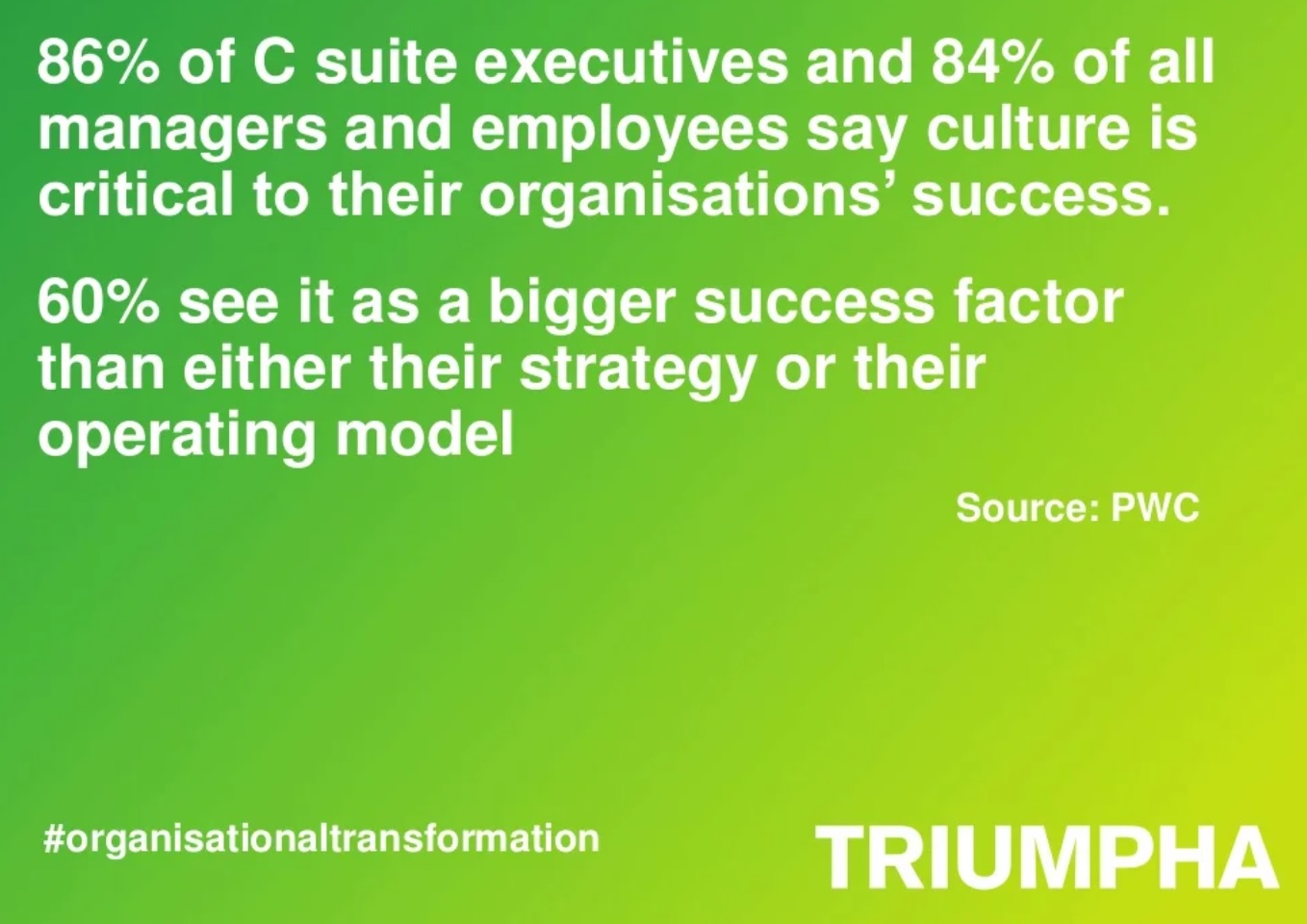
Consider Spotify, WL Gore, and even Microsoft recently when considering huge organizations that are successfully fostering agile and inventive cultures. If implementing change in your company seems difficult, take these things into account:
Keep an eye on the situation and get to know your customers well.
Frontline staff members, who work directly with consumers on a daily basis, can offer insightful first-hand information about the outside world. Encouragement of their viewpoint on consumer demands, attitudes, and perceptions of your goods and services in comparison to rivals might yield insightful information. The information you receive may not always be what you want to hear, but it is nearly certain to be what you require. And paying attention is crucial.

Case Study: Work the Organization’s Edges
Transformational leaders always consider what their organizations should turn into, planning for the reactions and adjustments that their team members and clients will make. The pandemic has showed us how rapidly attitudes and behaviors can change, frequently permanently, therefore proximity is essential. “To me, what drives innovation is proximity,” said Xavier Rolet, who oversaw the restructuring of the London Stock Exchange, which saw its market value rise from $1.1 billion to $19 billion in eight years. “A really close relationship with your customers, understanding their deepest challenges, and they are not going to tell you what their deepest challenges are unless they really trust you and know you.”
Show, Don’t Tell
It’s fine to share information with staff about consumer feedback or competition activities, but in our experience, involving people on an emotional level is much more likely to spark momentum. Allowing staff to experience it firsthand has a much bigger influence on fostering an outward perspective than lecturing them in a PowerPoint presentation.
Take into account the movement and force for change that has been sparked by recent BBC and other videos about the presence of plastic in the oceans. When we encounter something like this, we often react emotionally, and that is where the motivation to act—small steps today, perhaps, but change nonetheless—really comes from.
Honesty Is Best
It can be tempting to withhold information regarding business failures from employees, as is frequently the case in large corporations. Why would anyone do that when bad news lowers share prices? This isn’t reality, though, and it ultimately leads to a situation that is significantly worse over time, a sudden corporate catastrophe. Do I need to bring up Carillion at this point?
An urge to act quickly is one thing, but allowing that urge to develop into fear or anxiety is quite another. The latter will neutralize all gains.
Staff members can feel in charge of their future when there is an outward-looking, open, and communicative culture developed and nurtured. According to our experience, innovation and agility follow naturally after that. And in these quickly evolving times, that might come in extremely handy.
Increasing The Pace Of Transformational Change
However, there are several steps you may do to make it go faster. For instance, set up a strategic change office (SCO), develop a clear, inclusive strategy, ensure organizational alignment, offer skill development, and—most crucially—involve people in the change process.
1. Create an office for strategic change
By creating a strategic change office (SCO), you can put change in its rightful strategic location inside your company and put the change management leader on an equal footing with the CFO, CMO, CIO, and other top executives.
The SCO may assist in bringing about revolutionary change inside your business by ensuring that the proper tools, techniques, and personnel are used to achieve success. Additionally, it can enhance the outcomes of specific change projects and promote long-term agility to manage future change.
Make sure you choose a diverse set of individuals to represent all facets of the company on the change leadership team. This group will promote change in each of their specialized fields.
“Progress is impossible without change, and those who cannot change minds cannot change anything.” – William George Shaw
2. Create a clear, all-encompassing approach
Create and share a clear strategy that details the ways you are using to make changes and the objectives you have established (both top-level and department-level).
Continue to emphasize the reasons behind the changes, and include your team in all planning and discussion stages to ensure that nobody feels left out.
3. Promote alignment within the company
Everything undergoes change. It is similar to a Rubik’s Cube, according to the Society for Human Resource Management. Even if you concentrate on making one side of the cube a solid color, the messiness of the cube will persist if the other sides are still disorganized.
Your business is the same.
At the executive or departmental levels, your plan can be altered. Change management, however, won’t take place uniformly throughout the firm if the individuals charged with carrying out the strategy are not in alignment. These advice on achieving team alignment will help.
4. Help people develop the abilities they need to accept change.
The majority of workers are terrified of change either out of concern for their job security or out of a fear that they won’t have the necessary skills when the shift occurs.
All employees should receive required personal and skill development so they are prepared for whatever comes next.

Case Study
Think about a bank that learned its sales per banker were below the industry average. When asked “Why are revenues per banker lower?” its officials took the conventional, process-based route and discovered that bankers were not spending enough time with consumers. They then enquired as to why bankers weren’t spending more time with customers. They discovered that bankers spent a large amount of time filling out paperwork.
After making their diagnosis, the bank’s executives set out to redesign the loan origination procedure to cut down on paperwork and increase customer-facing time. To help bankers make the most of their extra time with consumers, they also gave them new sales scripts and simpler-to-use tools. Leaders believed the issue was resolved after training the bankers and distributing the equipment. Six months later, customer interaction time had barely changed and revenues had barely increased.
In light of this, the bank’s executives started to inquire “why” once more. Why wasn’t the new method effective?
The bank’s executives learned through focus groups with bankers that majority of them found client interactions awkward and preferred paperwork to people. When the leaders asked “why” again, they discovered that many bankers were reticent, lacked social skills, felt inferior when interacting with clients who had more money, and viewed salespeople as amateurs rather than professionals. Additionally, because their managers—who were primarily former bankers—were also nervous, they prioritized paperwork above people.
No new method was obviously going to succeed as long as bankers’ mindsets remained so in opposition to the fundamental objective of spending more time with clients. As a result, the bank’s leaders completely redesigned their change management strategy, adding training in personality type awareness, developing emotional intelligence, and shifting bankers’ perceptions of what it means to be salespeople from “pushing products” to “helping customers discover and fulfill their unarticulated needs.” Customer-facing time and sales improvements were back on pace after six months. The bank eventually achieved a 43 percent rise in bankers’ cross-sell ratio compared to a target of 20 percent, considerably outperforming its goals.
5. Make your group the change-makers.
People must be engaged in transformative change because it affects them directly in order to win their support. The better the results, the earlier you involve your workforce in developing your transformation strategy.
You can involve your team early in the change process by using an enterprise conversation management platform. You can pose an open-ended query or give background information on the transformative change program by setting up an Exchange. Participants can grade one other’s responses and ideas objectively and share their views anonymously.

Exercise 1.8: Tea Time
Start by forming small teams out of the gruup. Next, offer each team member a cup of tea or another beverage.
Ask them to taste their beverages now.
Invite them to come outside with their beverages after that.
Finally, tell them to consume their drinks and see whether there has been any change in how they feel or taste.
Have you ever noticed a difference in the flavor or feel of tea when you’re drinking it outside?
Where in the room, or outside, did you enjoy your tea the most? Why?
What lesson will you apply to your work as a result of this activity?

Course Manual 9: Resistance
Why Do Employees Oppose Change?
Management of change isn’t performing as it ought to. Leading proponents of radical corporate reengineering report success rates in Fortune 1,000 businesses are significantly below 50%; some believe they are as low as 20%, which is a striking number. The situation is all too common. Business executives frequently discuss customer value, downsizing, and comprehensive quality management. Plans for process improvements in customer service, production, and supply chain management, as well as for new organizations to meet the new processes, are implemented by determined managers. Management seeks dedication, acceptance, and excitement from subordinates. However, it receives less. Plans for implementation fall short, communication breaks down, and the outcomes are inadequate. We must consider why this occurs so frequently and how we may stop these failures.
Senior managers frequently underestimate the impact of this gap on their interactions with subordinates and the work necessary to obtain change acceptability. Managers at all levels must develop new perspectives in order to close the gap. In order to study the parameters of the “personal compacts” between employees and the organization and to comprehend how change seems from that perspective, they must put themselves in the position of their employees.
Personal Compacts
The relationship between employees and organizations is defined by their mutual commitments and inferred reciprocal obligations. These agreements are what are referred to as personal compacts, and proactive or reactive organizational transformation programs change their conditions. It is impractical for managers to expect employees to fully embrace changes that upset the status quo unless they define new words and persuade staff members to accept them. Disgruntled workers will destroy the reputation and well-laid plans of their supervisors, as outcomes all too frequently demonstrate. All companies’ compacts share three main characteristics. The formal, psychological, and social dimensions are these shared dimensions.
The formal portion of a personal compact is the part of the employment relationship that most people are familiar with. It summarizes for an employee the fundamental responsibilities and performance standards for a job as specified in corporate records including job descriptions, employment contracts, and performance agreements. From the perspective of an employee, comprehension the responses to the following set of questions leads to a sense of personal commitment to the company:
• What am I expected to accomplish for the company?
• What assistance will I receive for the job?
• When, how, and in what manner will my performance be assessed, as well as the format of the feedback?
• How will my salary be compared to how my performance is judged?
The psychological component of a personal compact deals with the majority of implicit components of the job relationship. It includes the components of shared responsibility and reciprocal commitment that result from the mutual dependence and trust between an employee and an employer. Employees assess their psychological commitment to the company along the lines of their personal compact by considering the following:
• How much work will I actually have to do?
• In exchange for my efforts, what kind of praise, compensation, or other form of satisfaction may I expect?
• Are the benefits worthwhile?
Employees evaluate a company’s culture based on the social component of their individual contracts. They take note of what the organization states in its mission statement regarding its values and watch the interaction between business operations and management’s attitude toward them. An employee attempts to respond to the following questions along the social dimension:
• Are my values similar to those of others in the organization?
• What are the true rules that govern who gets what in this business?
Block Change for Unrevised Personal Compacts
Employees frequently misunderstand or, worse, ignore the consequences of change for their individual obligations when seeing them through the lens of unrevised personal compacts. Employees at the Dutch-based Philips Electronics company failed to recognize how the environment was changing, which put the company in danger of going out of business.
A history of lifelong employment was a feature of the business culture throughout Philips’ booming years. In exchange for devotion to the organization and specific managers, job security was offered. Formal mechanisms for performance reviews and career promotion were mostly overruled by unofficial regulations and interpersonal interactions. The duties of managers were constrained by their job descriptions and hierarchy positions, and going beyond those bounds was frowned upon. Different encouragement wasn’t given to subordinates. People weren’t even attempting to meet the company’s difficulties, much less seeking personal development. Who received what in the company network was determined by position and perceived influence. Employees also had little motivation to work harder than those immediately above them or to go above and beyond their boss’s baseline expectations for performance because seniority was so strongly related to a worker’s ability to advance in their career and level of pay.
Because personal agreements between employees supported upholding the status quo, opposition to change was ingrained in the culture. Timmer, who took charge in May 1990, would need to penetrate the company deeply, take the initiative, and closely supervise it in order to effect a turnaround. The initial stage was merely to attract attention.

Case Study: Philips’ Shock Treatment.
Timmer’s strategy seemed dramatic; in actuality, it was shock therapy. Midway through 1990, shortly after taking over as CEO, he invited the top 100 managers of the business to a retreat away from the office at Philips’ training facility in De Ruwenberg. He used blunt language to describe the company’s predicament there, saying that its survival was in peril. He distributed a fictitious press statement declaring that Philips was insolvent to reaffirm the point. The group in the room had the responsibility of getting the firm back. Everyone would need to pitch in. The start of Operation Centurion signaled the end of the corporation as everyone in the room had knew it.
Timmer demanded a 20% overall reduction in headcount based on benchmarking data on best-in-class productivity. He also stated that despite significant cost reductions across the board, resources for critical new initiatives will have to come from inside. Performance would be evaluated in relation to meeting the goals and would be connected to individual bonuses and job prospects. The new personal compacts at Philips would be built on the principles of personal obligations, legally binding agreements, and performance requirements.
However, Timmer was aware that unless other managers and employees across the board shared his commitment to change, he would not be able to achieve his objectives. It was necessary to allay the worries of the staff about this corporate initiative. Plans to broaden Operation Centurion’s scope therefore evolved when its goals at the highest echelons of command came into focus. Senior managers and their business unit directors negotiated Centurion contracts; following that, this group approached the product-group and country management teams. Employees of all ranks discussed the effects and goals of change through workshops and training sessions. Timmer contacted employees via “town meetings” held by the business to address concerns and discuss the future. People responded well to his approach and were inspired to support him by his straightforward demeanor. It was soon obvious that workers were paying attention and that the business was evolving.
The workforce had been reduced by 22%, or 68,000 employees, by the end of 1991. Patronage, social networking, and lifetime employment in return for loyalty were all extinct, even at the top. Timmer brought in outside top managers when no one on staff met the qualifications. As a result, only 4 of the original senior-management committee’s 14 members were still in place by the middle of 1994, and only 5 of them were Dutch. Employee satisfaction with the reforms and the new environment was validated by a business survey conducted in 1994: Morale and sentiments of empowerment had skyrocketed. The financial performance of Philips improved significantly in 1993 and 1994 after varying over the early 1990s; operational income increased from (4.3%) of sales in 1990 to 6.2% in 1994, and the share price increased from 20.30 guilders to 51.40 guilders.
Culture and individual agreements
The extent to which personal agreements are written or oral depends on the culture of the organization and, frequently, the location where the company is headquartered. In general, the formal aspect of personal compacts is more likely to be implicit in cultures that are more homogeneous. In homogeneous environments, the same is true in terms of psychological and social elements because employers and employees have similar viewpoints and expectations. For instance, the legal systems for resolving conflicts are founded on a civil code that is codified in statutes in Japan and continental Europe. Both the underlying precepts of legal contracts and the presumptions that underpin employer-employee relationships are influenced by these systems. In Japan, it is actually considered an insult and a sign that one party doesn’t understand how things work when a contract is written out too precisely.
Personal agreements, on the other hand, are typically supported by formal processes in nations like the United States to guarantee objectivity in the standards for performance evaluation. Additionally, there is more structure in place to facilitate employee-employer relations, including in the form of firm policies and procedures as well as the function of human resource departments. Similar to this, as businesses become more truly global, it becomes more crucial to make the conditions of personal agreements plain and necessary to formally support them. This is true, whether businesses are making changes to address the demands of a culturally diverse staff or to address possibilities and challenges in the market.
Personal agreements will need to be more specific as businesses become really global.
Regardless of the cultural setting, businesses cannot achieve their objectives unless the modification of personal compacts is viewed as an essential part of the transformation process. Leaders need to take control of the process in some way and deal with each dimension. Employers’ personal compacts are revised by managers in a variety of ways and for a variety of factors. By redefining their employees’ commitment to new goals in terms that everyone can comprehend and act on, however, each drives effective corporate change. Employees will continue to be suspicious of the change vision and mistrustful of management without such leadership, and management will also be frustrated and hindered by employee resistance.

Exercise 1.9: Change Your Appearance
1. Explain to participants that they will participate in a change-related experiment. I wouldn’t bring up the fact that it’s a game. Get their buy-in in advance and get their consent to accept the adjustments until the experiment is finished. Assure them that the experiment will only last 30 minutes and that they won’t be required to participate in anything that makes them uncomfortable.
2. Assign participants to pairs, with each pair standing facing the other.
3. Request that the participants choose who will observe and who will make the modifications.
4. Inform the observer that their companion will be changing a few things, so they should pay close attention.
5. The observer in each pair should then turn away (or close their eyes) and instruct the other to make five adjustments to their outward look. This might entail switching their watch from one wrist to the other, taking off a shoe, removing their tie or jewelry, or taking off their spectacles. Give participants 30 seconds to make the necessary adjustments.
6. Participants may turn to face each other again with their eyes wide open and request as many adjustments as they can from the partner who did not make any. Give this a good 30 seconds.
7. Repeat steps 5 through 7 a couple of more times.
8. As a final exercise, have participants make ten adjustments in 20 seconds. It’s possible that you’ll encounter some resistance now. Stop speaking when vocal pushback begins, then switch to the discussion topics.
• How did it feel to have so many adjustments demanded of you?
• What are some factors that cause resistance to change in people?
• What can you do to make it simpler for employees in your company to embrace changes?
Start by answering the previous queries. Participants will eventually start referring to the adjustments made during the activity. When this begins, enquire about the following:
What type of support is required to keep changes going?
Get the participants’ commitment that they will keep any modifications until the activity is finished before giving them the directions for this exercise. Encourage everyone to consider and discuss their own feelings towards making changes.

Course Manual 10: Transformational Strategy
How to Implement a Transformational Business Strategy
The significance of transformational strategy is often discussed by executives and experts, who consider it as a key factor in guaranteeing long-term business progress. They contend that businesses must innovate at a basic level and make daring changes to the way they conduct business. Merely rebranding their goods or services or making minor adjustments to their current offering is not sufficient.
Although the idea of transformation is not new to the corporate world, it is now more important than ever for organizations to consider how to apply transformational tactics to promote commercial success. As a result, it is not unexpected that many businesses are searching for cleverer ways to focus more on their customers and strengthen their competitive advantage.
Although the idea of transformation may seem simple enough to implement, in actuality businesses must be highly deliberate in their approach. This professional guide examines transformational strategies and how to apply them to promote corporate expansion.
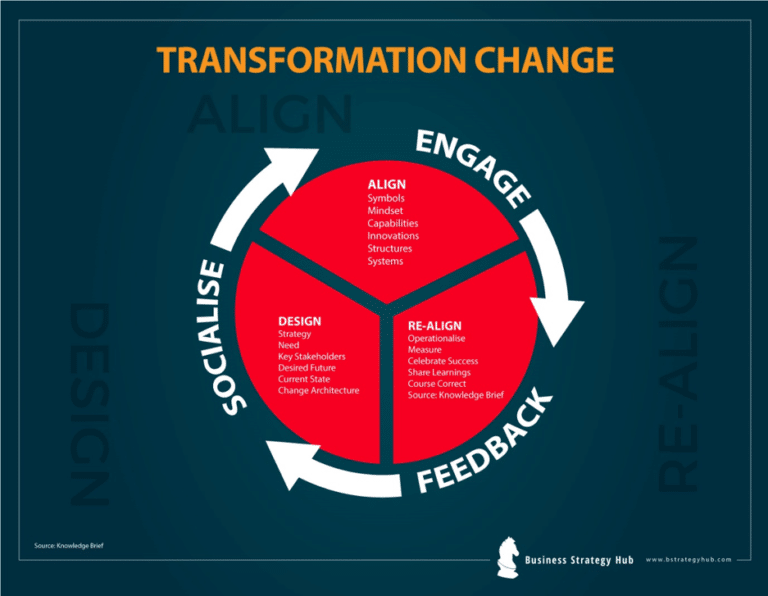
A transformational strategy is what, exactly?
Large-scale adjustments that are required to guarantee long-term success are referred to as transformational company strategies. The products, services, and overall business strategy of an organization are all affected, as well as the infrastructure, tools, and processes that are employed. Businesses need to consider their operations, products they bring to market, and associates they work with.
There is no one strategy that can be categorized as transformational; instead, transformational strategies vary from company to company depending on aspects including the industry the firm operates in and its core strengths. A transformational approach essentially calls for businesses to reconsider both what they do and how they do it. Organizations that use a transformational approach seek out opportunities to enhance their skills, stand out from the competition, and offer greater value and advantages to their clients.
To develop a clear vision of what the organization should be and do, detailed goals and objectives should be the foundation of a transformational strategy. All the stakeholders in a transformational strategy—including employees, managers, board members, and other crucial third parties like vendors, suppliers, and core customers—must have open communication and shared objectives.
Create a Transformational Strategy: A Guide
1. Recognize the mission and goals of your business.
First, you need to establish a precise vision and goal for your business. What are your goals for your transformation initiative, and what advantages do you anticipate from it? Answering these questions as completely and completely as you can will help to lead the transformation process moving forward.
2. Examine current and potential alternatives
Analyze your present company model thoroughly and identify the main areas that require adjustment. Take a close look at every part of your company’s operations, including your clients and their demands, the products or services you provide, who collaborates with you on what projects, and your workflow.
3. Identify Important Changes Required
Determine the main changes you want to make and rank them in significance. Don’t assume that all changes must be implemented at once. Consider the effects of each suggestion and how it will affect your company’s operations and revenue generation.
4. Create Your Transformational Strategy
Establish a transformational road map and figure out the precise measures needed to realize your goals. Your transformative plan should be comprehensive, taking into account both the smaller-scale interactions within the organization as well as individual positions. It can be required to form a special working group to examine every facet of your company, and then collaborate with that group to create the precise implementation strategy for all adjustments detected.
5. Put Your Transformational Strategy into Practice and Keep Track of It
It’s time to put all identified changes into action and include them into your entire company planning process. As you do so, be sure to be ready to continuously assess how your transformation activities are going. Because of this, you can evaluate the efficacy and development of your transformative plan.
Ideas for Transformational Strategies
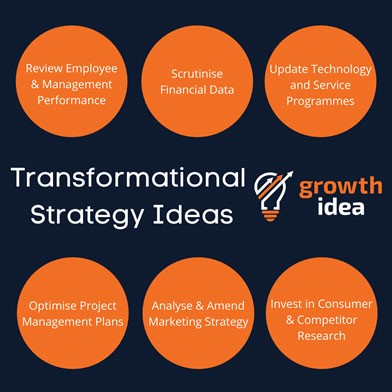
Analyze employee and management performance
Managers can use the transformative technique to encourage corporate growth by evaluating employee and management performance. Instead of focusing on problems or faults, reviews should highlight what employees are doing well, how they might improve, and what is impeding them. Managers should also try to provide constructive critiques for advancement whenever possible. A significant study found that transformational leadership can have a number of advantages, thus it is essential that all management staff are familiar with the operational methods.
Analyze financial information
Future decision-making may benefit from a review of the company’s financial information. Financial data on previous sales and expenses should be carefully examined in order to properly understand where money has been spent. This can help with budgeting and with figuring out which areas require more attention or resources.
endeavor to modernize services and technologies
Every firm must embrace modern technologies and service initiatives to succeed. Even if new technologies that were unheard of in the past are constantly being produced, businesses frequently upgrade their services and tools in a disorganized and delayed manner. By tackling this significant transformation in a flexible way, the firm may capitalize on new technology. This makes it possible for marketers to roll up focused, efficient programs that fully take advantage of developments to encourage growth and success.
Make a plan to improve project management
A well-crafted project management strategy helps you stay focused on the goals of your business while setting the tone and path of your project. Furthermore, it keeps your employees focused so they don’t ramble around aimlessly trying to complete a task. You could think that your business could perform better in this regard.
Analysis and revision of the marketing plan
If a business wishes to encourage commercial growth, it must have an effective plan in place. This plan’s initial phase will be to assess the current marketing approach and find any areas that need improvement. After this is done, the marketing team could start working on modifying these points to make room for new original ideas and strategies. The company can ensure that they are on the correct track and that their action plan is bringing them closer to growth by doing this.
invest in consumer and competitor research
Understanding what current clients currently want, need, anticipate, and desire is the first step in developing a plan that motivates them to buy from you more frequently. You can identify areas where your competitors are succeeding so that you can find opportunities to succeed where they are failing by analyzing their strengths, weaknesses, methods, and tactics.
In particular, it’s critical to give your consumers the attention they deserve and to give both qualitative and quantitative responses equal weight. You may, for example, ask your customers what they value most in terms of response time or product quality in a survey. You may even ask them to rate you based on certain traits like friendliness or a desire to go above and beyond. After collecting and analyzing this information, you can develop a marketing strategy that is in line with the preferences and needs of your target audience.
Analyze employee and management performance
Managers can use the transformative technique to encourage corporate growth by evaluating employee and management performance. Instead of focusing on problems or faults, reviews should highlight what employees are doing well, how they might improve, and what is impeding them. Managers should also try to provide constructive critiques for advancement whenever possible. A significant study found that transformational leadership can have a number of advantages, thus it is essential that all management staff are familiar with the operational methods.
Analyze financial information
Future decision-making may benefit from a review of the company’s financial information. Financial data on previous sales and expenses should be carefully examined in order to properly understand where money has been spent. This can help with budgeting and with figuring out which areas require more attention or resources.
endeavor to modernize services and technologies
Every firm must embrace modern technologies and service initiatives to succeed. Even if new technologies that were unheard of in the past are constantly being produced, businesses frequently upgrade their services and tools in a disorganized and delayed manner. By tackling this significant transformation in a flexible way, the firm may capitalize on new technology. This makes it possible for marketers to roll up focused, efficient programs that fully take advantage of developments to encourage growth and success.
Make a plan to improve project management
A well-crafted project management strategy helps you stay focused on the goals of your business while setting the tone and path of your project. Furthermore, it keeps your employees focused so they don’t ramble around aimlessly trying to complete a task. You could think that your business could perform better in this regard.
Analysis and revision of the marketing plan
If a business wishes to encourage commercial growth, it must have an effective plan in place. This plan’s initial phase will be to assess the current marketing approach and find any areas that need improvement. After this is done, the marketing team could start working on modifying these points to make room for new original ideas and strategies. The company can ensure that they are on the correct track and that their action plan is bringing them closer to growth by doing this.
invest in consumer and competitor research
Understanding what current clients currently want, need, anticipate, and desire is the first step in developing a plan that motivates them to buy from you more frequently. You can identify areas where your competitors are succeeding so that you can find opportunities to succeed where they are failing by analyzing their strengths, weaknesses, methods, and tactics.
In particular, it’s critical to give your consumers the attention they deserve and to give both qualitative and quantitative responses equal weight. You may, for example, ask your customers what they value most in terms of response time or product quality in a survey. You may even ask them to rate you based on certain traits like friendliness or a desire to go above and beyond. After collecting and analyzing this information, you can develop a marketing strategy that is in line with the preferences and needs of your target audience.

Case Study: Start With Something Simple But Important.
Understandably enthused about the promise, managers wanting to undertake a skills-based change frequently want to start with a loud bang. But it frequently backfires. Others are frightened by the thought of transformation, while it motivates others. As a result, folks who aren’t ready for change may frequently try to undercut your efforts if you make a big push at the beginning. Effective transformations rarely get off to a noisy start.
For instance, Procter & Gamble’s PxG initiative started as a single modest experiment and is now revolutionizing how digital technologies are used to tackle issues throughout the company’s research division. John Gadsby, who oversees the PxG program, stated: “At the beginning, there were just three of us working on a project: One in R&D, one in manufacturing, and one in IT”. “We knew that we could work together in a better way. Through experimentation and iteration we were able to reduce the time for a key process from weeks down to hours. That got our work noticed.”
Do not make the mistake of assuming that since you are starting small, what you are doing is not important. This was emphasized by Debbie Chamkasem, who assisted in guiding data giant Experian’s transition from a traditional technological architecture to the cloud, noting that despite Experian’s initial projects being tiny, they weren’t simple. She noted “Our first projects were low risk and quickly generated real business results, that helped us build word of mouth and got others excited to work with us.”

Exercise 1.10: All Abroad
Next, gather some blankets or tarpaulins and arrange them on the floor to represent a ship.
Now tell each group to remain on its ship for a while.
Then, ask them to board the ship again once it has been shrunk in size (by folding the tarp).
Every participant should make an effort to stay aboard their ship while this activity proceeds to shrink the size of the ship.
How did you plan this exercise as a team?
What obstacles did you have to overcome during this activity, and how?
Did you gain any knowledge that you can use in your actual work? Please elaborate.

Course Manual 11: Transformational Failure
Why Transformational Efforts Fail: Leading Change
More than 100 businesses have made an effort to reinvent themselves as much more competitive over the previous ten years. Large enterprises (Ford) and small businesses (Landmark Communications), American and international businesses (General Motors and British Airways), struggling businesses (Eastern Airlines) and profitable businesses (British Airways) have all been represented (Bristol-Myers Squibb). These initiatives have been marketed under a variety of names, including turnaround, reengineering, right-sizing, restructuring, and overall quality management. However, the essential objective has been the same in almost every instance: to fundamentally alter how business is performed in order to assist cope with a new, more difficult market situation.
Some of these corporate reform initiatives have had great success. Some of them were complete failures. With a clear lean toward the lower end of the spectrum, the majority fall somewhere in the middle. The lessons that can be learned are intriguing, and they most likely will be applicable to even more firms in the ten years to come as the business environment becomes more and more competitive.
The most general takeaway from the more successful stories is that the change process involves a number of stages that, taken together, typically take a substantial amount of time. Skipping steps simply gives the impression of speed and never results in a gratifying outcome. A second extremely general lesson is that crucial errors can have a disastrous effect in any phase, impeding momentum and undoing hard-earned achievements. Even very competent people frequently make at least one significant error, maybe because we have so little experience reviving organizations.
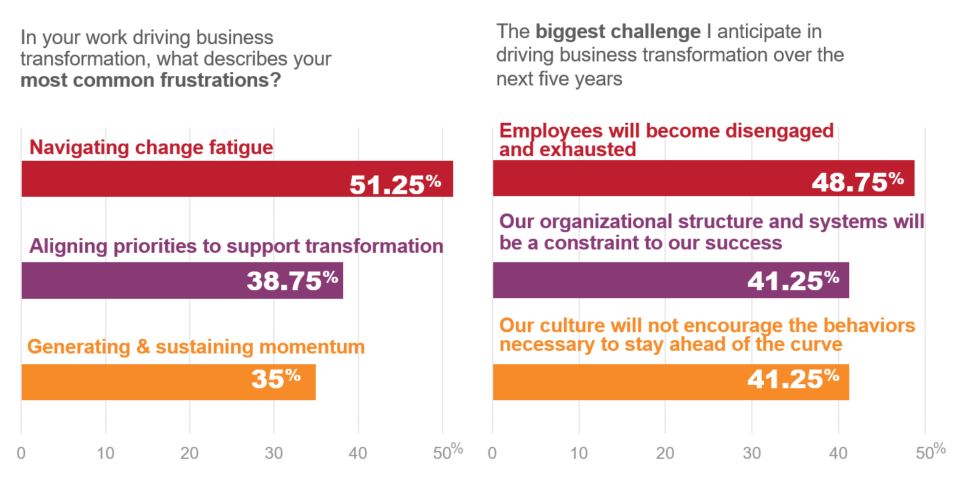
Lack of a Strong Enough Sense of Urgency
The majority of effective change initiatives get off to a strong start when some people or some groups start to closely examine a company’s competitive environment, market position, technical trends, and financial performance. They concentrate on the potential revenue decrease that could result from the expiration of a significant patent, the five-year trend of deteriorating margins in a core industry, or a growing market that everyone else seems to be neglecting. They then devise strategies for drastically and widely disseminating this information, particularly in the case of emergencies, potential crises, or enormously timely possibilities. This initial stage is crucial since it takes the aggressive participation of many people to even begin a change effort. People won’t assist if they aren’t motivated, and the attempt will fail.
Phase one of the change process may seem simple in comparison to later stages. Not at all. Over 50% of businesses fail during this initial stage. What caused the failure, and why? Executives occasionally overlook how challenging it may be to push others outside of their comfort zones. They occasionally vastly overestimate how effective they have already been at raising urgency. They can be impatient at times, saying things like, “Let’s get started; enough with the introductions.” Executives frequently become immobilized by the potential negative outcomes. They fear senior staff will become defensive, morale will decline, things will spiral out of control, short-term business results would suffer, the stock will decline, and they will be held responsible for the disaster.
Too many managers and insufficient leaders frequently result in a senior management that is immobilized. The goal of management is to maintain the current system running while reducing risk. By its very nature, change necessitates the development of a new system, which in turn necessitates leadership. Phase one of a renewal project often comes to a standstill until sufficient numbers of true leaders are hired or promoted into senior-level positions.

Case Study: FMC
Look for innovative ways to involve the workforce in the transition. It’s crucial to involve people in the planning process while preparing for significant change events. Employees are more inclined to support and even promote the change as a result, helping to create a sense of ownership in the change.
More than 150 FMC employees were selected by leaders to join the Change Champion Network in advance of FMC’s crop protection deal with DuPont. The group was formed to involve peers, respond to inquiries, and enthuse staff members about the company’s future. The organization was a vital source of information for other workers and acted as a conduit for leadership to get two-way feedback.
Lack of Building a Strong Enough Guiding Coalition
Major revitalization initiatives frequently begin with just one or two participants. When transformation efforts are effective, the leadership coalition expands over time. But when a certain minimum mass is not attained early in the attempt, little of value occurs.
Major change is supposedly impossible unless the organization’s leader is a vocal advocate. The chairman, president, or division general manager, along with an additional 5–15–50 people, come together and forge a shared commitment to exceptional performance through renewal in successful transitions. This group frequently lacks all of the most senior executives from the organization because some of them are first resistant to joining. However, the coalition is almost always rather strong in the most successful scenarios—in terms of positions, knowledge and experience, reputations, and connections.
The guiding coalition tends to work outside of the typical hierarchy by definition because it consists of individuals who are not senior management. Although it can be difficult, this is undoubtedly required. There wouldn’t be a need for a significant transformation if the current hierarchy was functioning effectively. Reform, however, typically necessitates activities outside of formal limits, expectations, and protocol since the current system is ineffective.
Lacking Vision
Every time a transformation project is successful, the governing coalition creates a vision of the future that is appealing to customers, shareholders, and employees and is reasonably simple to express. The statistics that are generally included in five-year plans are never the end of a vision. A vision expresses something that aids in defining the course that an organization must go. Sometimes a single person contributes the majority of the first draft. Initially, it is typically a little hazy. However, once the coalition puts in three, five, or even twelve months of effort, something far better comes about as a result of their rigorous analytical thinking and some daydreaming. A plan for realizing that vision is eventually created as well.
Without a clear vision, a transformation effort can quickly devolve into a collection of perplexing and unrelated projects that could lead the business in the wrong direction or in the wrong place. The accounting department’s reengineering project, the human resources department’s new 360-degree performance appraisal, the plant’s quality program, and the sales force’s cultural change initiative won’t add up in a meaningful way without a strong vision.
Failure to Remove Barriers to the New Vision
As the process moves further, successful changes start to engage a huge number of people. Employees are given the confidence to take risks, experiment, and think creatively. The sole restriction is that the actions must adhere to the general guidelines of the overarching goal. The outcome will be better the more participants there are.
A guiding coalition can inspire people to take action to some extent just by effectively conveying the new course. However, communication is never enough on its own. Obstacles must be removed for renewal to occur. All too frequently, a worker is aware of the new vision and wants to contribute to making it a reality. But it seems like an elephant is in the way. Sometimes the impediment is inside the person’s head, and the task is to persuade them that there isn’t any external opposition. However, the barriers are typically very real.
Organizational structure can often be a barrier because it can substantially impair productivity improvements or make it very challenging to even consider customers. People may occasionally be forced to choose between the new vision and their own self-interest via remuneration or performance-appraisal systems. Bosses that refuse to adapt and make demands that are at odds with the team’s efforts are maybe the worst.
Not systematically creating and planning for short-term wins
Creating short-term wins is not the same as hoping for short-term wins. The former is active, whereas the latter is passive. When a transformation is effective, managers look for ways to get noticeable performance improvements, set targets in the annual planning system, accomplish the goals, and reward the participants with praise, promotions, and even cash.
Managers frequently gripe about having to deliver quick victories, but pressure may be an effective tool in a transformation attempt. Urgency levels might diminish when people realize that significant change will take time. Commitments to deliver quick victories help maintain a sense of urgency and compel in-depth analytical thought that might clarify or update visions.

Case Study: GE
In 1960, Jack Welch began working at GE as a junior chemical engineer. He oversaw the successful commercialization of a novel plastic substance developed in the lab. GE had to construct a new production facility in order to produce new plastic material in large quantities. Jack Welch was appointed general manager of the new polymer products division by the company.
Suddenly, Jack was put in charge of marketing the novel product known as “Noryl” to unidentified new customers. His team had to consider prospective uses for the novel material, look into potential customers, get in touch with them, persuade them, persuade them to try a sample and experiment, persuade them of the benefits, and then persuade them to place a big order. It like creating a brand-new company from scratch. The journey was ahead of us. Jack faced a problem in sustaining his team’s enthusiasm and drive throughout the lengthy voyage. How did Jack act?
One of the motivational techniques: Jack and his team rejoiced when Noryl’s team delivered the first order. Following that, he celebrated the tenth order, twentieth order, and so forth.
A customer asked for a party after placing a $500 purchase for plastic pellets. On one of the “walls” of the office, he wrote “500 club” and displayed the names of those clients. Jack proclaimed a time of celebration for every tenth client as they added members to the “500 Club.” He was always looking for reasons to celebrate.
Likewise, he shared in the joy of his team whenever one of his subordinates or teammates received a promotion. Team members’ bonuses and promotions were other reasons to celebrate.
His staff worked enthusiastically. Noryl quickly established itself as a successful product, surpassing $1 billion in global sales in a short period of time. Jack established his company with success.
By 1981, Jack had advanced in his career to the position of CEO of General Electric. He increased the value of his business from $12 billion to $280 billion in less than 20 years. His unique, intensely individualized management approach revolutionized GE’s operations and the entire corporate culture.
Premature Celebration of Victories
Managers could be tempted to declare triumph with the first noticeable performance improvement after several years of arduous work. While rejoicing after a victory is appropriate, calling the war over can be disastrous. New strategies are fragile and prone to relapse until they become thoroughly ingrained in a company’s culture, which can take five to ten years.
Ironically, the premature victory celebration is frequently the result of a clash between change initiators and change resistors. The initiators go crazy in their excitement at a blatant indication of advancement. The resistors, who are ready to seize any chance to halt change, later join them. The triumph is cited by the protesters as proof that the war has been won and that the troops should be returned home after the celebration is finished. Troops that are worn out enable themselves to believe they have won. The foot soldiers are reluctant to board the ships once they get home. Then change abruptly stops, and tradition slowly returns.
Not securing changes to the corporate culture
In the end, a change only endures when it permeates the corporate body and becomes “the way we do things around here.” New habits are vulnerable to degeneration as soon as the incentive to change is lifted until they are ingrained in societal norms and widely held beliefs.
For business culture change to become institutionalized, two aspects are very crucial. The first is an intentional effort to demonstrate to others how the new mindsets, actions, and attitudes have enhanced performance. When people are left to draw the connections on their own, they occasionally develop correlations that are incredibly wrong. Communication is necessary to assist people in making the proper connections.
The second component is giving the new generation of top management enough time to truly embody the new strategy. Renewal rarely persists if the standards for promotion stay the same. A decade of diligent labor can be destroyed by one poor succession choice at the top of a corporation. When boards of directors are not a key component of the renewal effort, poor succession decisions may occur.

Exercise 1.11: Tag Team Games
Divide the staff into smaller groups to start.
Ask each member to then list their talents and skills that will assist the team succeed before sharing them with their teammates.
Now tell each group to combine all of those characteristics and skills to create a “virtual teammate,” and then write a brief profile about him.
In order for everyone to understand their own strengths and shortcomings, each team should share this information with the other teams.
How did you adjust to the novel situation throughout this exercise?
Did you sense the need to strengthen a skill or get over any weaknesses? Please elaborate.
What ability must you master if you are to deal with change?

Course Manual 12: Transformational Success
The findings from McKinsey’s most recent Global Survey, which builds on 15 years of original research on organizational transformations, support a tenet that has stood the test of time: a company’s odds of success increase with the number of transformational actions it undertakes. Success is still the exception rather than the rule. Even though we’ve known for a while that an all-encompassing strategy for organizational transformation is more likely to result in long-lasting change, the success rate has consistently remained low on the whole. Less than one-third of respondents, who had all participated in a change in the previous five years, claim that the transformations at their organizations were successful in raising organizational performance and maintaining it over time.
However, even businesses that have successfully undergone transitions don’t always reap the full financial rewards of their work. In order to identify where value is lost and what businesses can do to prevent it, we looked more closely at the various stages of a transformation’s life cycle. Our analysis shows that three fundamental transformational activities are particularly indicative of value capture, and that successful transformational organizations are more likely than others to adopt the particular strategies that underpin them.
The Potential Value Of Transformations
There are no shortcuts to success, according to the study results. The number of actions an organization took throughout the life cycle of an organizational transformation served as the primary differentiator between success and failure, rather than whether it adhered to a particular subset of actions (Exhibit 1).
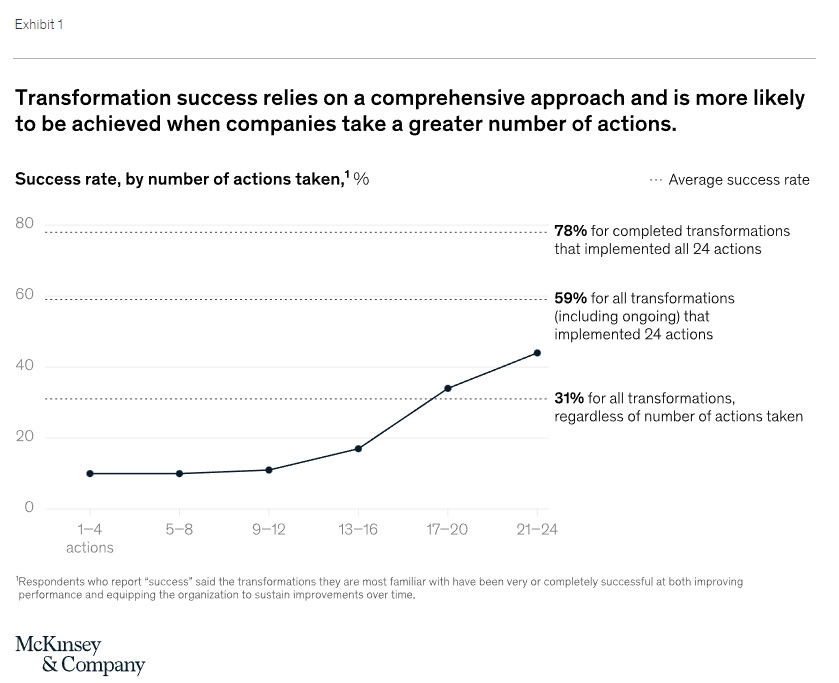
However, a company’s hard work is not finished even after the implementation phase. 20 percent of value is lost, according to respondents, after projects have been fully carried out and implemented. The findings imply that embedding transformation disciplines into business-as-usual structures, processes, and systems can aid in reducing this loss, and that this is a more frequent practice among transformations that are successful. Companies that have successfully transformed are particularly likely to have made significant changes to their yearly business planning procedures and review cycles, including executive-level weekly briefings, monthly or quarterly reviews, and individual performance conversations (Exhibit 3).
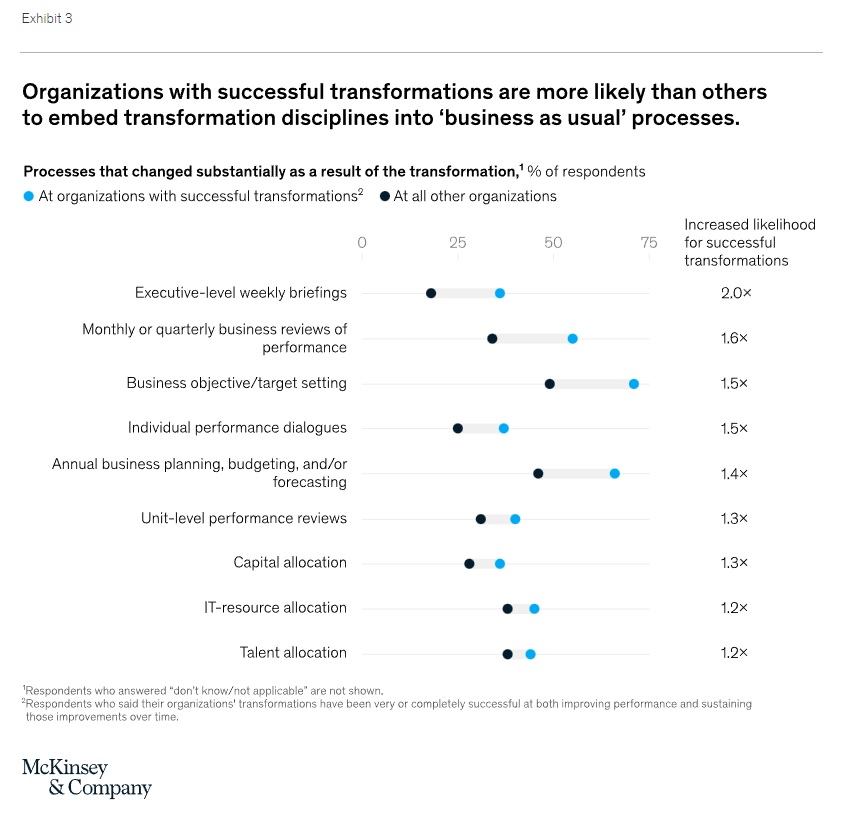
Does Our Thinking Need To Be Reframed Regarding Organizational Change?
Numerous statistics support the difficulty of implementing significant changes in the corporate environment. And the majority of us have probably seen the numerous headlines detailing failures (sometimes catastrophic) in both the public and private sectors.
We all agree that major change in large organizations is difficult, but I’d also contend that numbers are occasionally misleading. We also need to reevaluate our expectations and adjust the way we view change.
The ‘iron triangle’ of cost, schedule, and quality is still frequently used to gauge success. Cheap, quick, or good, as one of our team members likes to say. You may choose any two”
It is logical to a certain extent that schedule and expense are frequently the key concerns. They are simple to gauge. The problem is that these are frequently the worst actions that may be taken and can result in some terrible choices.
What does actual success look like?
Value is the only metric worth taking into account. In other words, what opportunities, competitive advantages, market positioning, cost savings, and so on will this shift provide for the company. What a no-brainer, right? Yet frequently everything is lost in the haze of scheduling, expense, and quick “concrete benefits”.
You might be familiar with the following instance:
1. Our concept is fantastic
2. We made a wildly speculative cost estimate. We underestimate because, allegedly, that’s what people do.
3. To get the funds approved, we reduce those estimates. They would never consent to the actual amount.
4. We create a monetary value to represent the advantages. Pure fabrication, but Excel presents it beautifully and everyone feels good about it.
5. Everyone prefers defined dates, so we do that. But at this point, we have no idea how long it will take to complete. Simply a detail, Still feeling fantastic
6. We’re just halfway done and it’s taking far longer than we anticipated and costing at least twice as much. Everyone is unhappy
7. It either gets discarded or reluctantly approved with additional project management levels. That causes it to move more slowly and increases the cost.
8. Everyone laments the failure and questions why it happened.
9. We seek out the guilty, condemn the innocent, and commend the innocent
Change is by definition an adventure into the unknown, and as any successful entrepreneur will attest, failure and success are inextricably linked. We must be willing to fail if we are to do something important; else, nothing helpful will take place. And as long as we keep moving forward, we’ll either advance or learn something new, both of which would constitute advancement. Learning faster than others around us is the key to staying in business.
If we can shift the way we think about change and accept it for what it is, we could discover that we are more adept at it than we initially thought.
What are Your Metrics for Success in Transforming Change?
When we state that “complete benefit realization should be the end goal of every transformational shift,” it seems so apparent. Duh! No doubt. But in our change management consulting work, we frequently observe businesses that, after a project reaches its “go-live” or “cut-over” date, pronounce it complete and, hence, successful. In actuality, though, going live has little to do with completing implementation! You haven’t “finished” changing.

This is referred to as “premature project completion.” When you finally launch, it feels fantastic and is a step in the right direction, but something is still lacking. Return on Investment!
The reality is that you won’t experience the financial and other benefits of the shift until you achieve sustained behavioral change. No change will occur unless people alter their behavior. That also doesn’t occur at launch! We say “No behavior change, no implementation” for this reason. That’s how easy it is.
Five Key Indicators of a Successful Implementation
You must first comprehend the distinction between installation and implementation in order to determine how well a transformative shift was implemented. Installation of a change satisfies three criteria:
• It’s on schedule;
• It’s within budget; and
• The technical goals are met.
We discover that the majority of businesses are excellent at implementing various adjustments. It makes sense why reaching installation fosters a sense of achievement. There is a lot going on, and some accomplishments have been made. The new personnel are in their roles, the new procedures are in place, and the lights are on. Some could respond, “It runs. It hums. So it is finished.
However, if you gauge the success of a transformational shift by the installation, you won’t have achieved persistent behavior change and a meaningful Return on Investment. Change is occurring on the surface.
Two other conditions must be satisfied for the implementation to be successful:
The human objectives and the commercial objectives
The human goals of a transformation are the new behaviors that the Change Targets will adopt as a result of the Future State Change. The financial investment in achieving an initiative’s business and technical objectives is typically far higher for organizations than the investment in achieving its human objectives. However, in order to obtain Return on Investment and declare a transformative shift successful, all five objectives must be met.
Full implementation should be the goal; nevertheless, this calls for certain adjustments from the leadership team as well. Budgeting is a requirement for leaders who want to get beyond installation. This entails modifying timelines and comprehending the resources that are needed.

Case Study: Pandora
In 2018, Pandora had three advantages while launching its transformation program. The first was the undeniable reality that the company was having trouble. This meant that staff didn’t question the necessity to function differently, which was clear to the management team. The two facilitators of successful transformations—management commitment and good communication—were added by Pandora to this external impetus.
The management team of the company spent a lot of time debating the change and deciding on its final form. The communications component of the program was condensed to three pillars and one primary KPI before being introduced to the organization: like-for-like sales. By making things simpler, Pandora ensured that everyone on staff would be able to comprehend and remember the transformation’s main objective. Once the transformation got begun, investor presentations, weekly emails, and internal town hall meetings all touched on it.
Program Now, the name given to Pandora’s transition, has gained momentum as a result of these solid practices. All of Pandora’s improvement initiatives are succeeding, with the majority focusing on topline expansion.
Other best practices are also being followed by the transition team. The first is the adoption of short-term projects whose outcomes can be readily assessed. This has the combined advantage of proving value to workers and enabling Pandora to alter direction if needed. The “value tests” that Pandora uses help it maintain its adaptability.
Customer centricity is another key component of Program Now; modifications are only made when customers notice a difference. Additionally, customer centricity results in a far stronger communications strategy that is based on consumer insights, more media exposure, and platforms with a wider audience. The success of Program Now has been greatly influenced by customer centricity, leadership alignment, and employee communication.
Four Ways to Reframe Your Success Definition
While completing your transformation projects’ installation successfully is unquestionably a “must-do,” your projects won’t reap the financial rewards that were cited in the business case until implementation is finished. Organizations must genuinely embrace a “implementation mindset,” which means there is a consistent vocabulary and alignment on what is necessary for implementation success, and that is measured by program benefit realization, to boost the possibility of implementation success.
You can handle the human side of change in a realistic, systematic, and rigorous way by using a sound change management approach, such as The Accelerating Implementation Methodology (AIM). Here are four AIM-based ideas to help you rethink how you measure the success of transformative change:
1. Change the emphasis from installation to implementation in the definition of project success.
2. Refrain from hastily dismantling the project and program infrastructure
3. Clearly specify human goals at the beginning of the project lifetime.
4. Offer formal and informal reinforcements, as well as consequences for poor performance and actual execution.
Don’t let confusion cause your company’s investment to fall into the installation trap. Instead, develop an implementation mindset to guarantee that every business transformation initiative achieves its full potential.

Exercise 1.12: Influential leaders
Project Studies
Project Study (Part 1) – Customer Service
The Head of this Department is to provide a detailed report relating to the About Transformation process that has been implemented within their department, together with all key stakeholders, as a result of conducting this workshop, incorporating process: planning; development; implementation; management; and review. Your process should feature the following 12 parts:
01. Transformation Importance
02. Transformational Models
03. Vision Process
04. Change Readiness
05. Emotional Journey
06. Change Engagement
07. Change Leadership
08. Transformational Barriers
09. Resistance
10. Transformational Strategy
11. Transformational Failure
12. Transformational Success
Please include the results of the initial evaluation and assessment.
Project Study (Part 2) – E-Business
The Head of this Department is to provide a detailed report relating to the About Transformation process that has been implemented within their department, together with all key stakeholders, as a result of conducting this workshop, incorporating process: planning; development; implementation; management; and review. Your process should feature the following 12 parts:
01. Transformation Importance
02. Transformational Models
03. Vision Process
04. Change Readiness
05. Emotional Journey
06. Change Engagement
07. Change Leadership
08. Transformational Barriers
09. Resistance
10. Transformational Strategy
11. Transformational Failure
12. Transformational Success
Please include the results of the initial evaluation and assessment.
Project Study (Part 3) – Finance
The Head of this Department is to provide a detailed report relating to the About Transformation process that has been implemented within their department, together with all key stakeholders, as a result of conducting this workshop, incorporating process: planning; development; implementation; management; and review. Your process should feature the following 12 parts:
01. Transformation Importance
02. Transformational Models
03. Vision Process
04. Change Readiness
05. Emotional Journey
06. Change Engagement
07. Change Leadership
08. Transformational Barriers
09. Resistance
10. Transformational Strategy
11. Transformational Failure
12. Transformational Success
Please include the results of the initial evaluation and assessment.
Project Study (Part 4) – Globalization
The Head of this Department is to provide a detailed report relating to the About Transformation process that has been implemented within their department, together with all key stakeholders, as a result of conducting this workshop, incorporating process: planning; development; implementation; management; and review. Your process should feature the following 12 parts:
01. Transformation Importance
02. Transformational Models
03. Vision Process
04. Change Readiness
05. Emotional Journey
06. Change Engagement
07. Change Leadership
08. Transformational Barriers
09. Resistance
10. Transformational Strategy
11. Transformational Failure
12. Transformational Success
Please include the results of the initial evaluation and assessment.
Project Study (Part 5) – Human Resources
The Head of this Department is to provide a detailed report relating to the About Transformation process that has been implemented within their department, together with all key stakeholders, as a result of conducting this workshop, incorporating process: planning; development; implementation; management; and review. Your process should feature the following 12 parts:
01. Transformation Importance
02. Transformational Models
03. Vision Process
04. Change Readiness
05. Emotional Journey
06. Change Engagement
07. Change Leadership
08. Transformational Barriers
09. Resistance
10. Transformational Strategy
11. Transformational Failure
12. Transformational Success
Please include the results of the initial evaluation and assessment.
Project Study (Part 6) – Information Technology
The Head of this Department is to provide a detailed report relating to the About Transformation process that has been implemented within their department, together with all key stakeholders, as a result of conducting this workshop, incorporating process: planning; development; implementation; management; and review. Your process should feature the following 12 parts:
01. Transformation Importance
02. Transformational Models
03. Vision Process
04. Change Readiness
05. Emotional Journey
06. Change Engagement
07. Change Leadership
08. Transformational Barriers
09. Resistance
10. Transformational Strategy
11. Transformational Failure
12. Transformational Success
Please include the results of the initial evaluation and assessment.
Project Study (Part 7) – Legal
The Head of this Department is to provide a detailed report relating to the About Transformation process that has been implemented within their department, together with all key stakeholders, as a result of conducting this workshop, incorporating process: planning; development; implementation; management; and review. Your process should feature the following 12 parts:
01. Transformation Importance
02. Transformational Models
03. Vision Process
04. Change Readiness
05. Emotional Journey
06. Change Engagement
07. Change Leadership
08. Transformational Barriers
09. Resistance
10. Transformational Strategy
11. Transformational Failure
12. Transformational Success
Please include the results of the initial evaluation and assessment.
Project Study (Part 8) – Management
The Head of this Department is to provide a detailed report relating to the About Transformation process that has been implemented within their department, together with all key stakeholders, as a result of conducting this workshop, incorporating process: planning; development; implementation; management; and review. Your process should feature the following 12 parts:
01. Transformation Importance
02. Transformational Models
03. Vision Process
04. Change Readiness
05. Emotional Journey
06. Change Engagement
07. Change Leadership
08. Transformational Barriers
09. Resistance
10. Transformational Strategy
11. Transformational Failure
12. Transformational Success
Please include the results of the initial evaluation and assessment.

Project Study (Part 9) – Marketing
The Head of this Department is to provide a detailed report relating to the About Transformation process that has been implemented within their department, together with all key stakeholders, as a result of conducting this workshop, incorporating process: planning; development; implementation; management; and review. Your process should feature the following 12 parts:
01. Transformation Importance
02. Transformational Models
03. Vision Process
04. Change Readiness
05. Emotional Journey
06. Change Engagement
07. Change Leadership
08. Transformational Barriers
09. Resistance
10. Transformational Strategy
11. Transformational Failure
12. Transformational Success
Please include the results of the initial evaluation and assessment.

Project Study (Part 10) – Production
The Head of this Department is to provide a detailed report relating to the About Transformation process that has been implemented within their department, together with all key stakeholders, as a result of conducting this workshop, incorporating process: planning; development; implementation; management; and review. Your process should feature the following 12 parts:
01. Transformation Importance
02. Transformational Models
03. Vision Process
04. Change Readiness
05. Emotional Journey
06. Change Engagement
07. Change Leadership
08. Transformational Barriers
09. Resistance
10. Transformational Strategy
11. Transformational Failure
12. Transformational Success
Please include the results of the initial evaluation and assessment.

Project Study (Part 11) – Logistics
The Head of this Department is to provide a detailed report relating to the About Transformation process that has been implemented within their department, together with all key stakeholders, as a result of conducting this workshop, incorporating process: planning; development; implementation; management; and review. Your process should feature the following 12 parts:
01. Transformation Importance
02. Transformational Models
03. Vision Process
04. Change Readiness
05. Emotional Journey
06. Change Engagement
07. Change Leadership
08. Transformational Barriers
09. Resistance
10. Transformational Strategy
11. Transformational Failure
12. Transformational Success
Please include the results of the initial evaluation and assessment.

Project Study (Part 12) – Education
The Head of this Department is to provide a detailed report relating to the About Transformation process that has been implemented within their department, together with all key stakeholders, as a result of conducting this workshop, incorporating process: planning; development; implementation; management; and review. Your process should feature the following 12 parts:
01. Transformation Importance
02. Transformational Models
03. Vision Process
04. Change Readiness
05. Emotional Journey
06. Change Engagement
07. Change Leadership
08. Transformational Barriers
09. Resistance
10. Transformational Strategy
11. Transformational Failure
12. Transformational Success
Please include the results of the initial evaluation and assessment.
Program Benefits
Operations
- Real-time Accuracy
- Tasks Automation
- Employee Utilization
- Adaptation Capability
- Capacity Planning
- Systems Understanding
- Involved Commitment
- Rising Productivity
- Clear Assignments
- Streamlined Operations
Management
- Business Sustainability
- Process Improvement
- Seamless Transformation
- Stakeholder Management
- Achieving Excellence
- Collaborative Transformation
- Performance Improvement
- Engaged Workforce
- Increased Trust
- Shared Vision
Human Resources
- Change Culture
- Quality Decisions
- Scenario Thinking
- Shared Objectives
- Infrastructure Knowledge
- Mutual Benefits
- Transparent Systems
- Problem-solving Culture
- Management Processes
- Empowered Leadership
Client Telephone Conference (CTC)
If you have any questions or if you would like to arrange a Client Telephone Conference (CTC) to discuss this particular Unique Consulting Service Proposition (UCSP) in more detail, please CLICK HERE.



























